All the way back in early January at CES Polar announced the V800 multisport GPS watch. This would be their first multisport integrated GPS watch to market, combining the RC3 GPS watch along with the RCX5 non-GPS multisport watch. On top of that, they’d also be integrating in their Polar Loop activity monitor functions – effectively making a powerhouse of a fitness watch.
Since even before the announcement I’ve been using the V800, with now daily usage in the past couple months as it has neared release, which ultimately culminated last week in the first final software release. As such, I’ve got a pretty good idea on where things work, and where there may be a few holes in the story.
To be clear, Polar sent me over a V800 to start testing with until retail availability. Like always, I’ll be shipping that back to them in Finland in the next few days and going out and getting my own via regular retail channels. That’s just the way I roll.
Lastly, at the end of the day keep in mind I’m just like any other regular athlete out there. I write these reviews because I’m inherently a curious person with a technology background, and thus I try and be as complete as I can. But, if I’ve missed something or if you spot something that doesn’t quite jive – just let me know and I’ll be happy to get it all sorted out. Also, because the technology world constantly changes, I try and go back and update these reviews as new features and functionality are added – or if bugs are fixed. So – with that intro, let’s get into things.
Unboxing:
The V800 comes in two flavors. That with a heart rate strap, and that without a heart rate strap. Down the road, it’ll also come in a blue flavor.
In the meantime, I’ll go ahead and show you the unboxing for the model with the heart rate strap. In putting this together, the box I had is from a few months ago – so it’s plausible it looks slightly different than the final boxes. No worries though actual contents are the same.
Inside the packaging you’ll find the heart rate strap, heart rate strap pod, USB charger, and then the watch still attached to the packaging.
Take everything out, and here’s your package.
Looking at the pieces briefly, the heart rate strap included is the H7, which is Polar’s Bluetooth Smart + Analog transmission for underwater usage (and gym equipment like treadmills).
Next, the USB charger will snap onto the V800 like a clamp. The other end will connect to your computer.
Finally, the watch itself:
And, here’s the back:
Button-wise you’ve got five to work with. On your right side will be page up and page down, and then the red button is for starting, laps and selecting/confirming objects in the menu.
While the left side is for the light (plus a menu while running), and then the back button (which pauses/ends the workout).
Now that everything is unpacked, let’s hit up the size and weight comparisons.
Size & Weight Comparisons:
Above, you’ll find all the major units in the high-end multisport market today, plus a few others that are relatively recent.
From left to right: Garmin FR910XT, Adidas Smart Run GPS, Suunto Ambit2, Polar V800, Garmin Fenix2, Suunto Ambit2 R (and Ambit2 S), Timex Run Trainer 2.0, TomTom Runner/Multisport, Garmin FR620, and finally the Garmin FR220.
As you can see the V800 is in the same ballpark as other watches. It’s a little bit skinnier (width and depth) than most other units, but still tends to be about the length:
Looking at past Polar watches that it evolved from, you can see it’s got a much sharper display, as well as overall sleeker design.
Thickness-wise though, it’s roughly the same as those:
When I give the watch a weigh-in, the V800 comes in at 82g, right inline with all the other multisport units on the market:
Fenix2 – 85g
Fenix1 – 83g
FR910XT – 83g
Ambit2 – 89g
*Note: Polar sent me a photo showing the official measurement on a super-fancy scale at 79.88841g. When I get a new unit I’ll re-measure. But at the moment, everyone is on the same scale, so to speak, with the above numbers.
Ok, now that we’ve got all the comparisons done – let’s start using the thing.
Running:
In many ways, the V800 is really at its best while running. That’s mostly because it’s essentially like taking the RC3 of the past and adding some customization. Plus, it is a watch after all (versus a cycling head unit). Which is to say that if you’re a pure cyclist, I’d be looking at other options (potentially Polar’s V650 in the future). Whereas if you’re purely a runner (non-multisport), then the V800 is still a very viable unit.
With that in mind, the first thing you’ll want to do is pair up the sensors (such as your heart rate sensor). You’ll do that in the general settings area. I’ve got an entire section dedicated to sensors a bit later, so I’ll hold off on all the details till then.
Next, depending on where your watch was shipped from you’ll want to change the date/time. Unfortunately, the V800 doesn’t gather your current time based on GPS (like most fitness watches do). It only takes about 10-15 seconds to change it, but it would be a nice feature (or, to sync to your phone’s time instead like most activity trackers do).
With all that set you’ll press the red button. This will bring you to the screen with your configured sport profiles. Sport profiles are basically modes that you can configure for a slew of different sports. While you can’t create your own sport (Cow Tipping), you can choose from a huge list of sports and then tweak all the settings.
Only modes that you’ve created/configured will show up on the watch. In my case, we’ll use the up/down buttons to get to the Running mode. Once you’ve done that it’ll go ahead and initiate the search for any sensors. Within the context of running that would be the heart rate strap and running footpod (both are optional). You’ll see little icons displayed on the screen once connected, and in the case of the heart rate – you’ll see your BPM value displayed:
While the unit is connecting to the sensors it’s also searching for GPS signal. In my testing I’ve found the GPS acquisition time acceptable but not great. It doesn’t appear to pre-cache satellites like all other fitness devices on the market for the last 1-2 years do.
So sometimes GPS acquisition takes a minute or more. If you start in the same place as you last stopped however, it’ll tend to find it in a few seconds. Here’s an example video showing the acquisition time, which in this case was about 30-40 seconds depending on where you measured the ‘start’ from. The unit had been turned on earlier in the day in the same locale.

For comparison, here’s at the exact same spot and time (same run) the FR15 and FR620’s acquisition times.
With GPS all ready, you’ll go ahead and press start.
I do want to point out to definitely wait for GPS acquisition to be found before you start running. If you don’t, it’ll take much longer and you won’t get accurate data (distance/pace/etc…). After pressing start it’ll bring you into your configured data pages.
Assuming you don’t have a footpod your pace and distance will come automatically from GPS. Again, a footpod is NOT required to get speed/distance/pace while outdoors (that’ll come from GPS).
While running you can change the viewed data pages at any time by pressing the up/down button. You cannot however re-configure those pages (only online via computer). Each page can have up to four pieces of data on it (again, configured online). Here’s a handful of screens from various runs:
You can change the screen display during activities (but not in regular watch mode) to either be white text on black background, or the inverse:
Since I mentioned the footpod a minute ago, let’s talk about that in more depth. Officially known as the ‘Stride Sensor’, the running footpod allows you to get cadence information (indoors/outdoors), as well as pace/distance information when indoors.
The Polar variant of the footpod is unfortunately the size of a Twinkie, and the largest in the industry.
Now, there are some things to be aware of with the footpod. First is that like past Polar units, the footpod will override any GPS pace/distance data. There is no option to change that. What there is however is an option to determine whether the unit will automatically calibrate the footpod at the start of each GPS run, or, whether to use a set calibration value. This is configured within your sport profile (running in this case):
For me however, it never seems to automatically calibrate anything (with both the Polar BLE footpod and other footpods). Rather, it just sticks to some unknown value. As a result, my distances are off. What’s unfortunate here is that the common industry thing to do is to take cadence from the footpod and then pace from GPS (unless you lose GPS in a tunnel). Or, to offer a configuration option as to which source to pull from.
In any event, the footpod can then be used for indoor running to get pace and distance while on a treadmill (per the calibration values set). Note that the V800 does NOT gather cadence from the wrist like most newer running watches, nor does it do pace indoors on a treadmill like most newer running watches. At present, that’s not on the planned features list – though technically speaking the unit has the hardware to be able to do it.
Assuming you do have the footpod however, you’ll see cadence displayed on the unit, as well as stride length:
Further, you’ll see this data afterwards on Polar Flow.
Next when it comes to instant pace the V800 is very smooth and yet at the same time responsive. Below is a video I shot that shows me doing one of my intervals from last night’s workout. I started from the barely walking position and then accelerated up to pace. I initially turn a corner (90° onto a bridge), and then you see a slight slowdown as the bridge rises, before I stabilize the pace (and the bridge flattens out). There was no running footpod used/attached here, just pure GPS instant pace (shown in minutes/mile):

Next, let’s look at the workout functionality. The V800 includes some basic workout target modes that can be used. It does not have a separate/instant interval mode. These workout modes are all configured on Polar Flow (with computer) first, and then transferred to the watch for use during an activity. In my case, I created my Saturday long run workout on Polar Flow.
This had a main chunk, and then some intervals at the end. You can see how I’ve structured these here and even done a ‘repeat’ function within it:
Now, there are some downsides to the tool (via computer). First is that the only ‘target’ you can set is heart rate (+ distance or time). No pace/cadence/speed/etc… goals that are fairly common. Also, creating repeats can be a bit frustrating the way the tool is designed because it always wants to randomly select different segments to repeat. So it may take you 1 or 12 tries to get the repeats right. Eventually you’ll get it all set though.
Note that you’ll actually create workouts within the ‘Diary’ portion after selecting a given day and adding what’s called a “Training Target”. This too is fairly confusing since I tend to have a collection of workouts I use and don’t really think to associate them with a specific day. I wish this was just a separate section that I could easily get to and make workouts. Plus, “Training Target” doesn’t really convert into English as the idea for a pre-scheduled structured workout. Rather, most would think that would mean an end-goal (i.e. run 10 miles).
In my case, I set this one as a ‘Favorite’ so I can find it easily on the watch. Thus, once back outside I instead scroll down to favorites:
Then from there I selected my workout:
And with that it brought me to the usual page prior to a run. Once I press start, I’ll get a new page that indicates what I should be doing for each step. In this case, it shows a little HR bar that shows the zone I set for this step. Down below it shows how much time is remaining on this step:
This new page is in addition to any of your usual sport-defined pages. If you are above/below zone the unit will chirp and vibrate at you telling you that you’re screwing up. It’ll continue to do this until you get with the program.
Once you reach the next step it’ll automatically show you a new screen for that next piece. Note that it will not give you a count-down warning however (beep or display). It simply goes right into the next piece.
Now in addition to this custom workout mode, there are two somewhat simpler modes that you can create as well. The first is called ‘Race Pace Target’ and is basically like a virtual pacer. You specify the duration and distance, and it figures out the pace:
The above can be configured not only on the computer, but also on the watch at the last second:
And here’s how it’ll look during a workout, like a virtual partner of sorts. Shows you how far behind (5 seconds in this case) you are from the pacer, as well as your current pace and heart rate (along with the goal pace – 6:53 in this case):
The second is simply called ‘Quick’. In this mode you choose one metric and then it’ll void the other metrics out. Sorta like a goal.
This mode shows you a progress chart during the workout:
Next, whether you’re in a structured workout or a manual workout you can create laps at any time by pressing the lap button. Additionally, you can also configure ‘Tap to lap’, which allows you to whack the screen to trigger a lap. Tap to lap isn’t a touch-sensitive thing. Rather, it’s a whack-sensitive thing (accelerometer driven). Thus you need to give it a nice little thump to trigger a lap.
I have found though that tap to lap kinda doesn’t really work while cycling. The bumps in the road will constantly trigger it – so make sure you turn it off there and just use the buttons instead.
Further, you can also use automatic laps, which are separate (in addition) to manual laps. These can be configured for example for every 1-mile (or kilometer), and then will automatically show on the display, as well as afterwards in Polar Flow:
Note that if you need to pause the unit you can simply press the lower left button once to pause. You’ll hold down said button for three seconds to then end and save the workout. Note that in the paused mode you unfortunately can’t view your current distance/pages (I really wish I could, drives me crazy).
After you’ve saved the workout you’ll be given a summary screen that shows your activity totals, including recovery times:
This information is also available on Polar Flow afterwards. With that, I’ve covered all the running functionality. Let’s continue on to the cycling side of things.
Cycling:
The V800 can be used in a cycling mode, like most other multisport watches. In this mode you’ll get all the same functionality as in running, plus the ability to pair to other sensor types like cycling speed and cadence sensors – and down the road, power meters. Further, in this mode you’ll also get included information.
In order to minimize re-hashing everything I wrote in the running section – everything is essentially the same there. The core difference though is that now the metric will be ‘speed’ (i.e. MPH or KPH), rather than pace (minutes/mile).
Further, when you start a ride you’ll get a new little icon if you happen to have a Bluetooth Smart Speed and/or Cadence sensor(s). These sensors can be used not only outdoors with GPS, but indoors on a trainer.
Note that the V800 will override the GPS speed with your speed sensor speed. So if you have a speed sensor setup but not properly configured (i.e. wrong calibration value), then you’ll get inaccurate distance and speed.
On the cadence front, if you have a Bluetooth Smart cadence sensor, you’ll get cadence information while cycling:
From a cycling standpoint the V800 makes for an ‘ok’ cycling computer. I say that because there is no capability to remove the unit from its strap and quickly attach it to a quick-release kit. Rather, you’ll need to place it on some form of watch holder on your bike. You can do that with something like one of the $9 rubber blocks (in accessories section), or Polar’s ziptie solution. I personally prefer the $9 rubber blocks (even by other companies) because they don’t actually require zipties (you can use them if you want). Plus, I find them a bit more stable.
If you have a trainer, you’ll want to create/add an indoor cycling mode. In this mode you can turn off the GPS so it doesn’t try searching for it, then you can go ahead and use a speed sensor to get speed and distance. Without such a sensor you’ll only have heart rate data (or, cadence data if you have that too).
When it comes time to viewing things like cadence afterwards, these will show up on Polar Flow just like any other metric:
Note that as of this writing the V800 doesn’t yet support Bluetooth Smart power meters. That will come later, per the schedule down below in the section titled ‘The Future’. Prior to that Polar will release their Look/Keo Power System with updated pedal pods for Bluetooth Smart. That unit will join both the Stages Power Meter and PowerTap Bluetooth Smart power meter caps as the only direct force Bluetooth Smart power meters on the market. I don’t foresee any additional Bluetooth Smart enabled power meters in the near future from any other companies. (Updated: Added initial power meter support as of Sept 30th, 2014)
Swimming:
First and foremost – let me get this out of the way to minimize confusion: The Polar V800 at this time does not support swimming metrics such as distance or strokes (either in a pool or in openwater). It does however support heart rate in the water, as well as time recording. Updates for adding in that support are listed in my updates section a bit further down.
With that out of the way – what does work while swimming? Well, simply put: Heart rate.
The V800 continues the Polar tradition of being pretty much the only multisport watch on the market that can gather heart rate data while your body is underwater. It’s long been a Polar-specific selling point that is included in the V800 as long as you have a capable heart rate strap.
That would be the H7 specifically that’s capable of doing both Bluetooth Smart (above water), and analog (below water). The H6 however, will not work.
To start a swim session you’ll go ahead and select swimming from the menu. I’ve actually configured two swimming variants. One called ‘Aquatic Fitness’ and one called ‘Swimming’. Why two? Well, on the other one I set GPS to be enabled (more on that in a second) and changed some other settings. So I use the ‘Aquatic Fitness’ one in the pool and ‘Swimming’ one in openwater.
Once it’s found heart rate you can get to town swimming. The challenge for me though is that the heart rate strap simply won’t stay on my body. This is less of an issue for women since one presumes that they aren’t swimming topless. For men however, the water pressure can sometimes push the strap down depending on your body type.
I’ve tried all the most common tricks: Sliding transmitter pod to your back or side, twisting the strap a bunch, placing it higher or lower on the chest. No love.
Generally for me it’ll work in steady-state swimming. It’s just as soon as I hit the wall and push off that I lose it.
In talking with others, it tends to effect men who are a bit leaner than those who aren’t. In any event, that’s indoor pool swimming for ya. Again, at the time of this writing it does not currently track pace/laps/lengths/stroke. See the section below titled ‘The Future’ for details on that.
Next, comes to openwater swimming. This is basically the same as indoor swimming, except outside. You’ll just get heart rate data, that’s all.
Of course, I knew many of you’d wanted to know what happens if you enable GPS on the unit in swimming mode (which you can do). So, I went out and tested it.
Or rather, I tried to. Until I ended up in the hospital.
But, then I went out again the next day and tested it…for real this time. I’ve continued testing it a bunch of times over the past few months, including on the most recent firmware this past Thursday.
This test is likely the easiest to illustrate what the GPS track looks like when left on:
Here’s the actual track as measured by a different GPS device in my swimcap (red swim track both above and below):
To compare, the distances are:
Polar V800: .68 miles
Reference distance: .50 miles
The reason for this is that the Polar V800 does not yet have an openwater swim mode. And thus the unit loses GPS reception each time your arm goes under the water and then tries to re-gain it each time above the water. When it does that the accuracy of the GPS location can vary significantly. In order to alleviate that, Polar will need to add an algorithm that attemps to guess where you’re going, like watches from Garmin, Suunto and Bryton have. In most cases, those watches tend to get it within about 10-15%.
Obviously, it should go without saying that based on the features in the product today – the V800 isn’t really a swimmer’s watch. Down the road, perhaps, but not today.
Finally, I do want to note that for reasons unclear to either me or Polar, my watch seems to lose the HR connection as soon as the strap goes underwater. I’ve tried a multitude of H7 straps without success (including brand new out of box) on a number of firmware versions. That said, I’m reasonably certain this is simply a defect with my specific unit and not widespread since other readers have reported no issues with this functionality and it’s something that sorta falls into the camp of ‘it normally just works’. Polar is sending over another unit to have me test on that, so I’ll update this paragraph once that comes in later this week.
Preemptive notifier: See the section at the end titled “Updates & The Future” to validate that things in this section haven’t changed since I wrote this post – specifically in relation to the swimming piece.
[Update Note: July 8, 2015 – Today Polar added Open Water Swimming features (distance & stroke) to the V800; and these metrics are now also available in the Swimming profile for indoor swimming]
Triathlon & Multisport Use:
The V800 today includes a multisport mode, which allows you to easily change sports and record those sports in succession (as well as the transition times between them). I’ll explain the overall concept of how it works in a brief moment, but first I want to be really clear about two specific things:
1) As of today the V800 swim metric support is limited. I can’t use it to track openwater swims (aside from my heart rate), and I can’t use it in the pool to track distance/stokes/metrics.
[Update Note: July 8, 2015 – Today Polar added Open Water Swimming features (distance & stroke) to the V800; and these metrics are now also available in the Swimming profile for indoor swimming]
2) There’s no quick release style mount. This means it’s going to be on your wrist the entire time. For some that’s OK, but for most serious triathletes the inability to see your watch while in aero position is a letdown. You’d be required to put it on a separate mount and take care of that in transition (T1 & T2).
I say that because approximately 48.2% of all comments I receive seem to be on the issue of #1. So, I’m kinda going for the brute-force repetitive approach here to ensure it’s really clear.
With those limitations noted, you can indeed use it in a multisport event, and it’s silly easy to do so. To start, the unit includes what’s called “Free Multisport” mode, which allows you to basically go all free-wheelin’ between whatever sports you like. Linking them together like a chain of sausages. There’s also a regular multisport mode as well that I’ll cover in a second.
After starting this mode it’ll then ask you to select your first sport. At this point it’s really just like completing a single-sport activity. Any of the views/configuration settings/sensors that you’ve setup for that particular sport profile will be there just like normal:
Once you’ve completed flailing around in the water (as was my case), you can then tap the bottom left button (normally used as pause), to change to the next sport. In this case Polar allows you to simply scroll through your sports and choose whatever sport you want to begin. So, you’ve got some flexibility:
The only downside to the ‘Free Multisport mode’ is that that if you have a ton of sports saved it may take a second or two and you may have to briefly concentrate (which, can be tricky in a triathlon). However, there’s a regular fixed mode I’ll talk about in a second.
During the time while you’re choosing your next sporting venture, it’ll be tracking your first transition time. It’ll continue tracking transition time until you press ‘go’ on that next sport.
Once you’ve pressed go it’ll start that next selected sport just like normal.
You can continue to iterate sports like this as long as you darn well want. Over and over again, if you’d like. You’ll get a page on your data fields which has the ‘total’ time for the activity – listed as ‘Tot’.
Finally, once you’re all done you’ll tap that bottom left button to get back to the ‘next sport’ screen, and then from here you’ll hold down the bottom left button to stop the unit altogether and save the workout (just like normal).
Once it’s done it’ll show you a summary of your workout segments, but then allow you to pull open individual sports and look at those just as if they were their own standalone segments:
The implementation here of the history function is actually really well done and thought out. I like it.
In the event you add the ‘Triathlon’ sport profile to your watch (in addition to Free Multisport), then you can configure the modes ahead of time on Polar Flow. This allows you to just advance seamlessly between the different sports without having to choose them (more appropriate for races).
Lastly, after uploading your workouts to Polar Flow you’ll see everything on a single page. This is a bit different from Garmin, which splices out the different sports into specific activities (i.e. one for swim, one for bike, one for run) – with no total triathlon time.
There are pros and cons to doing either approach. From an analysis standpoint it actually tends to be easier to analyze each sport individually (Garmin approach), whereas from a holistic race perspective that can only be seen with the Polar approach.
On Flow, each of the sports are shown along the top on the graph:
Overall, I found the multisport function seemed to work out great for me. No specific issues with the implementation on the device, though, as you can see above the Flow site information is a bit thin at this point (I suspect that’ll improve over time).
Preemptive notifier: See the section at the end titled “Updates & The Future” to validate that things in this section haven’t changed since I wrote this post – specifically in relation to the multisport piece.
Data Field Options
The V800 allows you to customize your data pages online with Polar Flow using a computer (you cannot currently do it via the device or the phone app). However, the tool works quite well and is very easy to use, so I have no complaints.
You can create up to 8 custom pages of data per sport profile, with each page having 1 to 4 pieces of information, as seen above. Below is a table of all of the data fields you can currently choose/configure to add to the above pages:
Polar V800 Data Fields
| Time Fields | Environment Fields | Body Measurement | Distance | Speed/Pace Fields | Cadence Fields | Power Fields |
|---|---|---|---|---|---|---|
| Time of day | Altitude | Heart Rate | Distance | Speed/Pace | Running/Cycling Cadence | Power (Instant) |
| Duration | Temperature | Calories | Lap Distance | Average Speed/Pace | Avg Running/Cycling Cadence | Average Power |
| Lap time | Total Ascent | Average Heart Rate | Last Lap Distance | Maximum Speed/Pace | Current Lap Running/Cycling Cadence | Lap Max Power |
| Last lap time | Current Lap Ascent | ZonePointer | Lap Speed/Pace | Average Stride Length (Running) | Lap Left/Right Balance Avg | |
| Total Descent | Maximum Heart Rate | Lap Power | ||||
| Current Lap Descent | Time in Zone | Left/Right Balance (Instant) | ||||
| Incline | HR Avg in Lap | Left/Right Balanace Avg | ||||
| RR Variation | Maximum Power | |||||
| Maximum Force | ||||||
| Power Limits |
For the heart rate field you’ll choose a per-sport option of seeing the heart rate value in: Beats Per Minute (BPM), % of Maximum, or % of Heart Rate Reserve.
Again, these are all on a per sport profile basis, with the ability to configure a lot of different sport profiles (though at this time you can’t just create your own).
24×7 Activity Tracking:
The Polar V800 was the first multisport watch on the market to double as an activity monitor. This falls in line with Polar being the first activity monitor on the market to double as a heart rate strap (the Polar Loop). When people refer to an activity monitor, they’re talking about a device that isn’t used to track sport activities (like a run), but rather the other 23 hours of the day that you’re not exercising. So basically, your walk to Kentucky Fried Chicken and your mid-afternoon siesta. The type of activities that most normal non-endurance athletes enjoy.
The idea with activity monitoring is to give you a better understanding of how much activity you have outside of training – allowing you to put together a comprehensive view of your day to day work effort. For example, yesterday I walked about 8 miles while out doing errands in the city. Then, after doing all that, I ran another 11 miles. If I didn’t have an activity monitor on, I might not be able to quantify the full extent of my errands, which, might not allow me to understand why my run later that evening was a bit slower.
Now typically (as in the case of the Polar Loop), an activity monitor will tell you on the unit how many steps you’ve taken, distance walked, your progress towards the defined goal of the day (steps), and calories. It may also show a few other random things like time of day. Unfortunately, in the case of the V800 it only shows this single page:
It won’t show you steps walked nor distance. Just a bar graph without any numbers. What’s sorta frustrating here is that I identified this six months ago in my original post and noted that it made the activity monitor side kinda useless. Unfortunately, it wasn’t changed.
While you can sync to the phone to get steps – most would agree that defeats the purpose of having glancable information on the wrist (in part why units like the FitBit Force and Nike Fuelband are more popular than the Jawbone UP without a display). Ideally they’d just list the steps directly on top of that, or, allow me to add it to my home page. That’d be sorta logical (and what the Garmin FR15 does).
Once I connect it to my phone I do get the step counts there within the daily activity summary. This view comes in a giant donut. I’ve personally always found the layout a bit confusing, but it hasn’t changed yet:
Along the bottom I’ll get a breakout of total steps (plus distance if I tap that field) and calories for the day, as well as my total active time. Had I worn it sleeping that night I’d get that information as well. Personally I find the watch a bit too bulky to wear sleeping, but each person will differ of course.
You’ll also see inactivity alerts on the phone, but you won’t get these on the V800 yet. This will come down the road a bit (see the schedule in section titled ‘The Future’).
All of this information is then sync’d to Polar Flow (online) where it’s accessible there as well:
Overall I think this is a good first step on the activity monitor side of things. I just really wish I could glance and see my steps. Without that, I’m far less likely to wear it during the day (and thus, negating the value of that feature).
The end goal of what Polar is doing here is to create an all encompassing view of your fitness. In addition to the activity monitoring and regular sport recording, you can also do tests to both see how you’re recovering (Orthostatic test), as well as a fitness test. In the case of the Orthostatic test, Polar is measuring fatigue – and by doing these measurements regularly you can start to understand patterns and potentially base training on it.
The Orthostatic test is perhaps one of my favorite tests to complete, mainly because it involves hanging out on the couch:
Midway through the test it’ll go ahead and ask you to stand up (and do nothing). It’s measuring the impact of that on your heart rate – which in turn can allow it to determine fatigue. This is then pulled together into reports on Polar Flow:
Next you’ve got the status view you can look at the state that the unit believes you’re in from an overall recovery status:
Recovery status works by taking into account both your training load as well as your recovery, for the past eight days, and pulling together a single value for them.
Finally, do note that while the unit measures RR/HRV today, it doesn’t actually record the data to Polar Flow, thus you can’t quite use 3rd party utilities to analyze that yet (that’s coming though).
Navigation, Altimeter Accuracy, Battery Life:
The V800 contains many hardware features typically in a watch designed for hiking, specifically: a barometric altimeter, a magnetic compass, and the ability to get upwards of 50 hours of battery life in a low-power GPS mode. Now, while it has those hardware features, it generally lacks much of the software at this stage behind those features to realistically use it in a navigational capacity.
Barometric Altimeter:
To start with the most complete feature, we’ll take a look at the barometric altimeter. A barometric altimeter means that it uses pressure to understand elevation changes. This is generally considered the most accurate method for consumer sport GPS devices to measure elevation. Each time you start an activity the unit will use GPS to initially calibrate the barometric altimeter. This is inline with how most other units on the market work:
You can however manually override that value by holding down the upper left button and accessing the manual altimeter setting and simply setting a known altitude. This is useful if you’re at a location where the altitude is posted on a sign.
Once calibrated you’ll get altitude information during your activity. This comes in the form of current elevation as well as ascent and descent – essentially whatever you’ve configured on your data pages for that given sport profile.
Two weekends ago I spent considerable time in the Pyrenees doing barometric altimeter tests, looking at how different units faired. I was looking at total ascent and descent, as well as maximum elevation. Along with validation against known elevation markers. In the first category, here’s the V800 against a known elevation marker:
In this case, the marker was 1,490m (or 4,888.45ft). The V800 read 4,860ft. So pretty darn close – only about 30ft (9m) – inline with what I saw with other units (for example, the Edge 1000 read 4,869ft).
In the second category, here’s the total ascent/descent listed on the unit. In my case, I was looking for these to be nearly identical – since I stopped and started in the same place:
Again, pretty close – within 20ft. I’d be happy with that.
Note that when it comes to elevation, you’ll also get grade information displayed – but that’s currently only available in the cycling mode when the speed is fast enough to calculate the grade. It won’t show up in running, no matter how steep a hill you’re going up or down.
Navigation:
Next, we’ll look at navigation. The V800 includes some very rudimentary navigational capabilities allowing you to navigate to saved points of interest, as well as to follow saved routes using a compass. You’ll first need to calibrate the compass by waving it around like a crazy person:
Once that’s done you’ve got two choices. The first is to follow a pre-planned route downloaded from Polar Flow. The trick here is that as of today you can’t create your own route. Rather, you can only follow past activities you’ve created, or other public ones on Flow that other people have completed. Thus, for most people this will be kinda useless since you sorta already know where you went (if pulling from your own). Personally, I’m waiting for when I can just map out my route.
Nonetheless, if you save this route to the watch and load it up you’ll get a compass that will point you in the direction you’re supposed to go:
It’ll show you distance remaining and will be accurate based on which direction the watch is facing. For example, notice in these next two images how if I rotate just the watch face, the arrow stays pointing the same relative direction:
The second option is if you access the upper left button menu you can save a point of interest (POI), which then allows you to navigate back to that POI later on. Thus, ideally you’d save said point before you got yourself lost. Further, you can also navigate back to the start. It won’t be on the track you got there though – but instead will be as the crow flies. This means that if you’re hiking it’s not likely useful because you may have streams/cliffs/military checkpoints/etc in the way that would otherwise hinder a direct line of sight route:
In addition, you can retrieve your lat/long coordinates by simply holding down the ‘Light’ button (once in an activity with GPS enabled), and then scroll down to ‘Current Location Info’.
Overall, the features are super-basic in the navigation section. I hope over time we’ll see things get built out a bit more. At present, I can’t imagine many folks will find the navigational capabilities very useful, especially compared to more full-featured hiking/navigation watches like the Suunto Ambit series and Garmin Fenix series.
Battery Life:
The V800 has a few different battery life thresholds depending on how you’re using it. In day to day mode without GPS on, the unit is rated at 30 days before you need to charge it up again. For most though, you’re interested in GPS usage time. For that, the V800 includes two different GPS modes that can impact battery life. The first is a standard 1-second recording mode that updates GPS and records the values every one-second. This is the default and normal mode. This mode is rated at 13 hours of battery life with heart rate data (more on my testing in a second).
The second mode is an ultra-long battery mode designed for getting upwards of 50-hours of battery life. In this mode the GPS update is reduced to every 60 seconds (with HR data), thus resulting in less accuracy but far more usage time. This is generally best for hiking where you’re moving comparatively slowly. It’s not at all ideal for cycling where you’d be moving rather fast and thus the difference in 60 seconds would cut many corners (unless of course your riding across the US or something).
I’ve found in using the watch over the last 6 months that battery life was never a problem. In that I mean that there always seemed to be enough battery for my activities. Part of that might be my charging behavior, but it didn’t seem like it burned through battery, which is good.
In order to test the battery life I went ahead and plunked the unit on my rooftop and let it run with GPS on (in normal mode) from 100% battery down to whenever it shut itself off. Here were the results:
Interestingly, at 6% battery it basically ends the activity and goes into a safe-mode. In this case, it was at 18 hours and 53 minutes. Far surpassing Polar’s official estimates. However, there is one catch: There was no Bluetooth Smart enabled heart rate data (which is included in their numbers). With ANT+ creating a sensor simulator to run all night is really easy, but with Bluetooth Smart it’s a bit more tricky and I haven’t quite gotten them to work yet with the apps I’ve tried (it’s a me ‘limitation’, not really a Bluetooth or Polar one).
Still, that’s fairly promising when it comes to battery life. Whether or not it would last a ‘full Ironman’ time of 17 hours is something that remains to be seen. Hopefully I can rig up a simulator to better capture that.
Day to Day Watch, Backlight, Alarms:
The Polar V800 can (obviously) be used as a day to day watch. It contains the ability to set a single clock alarm, which can be configured to alarm every day, once, or just weekdays.
Further, you can configure/change the display on the front slightly to also include your name, which is kinda interesting. This appears to come from Polar Flow.
The backlight can be turned on by pressing the upper left button. It’ll stay on temporarily before turning back off. However, while in an activity you can force the backlight to remain on by holding down the upper left button and then setting the backlight to stay on. I prefer this for night running.
Alternatively, you can setup the backlight to activate from either tapping the screen or by touching the V800 to your heart rate strap sensor.
Finally, I found that I can indeed fit the Polar V800 under a dress shirt without too much issue. Thus, if you’re wearing it in such an environment it won’t be too hard to keep it out of view. Note that unlike other Bluetooth Smart connected smart watches (like a Pebble), the V800 won’t display any sort of Bluetooth Smart notifications (i.e. text messages or phone calls). Polar has noted that this is potentially possible, but as of now it’s not currently on the ‘futures’ list, however, be sure to double-check that section down below.
[Update note: As of April 15, 2015 the V800 can now support Bluetooth Smart notifications. Sadly, this anxiously awaited feature is only available on iOS 8.0 at this time, but they tell us Android support is coming ‘soon’. So, anyway, with this feature enabled you can get alerts from your iOS device about incoming calls and messages (such as calendar events, emails, SMS, and social media messages) displayed directly on your V800. You can set the watch to display the basic contents of a message, such as who a text message is from and the first 30-40 characters of said message.
If a call comes in you can see any available caller ID info and you can ‘Answer’ or ‘Silence’ the call. If you choose to Silence the ringer at that point (like when you are in a meeting with your boss and a call from your coach comes in), and then you can go further and ‘Decline’ the call, which effectively sends your coach to voicemail heaven.
And don’t be fooled by the ‘Answer’ option, you can’t hear or speak to the watch, all that does is answer the call in which case you need to slam the phone up to your ear or hope you are wearing earphones or some kind of handsfree device. And lastly, none of the notification features seem to be sticky at this point. All notifications (calls, messages, etc.) are only available on the watch for about 30 seconds, after which you have to fish your phone from your pocket (or your fanny pack) to check to see what other messages or calls you might have had come in since the last time you obsessively checked your phone. Update: July 8, 2015 – Polar added a Scrolling Notifications feature today, allowing you to ‘preview’ up to 4 notifications on your watch.]
[Update note: As of October 5, 2015 the long awaited Android compatibility for Bluetooth Smart notifications has finally arrived!]
Bluetooth Smart Sensor Support:
The V800 is the first Polar device to support Bluetooth Smart sensors. Previously, they’ve only supported them via their smartphone apps. As of this writing, the Polar V800 supports the following sensor types:
– Bluetooth Smart Heart Rate Strap
– Bluetooth Smart Cycling Speed & Cadence Combo Sensor
– Bluetooth Smart Cycling Speed-only sensor
– Bluetooth Smart Cycling Cadence-only sensor
– Bluetooth Smart Running Stride Sensor (footpod)
Later this summer, Polar will add support for:
– Bluetooth Smart Cycling Power Meters (Updated: Added as of Sept 30th, 2014)
Bluetooth Smart sensors have picked up steam, especially in the past 12-18 months. They are most popular in the heart rate realm, but are slowly becoming more common in cycling. I’d wager for running (footpods), they’re pretty rare – with most of that market going to ANT+. ANT+ is of course the massive incumbent when it comes to sports and fitness sensors, with most of the market currently on that protocol. ANT+ devices will not work with the V800. Neither will past Polar W.I.N.D. sensors, which aren’t supported with the V800. Nor will past Polar-branded Nike+ straps, or Bluetooth legacy (non-Bluetooth Smart straps) – Polar branded or otherwise.
The unit allows you to save a ‘pool’ of paired sensors. This is awesome, as it makes it super easy if you have a bunch of different sensors lying around (like me). It’ll automatically connect to what’s available.
Over the last 6 months I’ve been using a wide array of Bluetooth Smart accessories, both Polar branded and non-Polar branded. In my testing I’ve found that when it comes to Polar branded accessories things tend to work out just fine. However, I’ve found the situation rather fragmented when it comes to non-Polar branded Bluetooth Smart accessories.
For example, if I use the Wahoo RPM cycling cadence-only sensor, the V800 will incorrectly think it’s a combo sensor and override the GPS with a zero-value speed. Resulting in non-correct speed and distance values (0-MPH, 0-Miles). At the same time, if I use non-Polar footpods, it won’t calculate the stride length, nor does it seem to calibrate at all. There are other examples, which I’ve outlined below in the table.
Polar V800 Bluetooth Sensor Notes
| Sensor Name | Sensor Type | Tested by DCR | Tested by Reader | V800-specific Compatibility Notes |
|---|---|---|---|---|
| 4iiii's Viiiiva | HR, ANT+ to Bluetooth bridge | Yes | - | HR works. Bridge works for: SPD/CAD combo, SPD-only, CAD-only, but not power (yet), or footpod. On cadence-only, same bug as Wahoo RPM below. |
| Adidas Stride Sensor (Speed_Cell) | Running Footpod | Yes | - | Cadence works, but stride length & auto config does not, nor does jump test |
| Mio Alpha | Optical HR wrist sensor | Yes | - | HR works, but non-trusted HRV/RR support |
| Mio Link | Optical HR wrist sensor | Yes | - | HR works, but non-trusted HRV/RR support |
| PowerTap BLE Hub | Cycling Power Meter | N/A | N/A | V800 won't support Bluetooth Smart power meters till August |
| Scosche Rhythm+ | Optical HR armband sensor | Yes | - | HR works, but non-trusted HRV/RR support |
| Sports Tracker Cycling Sensor | Speed/Cadence combo sensor | - | Yes | All good! (per reader July 7th, 2014) |
| Stages Power | Cycling Power Meter | N/A | N/A | V800 won't support Bluetooth Smart power meters till August |
| TomTom Combo Speed/Cadence | Speed/Cadence combo sensor | No | Yes | Does not pair, does not work, tested as of firmware v1.0.10 (per reader July 5th, 2014). |
| Topeak Panobike | Speed/Cadence combo sensor | - | Yes | All good! (per reader June 9th, 2014) |
| Wahoo Blue SC | Speed/Cadence combo sensor | Yes | - | All good! |
| Wahoo KICKR | Cycling Power Meter | N/A | N/A | V800 won't support Bluetooth Smart power meters till August |
| Wahoo RPM (V1/V2) | Cadence Sensor | Yes | - | Cadence works, but V800 incorrectly overrides GPS with 0 speed |
| Wahoo TICKR | Heart Rate | Yes | - | No HRV/RR being sent over Bluetooth yet (coming in update) |
| Wahoo TICKR RUN | Heart Rate, Running Cadence | Yes | - | Cadence works, but stride length & auto config does not. Note with firmware 1.0.10 for the V800 and 1.5.18 for the TICKR RUN, cadence is now doubled, i.e. 184-SPM instead of 92-SPM. |
| Wahoo TICKR X | Heart Rate, Running Cadence | N/A | N/A |
Note that when you see me list “Non-trusted HRV/RR data” that means that it’s gathering the data via optical sensor. As of today, optical sensor technology is not capable of gathering true HRV/RR data. Instead, the companies ‘estimate’ the data (read: kinda fake it). Sometimes it works out, sometimes not. This is most visible though in recovery and effort metrics, where you may (will) get inaccurate data on things like recovery time and VO2Max metrics. That’s because those metrics depend on HRV/RR. Note that this does not affect straight beats per minute display, but rather only functions like Orthostatic testing, RR display and recovery related estimates (+ the ability to tap/touch the HR strap for certain functions). So if you don’t use/care about those features, then there’s no problems using an optical sensor.
Next, the V800 includes the ability to rebroadcast your Bluetooth Smart heart rate out to other devices. This is important because while the next generation of Bluetooth Smart (4.1) devices will support multiple connections to a single sensor, current devices don’t. Thus if you connect to a heart rate strap with your V800, it would (otherwise) have blocked a connection to another device like a smartphone. This is particularly important for coaching and gym scenarios, but also for triathletes with multiple devices (i.e. one for running and cycling).
Polar solves that problem on the V800 by re-broadcasting the heart rate signal so other devices can pick it up. In theory, it’d be genius (and awesome!). But in practice, it doesn’t really work out. That’s because the ‘other devices’ part really only means ‘other Polar devices’. My testing has found (and Polar confirmed) that non-Polar devices currently can’t see the rebroadcasted signal at all. Making it rather…lame.
Which, brings me to my final point. Polar has a long history (read: their entire history) of not playing well with others or industry standards. Up until now, not a single device has followed an industry standard for sensors. It’s always been only their own. With the V800 (and the V650), they’ve been proclaiming that the industry standards of Bluetooth Smart is the “way of the future”. Thus allowing you to use accessories of any brand.
Except, they’re not really doing that. There’s no excuse for not correctly working with Wahoo’s products, or the Adidas footpod. After all, these products have been available for a very long time and are well known as industry standard compliant. Nor is there an excuse for not properly re-broadcasting the heart rate signal. Period, end of story, no excuse. I hope this is merely a transient thing, but it’s also something I brought up months ago. This is even more frustrating given that Polar actually sits as the chair of the Bluetooth SIG for sports & fitness. Which is essentially akin to giving the rest of the industry the middle finger.
Mobile Phone Connectivity:
The V800 is able to wirelessly upload both workouts as well as daily activity tracker data (i.e. steps) directly via Bluetooth Smart to your mobile phone, and then from there to Polar Flow online. The pairing process is seamless and only takes a couple of seconds to setup.
Once done, you’ll go ahead into the general settings and then into the Bluetooth area (‘Pair and Sync’) to sync the watch. At this point after pressing ‘Sync Data’ you’ll want to open up the Polar Flow mobile app on your phone to start the sync process. You can also simply hold down the bottom left button for two seconds to start the sync process.
For daily activity data I’ve found it syncs pretty quickly. Perhaps 30-45 seconds depending on when I last completed it.
However, for fitness data, I’ve found it takes a bit longer. A rough estimate is 1-minute of sync time for every 1-hour of activity time. So my 3-hour ride this morning took about 3ish minutes to transfer. Sometimes it’s a bit longer, sometimes a bit shorter.
The watch will at the same time automatically download from Polar Flow online any planned workouts (aka ‘targets’) as well as any customizations or changes to settings you made.
Finally, when it comes to looking at your workouts on the phone you’ll get a nice overview on the upper half, followed by graphs of your heart rate and heart rate zones an then a map of your activity:
There’s more data to dive into once you get off the phone and onto the computer. Note that from the phone app you can also see planned workouts on your schedule, as well as notification on activity goals reached and an overall training diary:
Note: While initially only available on iOS, as of December 31st, 2014 Polar has also released Android compatibility for the V800.
Flow Sync & Polar Flow (online):
In addition to sync via phone, you can also simply plug the V800 in via the included USB cable (which uses a special connector on the watch side).
In doing so it’ll use Flow Sync to upload to Polar Flow, the included/free training log website.
Once there you’ll get an overview of your recent activity by going to the ‘Feed’ button:
Alternatively, you can click on ‘Diary’ to open up a calendar view of things. You’ll see your daily activity shown along the bottom with that grey/teal bar, and then workouts shown up above that with the sport icons. Everything is totaled at the end of the week to the right.
You can click on an activity to look at the details of it. The upper half of the activity will show summary stats including total distance, pace and attitude stats:
While the lower half then transitions into the map. You can change map types, such as satellite below, or regular map above.
Below the map is a graph of your heart rate, pace, and cadence. And next to that heart rate zones as defined for that specific activity.
Finally, below all of that are your splits (laps). If you’ve setup automatic splits you’ll see those, and then there would be a separate tab for manual splits.
You can view overall summaries of your progress in terms of totals (duration/distance/etc…) via the progress tab.
I’ve covered the remaining functionality of the flow site from within the different sections above. At present, it’s pretty bare bones compared to other sites (like Garmin Connect or Suunto Movescount), but the basics are there. Also note that at present there’s no export functionality.
That’s coming down the road (again, see futures section). So at present the V800 only uploads to Polar Flow, and cannot be sent to either 3rd party sites or other Polar sites/applications. (Updated: Added as of Sept 30th, 2014)
Bugs:
As I’ve been doing on all reviews over the past year or so, I’ve been including a section on bugs and/or issues that I’ve seen within my timeframe using the unit. Do remember that a ‘bug’ is different than ‘by design’. For example, the lack of a feature is something I highlight within a given section is considered ‘by design’, whereas something not really working right is considered a bug.
– Bluetooth Smart sensor pairing consistencies (aka: not adhering to the standards specifications) per the sensor section, with certain types of non-Polar Bluetooth Smart sensors.
– Bluetooth Smart rebroadcasting only seems to work with other Polar devices. As far as I’m concerned, this is a bug. They need to fix it to work per the specifications.
– Polar Flow elevation values don’t match unit elevation values, can result in wildly over-enthusiastic ascent/descent values.
– Stride sensor doesn’t autocalibrate for me, resulting in inaccurate run distances
– A tiny little bug with workout targets and goal distance not showing correctly. If I enter in 10.00 miles, it shows up as 9.99 miles on the unit. Likely the result of some sort of statute to metric conversion behind the scenes
– Unit froze up once (just yesterday on final firmware). Was unable to get it to respond to any button presses. Was actually in the state you see in the ladybug picture above. First time in 6+ months that’s happened though. Doing a reset fixed it (pressing four silver buttons at once for 10 seconds).
– H7 strap isn’t working for me underwater, heart rate signal immediately gets cut as soon as I submerge. Tried multiple straps. Neither Polar nor I am sure what’s causing this, but I’m reasonably certain this is a one-off issue just affecting me.
Thus far, some of these bugs are ‘moderate’ (Bluetooth ones, stride sensor) and a few are barely noticeable.
Finally, note that the bugs section does not include features simply missing or not planned. I talk about that more two sections from now in the section titled ‘The Future’.
Comparison Tables:
I’ve added the V800 to the Product Comparison Tool, which means you can mix and match it against any other watch/unit that I’ve ever reviewed for feature comparisons.
For the sake of simplicity, I’ve just selected the Polar V800, Polar RCX5, Garmin FR910XT and Suunto Ambit 2s in the chart below. However, you can easily make your own chart with any device you want here at this link.
| Function/Feature | Polar V800 | Polar RCX5 | Garmin Forerunner 910XT | Suunto Ambit2 |
|---|---|---|---|---|
| Copyright DC Rainmaker - Updated April 9th, 2021 @ 10:20 am New Window | ||||
| Price | $449 | $220.00 | $399 | $319 |
| Product Announcement Date | Jan 6th, 2014 | Mar 21, 2011 | OCT 4, 2011 | APR 29, 2013 |
| Actual Availability/Shipping Date | May 2014 | June 2011 | JAN-APR 2012 | May 2013 |
| GPS Recording Functionality | Yes | Separate GPS Pod | Yes | Yes |
| Data Transfer | USB, BLUETOOTH SMART | irDA Wireless | ANT+ Wireless | USB |
| Waterproofing | Yes - 30m | Yes - 30m | Yes - 50m | Yes - 100m |
| Battery Life (GPS) | Up to 50 hours | 1 year (GPS separate) | 20 Hours | 50 hours |
| Recording Interval | 1s | Adjustable | 1s or Smart | Variable |
| Alerts | Vibrate/Sound/Visual | Sound/Visual | Vibrate/Sound/Visual | Sound/Visual |
| Ability to download custom apps to unit/device | No | No | No | Yes | Music | Polar V800 | Polar RCX5 | Garmin Forerunner 910XT | Suunto Ambit2 |
| Can control phone music | No | |||
| Has offline music storage and playback | No | |||
| Streaming Services | No | Payments | Polar V800 | Polar RCX5 | Garmin Forerunner 910XT | Suunto Ambit2 |
| Contactless-NFC Payments | No | Connectivity | Polar V800 | Polar RCX5 | Garmin Forerunner 910XT | Suunto Ambit2 |
| Bluetooth Smart to Phone Uploading | Yes | No | Via Wahoo Fitness Adapter | No |
| Phone Notifications to unit (i.e. texts/calls/etc...) | Yes | No | No | No |
| Live Tracking (streaming location to website) | No | No | No | No |
| Group tracking | No | |||
| Emergency/SOS Message Notification (from watch to contacts) | No | No | No | No |
| Built-in cellular chip (no phone required) | No | No | No | No | Cycling | Polar V800 | Polar RCX5 | Garmin Forerunner 910XT | Suunto Ambit2 |
| Designed for cycling | Yes | Yes | Yes | Yes |
| Power Meter Capable | Yes | No | Yes | Yes |
| Power Meter Configuration/Calibration Options | Yes | N/A | Yes | Yes |
| Power Meter TSS/NP/IF | NP | N/A | Yes | No |
| Speed/Cadence Sensor Capable | Yes | Yes | Yes | Yes |
| Strava segments live on device | Yes | |||
| Crash detection | No | Running | Polar V800 | Polar RCX5 | Garmin Forerunner 910XT | Suunto Ambit2 |
| Designed for running | Yes | Yes | Yes | Yes |
| Footpod Capable (For treadmills) | Yes | Yes | Yes | Yes (internal accelerometer) |
| Running Dynamics (vertical oscillation, ground contact time, etc...) | No | No | No | No |
| Running Power | With extra sensor | |||
| VO2Max Estimation | Yes | Yes | No | Yes |
| Race Predictor | Yes, via Race Pace | No | No | No |
| Recovery Advisor | Yes | Yes | No | Yes |
| Run/Walk Mode | Yes, via timers | No | Yes | No | Swimming | Polar V800 | Polar RCX5 | Garmin Forerunner 910XT | Suunto Ambit2 |
| Designed for swimming | Yes | No | Yes | Yes |
| Openwater swimming mode | Yes | N/A | Yes | Yes |
| Lap/Indoor Distance Tracking | Yes | N/A | Yes | Yes |
| Record HR underwater | With Certain Polar Straps | Yes | No | No |
| Openwater Metrics (Stroke/etc.) | Yes | N/A | Yes | Yes |
| Indoor Metrics (Stroke/etc.) | Yes | N/A | Yes | Yes |
| Indoor Drill Mode | No | N/A | No | Yes |
| Indoor auto-pause feature | Yes | N/A | No | No |
| Change pool size | Yes | N/A | Yes | Yes |
| Indoor Min/Max Pool Lengths | 20M/Y to 250 m/y | N/A | 20m/22y to 100y/m | 15m/y to 1,200m/y |
| Ability to customize data fields | Yes | N/A | Yes | Yes |
| Captures per length data - indoors | Yes | N/A | Yes | Yes |
| Indoor Alerts | N/A | N/A | Yes | No | Triathlon | Polar V800 | Polar RCX5 | Garmin Forerunner 910XT | Suunto Ambit2 |
| Designed for triathlon | Yes | Yes | Yes | Yes |
| Multisport mode | Yes | No | Yes | Yes | Workouts | Polar V800 | Polar RCX5 | Garmin Forerunner 910XT | Suunto Ambit2 |
| Create/Follow custom workouts | Yes | Yes | Yes | No |
| On-unit interval Feature | Yes | Yes | Yes | Barely |
| Training Calendar Functionality | Yes | No | Yes | No | Functions | Polar V800 | Polar RCX5 | Garmin Forerunner 910XT | Suunto Ambit2 |
| Auto Start/Stop | Yes | Yes | Yes | Yes |
| Virtual Partner Feature | Yes | Yes | Yes | No |
| Virtual Racer Feature | No | No | Yes | No |
| Records PR's - Personal Records (diff than history) | No | No | No | No |
| Tidal Tables (Tide Information) | No | No | No | No |
| Weather Display (live data) | No | No | No | No | Navigate | Polar V800 | Polar RCX5 | Garmin Forerunner 910XT | Suunto Ambit2 |
| Follow GPS Track (Courses/Waypoints) | Yes | No | Yes | Yes |
| Markers/Waypoint Direction | Yes | No | No | Yes |
| Offline Maps | No | No | No | No |
| Back to start | Yes | No | Yes | Yes (added Aug 30, 2013) |
| Impromptu Round Trip Route Creation | No | No | No | No |
| Download courses/routes from phone to unit | Yes | No | No | No | Sensors | Polar V800 | Polar RCX5 | Garmin Forerunner 910XT | Suunto Ambit2 |
| Altimeter Type | Barometric | None | Barometric | Barometric, GPS (FusedAlti) |
| Compass Type | Magnetic | None | GPS | Magnetic |
| Optical Heart Rate Sensor internally | No | |||
| Heart Rate Strap Compatible | Yes | Yes | Yes | Yes |
| ANT+ Heart Rate Strap Capable | No | No | Yes | Yes |
| ANT+ Speed/Cadence Capable | No | No | Yes | Yes |
| ANT+ Footpod Capable | No | No | Yes | Yes |
| ANT+ Power Meter Capable | No | No | Yes | Yes |
| ANT+ Lighting Control | No | |||
| ANT+ Bike Radar Integration | No | |||
| ANT+ Trainer Control (FE-C) | No | |||
| ANT+ Remote Control | no (but can control GoPro) | No | No | No |
| ANT+ eBike Compatibility | No | No | No | No |
| ANT+ Gear Shifting (i.e. SRAM ETAP) | No | |||
| Shimano Di2 Shifting | No | No | No | |
| Bluetooth Smart HR Strap Capable | Yes | No | No | No |
| Bluetooth Smart Speed/Cadence Capable | Yes | No | No | No |
| Bluetooth Smart Footpod Capable | Yes | No | No | No |
| Bluetooth Smart Power Meter Capable | Yes | No | No | No |
| Temp Recording (internal sensor) | Yes | No | No | Yes |
| Temp Recording (external sensor) | No | No | No | No | Software | Polar V800 | Polar RCX5 | Garmin Forerunner 910XT | Suunto Ambit2 |
| Desktop Application | Polar Flowsync - Windows/Mac | PPT/Websync | GTC/ANT Agent | Moveslink Agent |
| Web Application | Polar Flow | PPT.com | Garmin Connect | Movescount |
| Phone App | iOS/Android | Polar Beats | iOS/Android | Suunto Movescount |
| Ability to Export Settings | No | No | No | Yes (online) | Purchase | Polar V800 | Polar RCX5 | Garmin Forerunner 910XT | Suunto Ambit2 |
| Amazon | Link | Link | Link | Link | DCRainmaker | Polar V800 | Polar RCX5 | Garmin Forerunner 910XT | Suunto Ambit2 |
| Review Link | Link | Link | Link | Link |
The tables are updated dynamically and thus if/when things change that’s represented automatically in this section. And again, remember you can create your own charts easily here with any product you’d like.
Updates & The Future:
The V800 is really the first product I’ve written a review for where so much of the product is essentially in the pipeline. Polar has been mostly upfront about these components, but it does pose a challenge for me in writing this review knowing full well that untold weeks or months from today what I wrote may be substantially different from the current state of the product.
Polar has been unfailingly helpful however in the last week in providing me with an exhaustive spreadsheet of every planned feature through the end of the year, and a timeline when known. I’ve taken that and consolidated it down to the major items (some are tiny little things), which should help folks make a decision. Below is a chart that I’ll try and keep up to date as Polar updates me.
Polar Updates/Futures Timelines
| Feature | Original Timeline | Current Timeline/Notes |
|---|---|---|
| Cycling: Release of Polar Speed-only sensor | Mid-June 2014 | Released |
| Cycling: Release of Polar Cadence-only sensor | Mid-June 2014 | Released |
| Heart Rate: R-R/HRV Recording Analysis | August/September 2014 | Released |
| Polar Flow: Training Load/Recovery: Combining data from V800, V650, Polar Beat | September 2014 | Released |
| Polar Flow: Data export to send files to 3rd party apps and services (+ProTrainer) | Fall 2014 | Released - Sept 30th, 2014 |
| Cycling: Power Meter Support for Polar pedal Bluetooth Smart Power Meters | October 2014 | Released - Sept 30th, 2014 |
| Cycling: Power Meter Support for 3rd party power meters | October 2014 | Released both Sept 2014 & April 2015 |
| Cycling: Release of Bluetooth Smart Keo power meter pods | October 2014 | Released - November 2014 |
| Swimming Metrics: Indoor pool swims (distance/strokes/etc…) | October 2014 | Released - November 2014 |
| Daily Activity Tracking: Realtime inactivity alerts on devices | Later 2014 | Released - Fall 2014 |
| Polar Flow: Ability to move training history from PolarPersonaltrainer.com | September 2014 | Limited support in Q1 2015, expanded in Q2 |
| Mobile Connectivity: Android device support for Polar Flow app | End of 2014 | Released - Dec 31st, 2014 |
| Swimming Metrics: Outdoor openwater swims (distance/strokes/map route/etc) | Later 2014 | Planned End of March 2015 |
| Training Programs: Ability to create programs and templates for targets | Fall 2014 | Planned in Q2 2015 |
| Polar Flow: Ability to move training history from ProTrainer5 | November/December 2014 | Planned End of March 2015 |
| Routing: Ability to define route on Flow to follow breadcrumb trail | End of 2014 | Planned End of June 2015 |
| Footpod support for the M400 | End of February 2015 | Released - April 2015 |
| Smartphone notifications for V800/M400 on iOS | End of February 2015 | Released for V800 only - April 2015, M400 coming soon |
| Polar Flow: Ability to manually add training session to log (i.e. no device used) | End of March 2015 | On Schedule |
| Smartphone notifications for V800/M400 on Android | End of June 2015 | Released for V800 only - October 2015, M400 coming soon |
| Music control of V800/M400 for phone | End of June 2015 | On Schedule |
| Internal/accelerometer detection of cadence/pace/speed for V800/M400 (treadmill focused) | End of June 2015 | On schedule |
Note that these are best estimates – things can change (timelines or features). As I always say – be a bit careful in buying products based on promises (no matter what the product or company). Polar generally has a very good track record in doing what they’ve announced, but a so-so track record in terms of hitting original timelines.
Finally, to that end I’ve put this little placeholder section in here as a way that I can quickly add updates and notes to the review without overhauling the entire review. Make no mistake I will overhaul as able, but sometimes my schedule just won’t permit me to test a just released feature that same day and write about it immediately. So this allows me to quickly plop in items of note in the updates world. Updates that have occurred will have dates next to them, as per below.
June 9th, 2014: There are no further new feature updates at this time.
Over time I’ll incorporate the above updates back into the post as I’m able.
Frequently Asked Questions (FAQ):
In responding to a few thousand V800 comments over the last 6 months, I’ve figured out the most common questions (and associated answers) that most folks have. While many of these are answered up above, the below helps to streamline it a bit:
Does the V800 do live tracking with your phone?
No, not today. Polar says that may be a possibility down the road, but no timelines have been defined.
How can I use the V800 and a Garmin watch device at the same time with sensors?
To do so you’d need sensors that transmit both ANT+ and Bluetooth Smart. For example, in the heart rate world that’d be something like the Wahoo TICKR, 4iiii’s Viiiiva, Mio Link, Scosche RHYTHM+, and likely others coming down the pipe.
Can I pair the V800 to an optical sensor?
Yes. I’ve tested it with the Mio Link, Mio Alpha, and Scosche RHYTHM+. For heart rate it’ll transmit your heart rate just fine. However, note that it won’t properly transmit your heart rate variability to the V800. This isn’t Polar’s fault, but rather a limitation of optical sensors today. To that end, you’ll see incorrect recovery numbers. For example, on one run it gave me a recovery estimate of 178 hours – that’s over a week! So you’ll have to decide if that’s a tradeoff that you’re fine making.
Will it pair with XYZ Bluetooth Smart sensor?
Well, it depends. In theory it should, but in practice I see things just aren’t as guaranteed as they are in the ANT+ world. Stuff like basic heart rate straps tends to work well, but when you get into other sensors there’s often tiny little variants that can cause trouble. In order to make that clear, I’ve put together a mini ‘caveats’ chart below. This chart I’ll update as things change. This is separate from the general ‘accessories’ section at the bottom of the review. I did that because that chart lists everything that’s compatible (it at least pairs), whereas this shows a few little quirky things of note.
Polar V800 Bluetooth Sensor Notes
| Sensor Name | Sensor Type | Tested by DCR | Tested by Reader | V800-specific Compatibility Notes |
|---|---|---|---|---|
| 4iiii's Viiiiva | HR, ANT+ to Bluetooth bridge | Yes | - | HR works. Bridge works for: SPD/CAD combo, SPD-only, CAD-only, but not power (yet), or footpod. On cadence-only, same bug as Wahoo RPM below. |
| Adidas Stride Sensor (Speed_Cell) | Running Footpod | Yes | - | Cadence works, but stride length & auto config does not, nor does jump test |
| Mio Alpha | Optical HR wrist sensor | Yes | - | HR works, but non-trusted HRV/RR support |
| Mio Link | Optical HR wrist sensor | Yes | - | HR works, but non-trusted HRV/RR support |
| PowerTap BLE Hub | Cycling Power Meter | N/A | N/A | V800 won't support Bluetooth Smart power meters till August |
| Scosche Rhythm+ | Optical HR armband sensor | Yes | - | HR works, but non-trusted HRV/RR support |
| Sports Tracker Cycling Sensor | Speed/Cadence combo sensor | - | Yes | All good! (per reader July 7th, 2014) |
| Stages Power | Cycling Power Meter | N/A | N/A | V800 won't support Bluetooth Smart power meters till August |
| TomTom Combo Speed/Cadence | Speed/Cadence combo sensor | No | Yes | Does not pair, does not work, tested as of firmware v1.0.10 (per reader July 5th, 2014). |
| Topeak Panobike | Speed/Cadence combo sensor | - | Yes | All good! (per reader June 9th, 2014) |
| Wahoo Blue SC | Speed/Cadence combo sensor | Yes | - | All good! |
| Wahoo KICKR | Cycling Power Meter | N/A | N/A | V800 won't support Bluetooth Smart power meters till August |
| Wahoo RPM (V1/V2) | Cadence Sensor | Yes | - | Cadence works, but V800 incorrectly overrides GPS with 0 speed |
| Wahoo TICKR | Heart Rate | Yes | - | No HRV/RR being sent over Bluetooth yet (coming in update) |
| Wahoo TICKR RUN | Heart Rate, Running Cadence | Yes | - | Cadence works, but stride length & auto config does not. Note with firmware 1.0.10 for the V800 and 1.5.18 for the TICKR RUN, cadence is now doubled, i.e. 184-SPM instead of 92-SPM. |
| Wahoo TICKR X | Heart Rate, Running Cadence | N/A | N/A |
Note: For the HRV/RR pieces, please see the previous question in this area for what that means and what impact it’ll have.
When will Polar be releasing the blue version? Or the packaged version without the HR strap?
Both are currently slated for Late July 2014.
Where’s the user manual?
The (very well written and detailed) user manual is located here (PDF). Just be sure that if you access this link 3 years from now that the manual is the correct version. As of this publishing it has 89 pages (thus, if it has more, it’s likely updated).
Summary:
The Polar V800 is without a question a great first step for Polar in getting back into being competitive in the sport GPS market, inclusive of the larger endurance sports watch market as well. They’ve kicked into new territory being the first company to announce integrated 24×7 daily activity monitoring while also allowing mobile phone connectivity. From an accuracy standpoint I found the watch spot-on with a slew of other units I’ve been using over the past 6 months (when I first started testing it in late December).
With that in mind though, it’s critical to remember that as the watch stands today it’s not terribly competitive in the multisport market. As a running watch? Sure. But as a full-featured triathlon watch? No, not even close. It’s missing a lot of functionality, especially in the swimming department but also in areas like power meter support for cycling. While Polar has timelines established for those features, from a feature by feature standpoint even if Polar completes all of the functionality as promised it’ll still lack a number of features that other watches have. For example; the ability to execute more complex workouts, live tracking transmission, or the ability to configure data pages directly on the watch. And all of this completely ignores the elephant in the room that you won’t be able to get your data to anything other than Polar Flow for many months to come (that means no Strava, Training Peaks or any other site).
[Update Note: July 8, 2015 – Today Polar added Open Water Swimming features (distance & stroke) to the V800; and these metrics are now also available in the Swimming profile for indoor swimming]
Which isn’t to say it’s not a good watch today. It certainly is. It’s just not as competitive in the multisport arena as either the Garmin or Suunto multisport units are. As a pure running watch I’d really have no problems recommending it assuming the features match what you’re looking for.
To that end though I’m really looking forward to seeing what Polar delivers software wise on both Polar Flow and the V800 over the next year. We have the plan through the end of the year, but it’s how they keep the watch competitive in the marketplace into next winter and spring that’ll be the real question. If they can deliver everything promised, and then double that again in the following 6 months – I think they’ll be on the right track to really shake up the market.
With that – thanks for reading!
Found this review useful? Or just wanna save a bundle of cash? Here’s how:
Hopefully you found this review useful. At the end of the day, I’m an athlete just like you looking for the most detail possible on a new purchase – so my review is written from the standpoint of how I used the device. The reviews generally take a lot of hours to put together, so it’s a fair bit of work (and labor of love). As you probably noticed by looking below, I also take time to answer all the questions posted in the comments – and there’s quite a bit of detail in there as well.
I’ve partnered with Clever Training to offer all DC Rainmaker readers an exclusive 10% discount across the board on all products (except clearance items). You can pickup the Polar V800 below. Then receive 10% off of everything in your cart by adding code DCR10BTF at checkout. By doing so, you not only support the site (and all the work I do here) – but you also get a sweet discount. And, since this item is more than $75, you get free US shipping as well.
Polar V800 (with and without HR strap) – Black/Grey
Polar V800 (with and without HR strap) – Blue/Red
Additionally, you can also use Amazon to purchase the V800 or accessories (though, no discount). Or, anything else you pickup on Amazon helps support the site as well (socks, laundry detergent, cowbells). If you’re outside the US, I’ve got links to all of the major individual country Amazon stores on the sidebar towards the top.
As you’ve seen throughout the review there are numerous compatible accessories for the unit. I’ve consolidated them all into the below chart, with additional information (full posts) available on some of the accessories to the far right. Also, everything here is verified by me – so if it’s on the list, you’ll know it’ll work. And as you can see, I mix and match accessories based on compatibility – so if a compatible accessory is available at a lower price below, you can grab that instead.
| Product | Street Price | Amazon | |
|---|---|---|---|
| 2014 Giveaway Extravaganza | |||
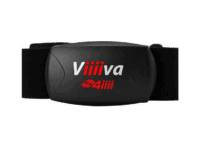 | 4iiii Viiiiva ANT+ to Bluetooth Smart HR Strap & Bridge $79.00 | $79.00 | Amazon |
| Garmin Bike Mount Kit (for mounting any watch onto handlebars) $10.00 | $10.00 | Amazon | |
| Polar Bike Mount Kit (for mounting any watch onto handlebars) $12.00 | $12.00 | Amazon | |
| Polar Bluetooth Smart Running Footpod (Bluetooth Smart Only) $79.00 | $79.00 | Amazon | |
| Polar H6 Heart Rate Strap (Bluetooth Smart Only) $58.00 | $58.00 | Amazon | |
| Polar H7 Heart Rate Strap (Gym equipment + Bluetooth Smart) $60.00 | $60.00 | Amazon | |
| Suunto Bike Mount Kit (for mounting any watch onto handlebars) $10.00 | $10.00 | Amazon | |
| Timex Bike Mount Kit (for mounting any watch onto handlebars) $9.00 | $9.00 | Amazon | |
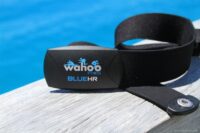 | Wahoo Blue HR - Bluetooth Smart Heart Rate Strap $69 | $69 | Amazon |
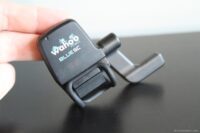 | Wahoo Blue SC - Bluetooth Smart Speed/Cadence Sensor $60 | $60 | Amazon |
Thanks for reading! And as always, feel free to post comments or questions in the comments section below, I’ll be happy to try and answer them as quickly as possible.


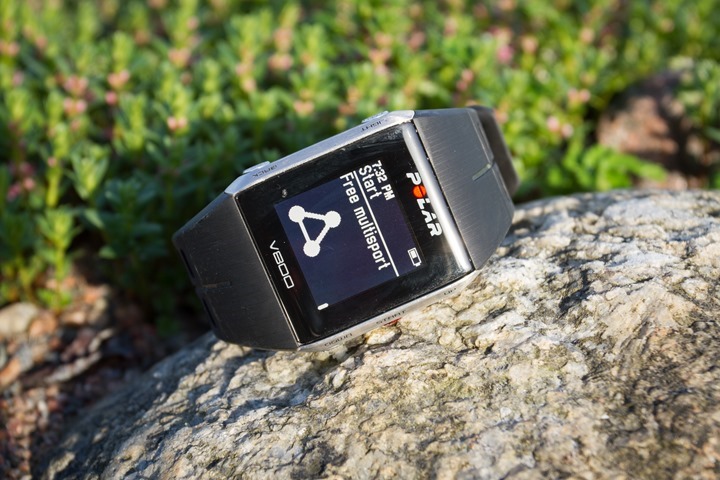

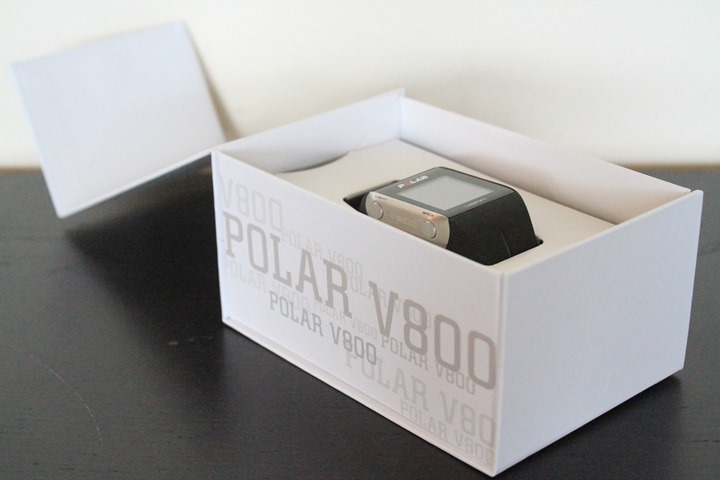
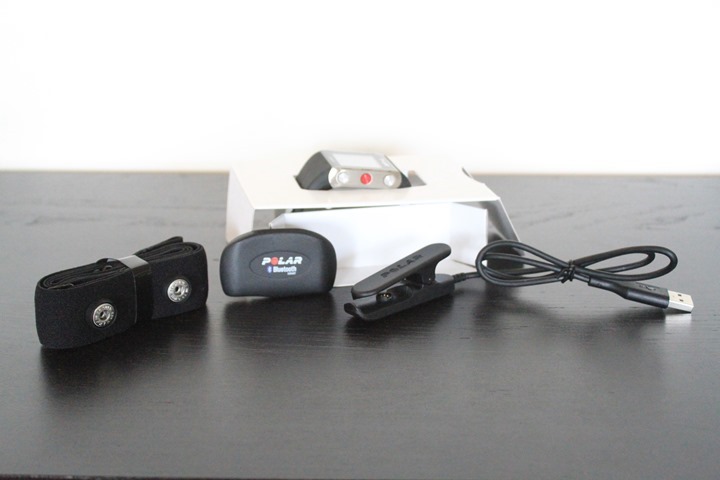
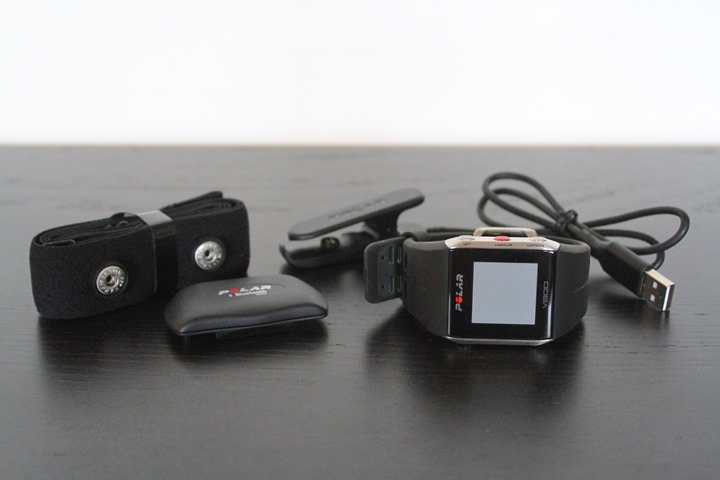
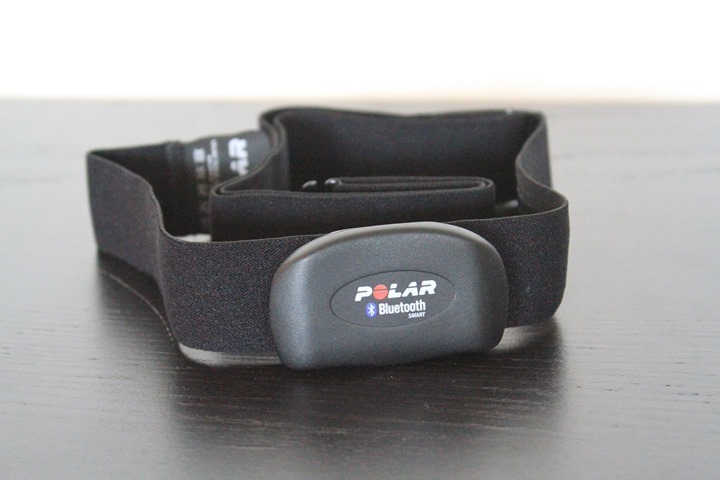
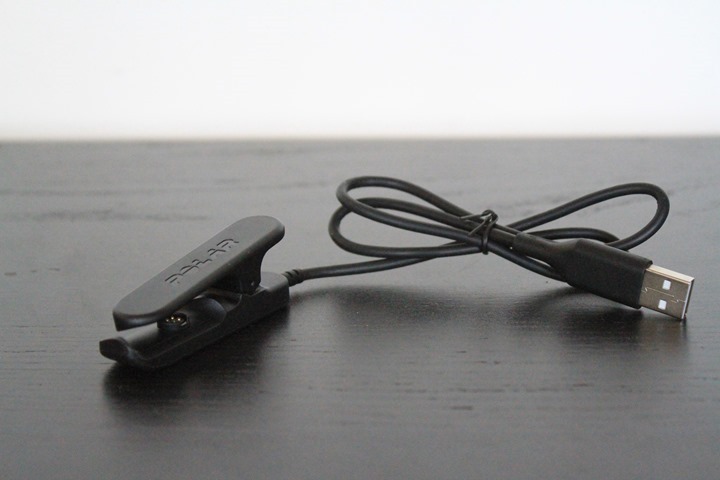
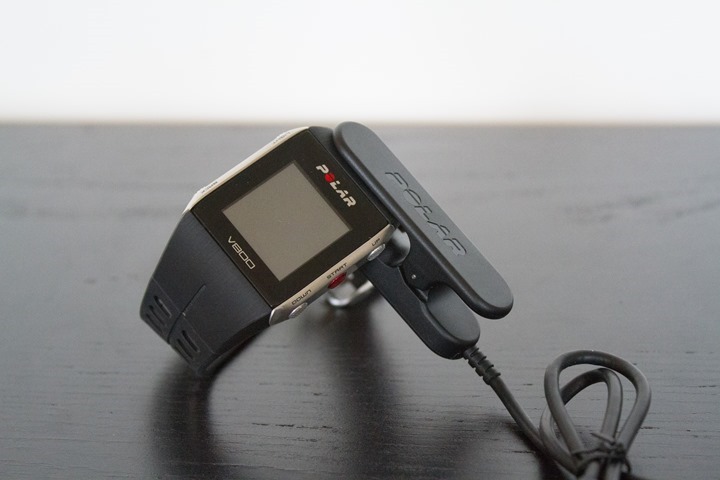
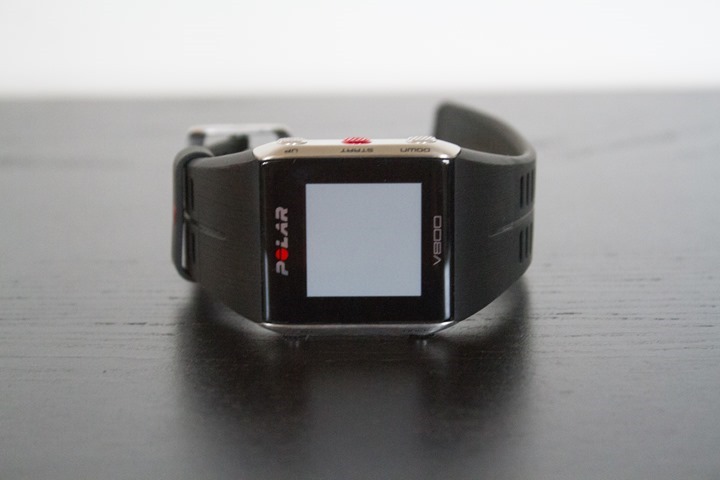

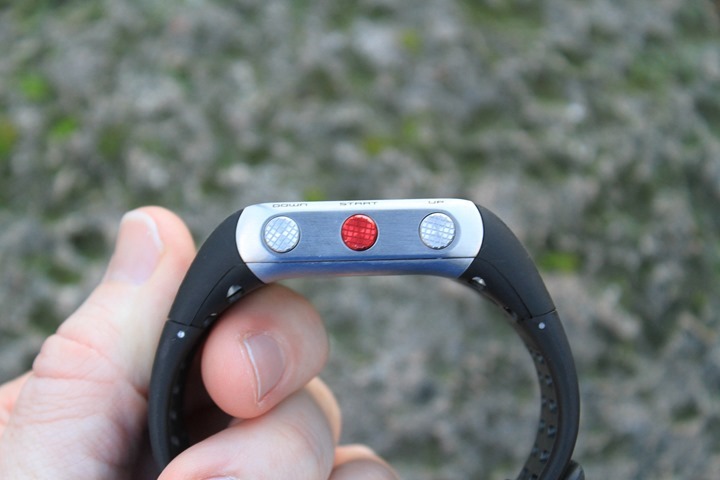

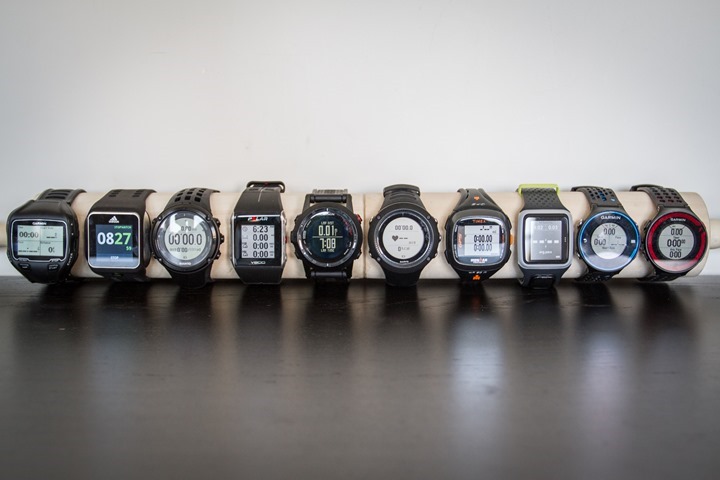
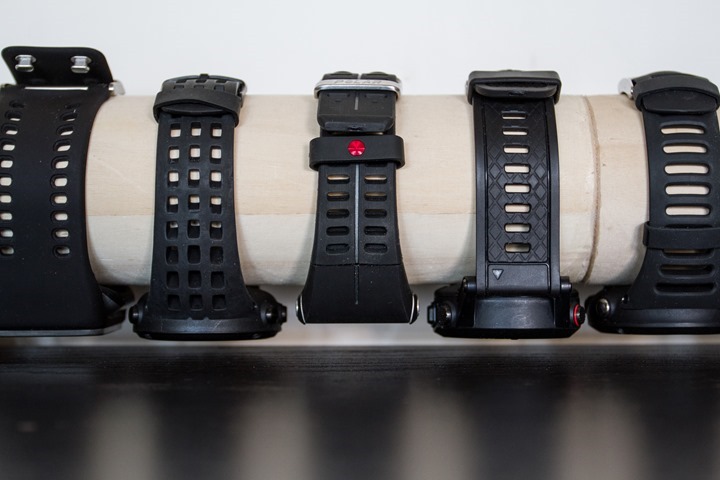
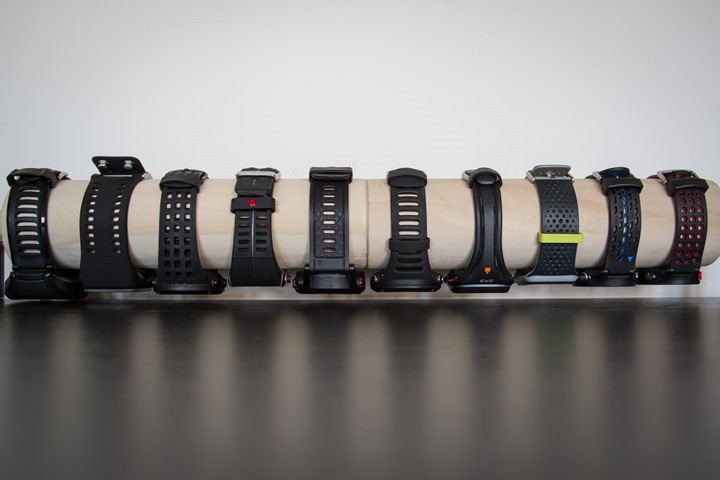

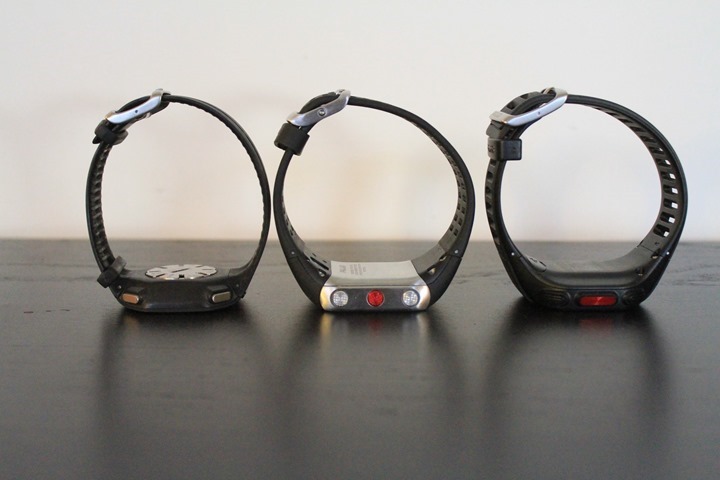
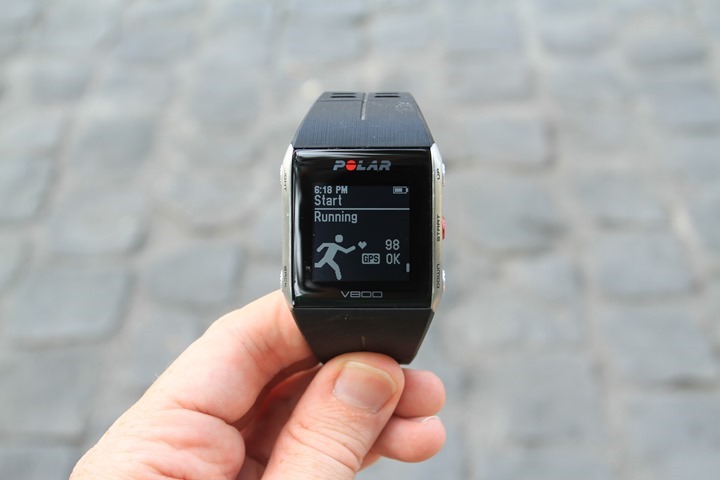
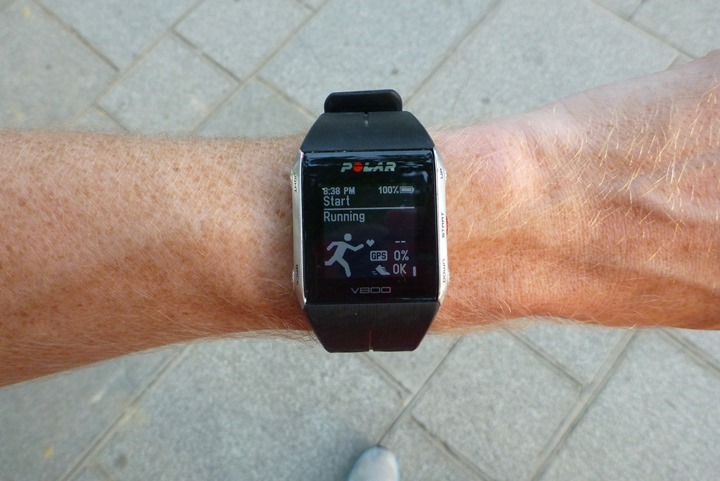
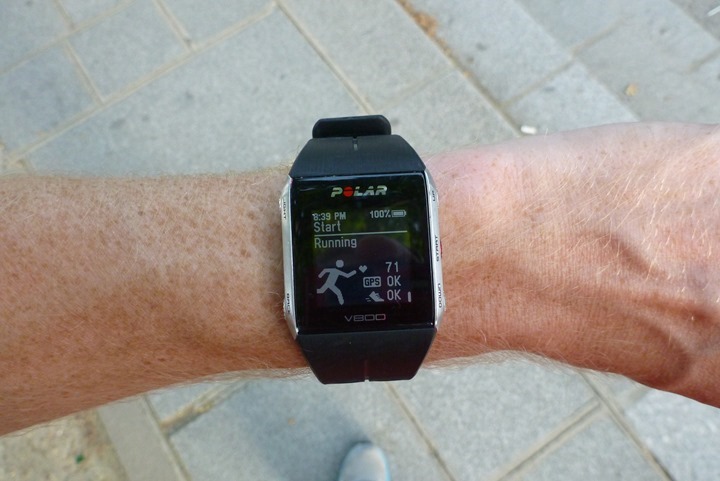
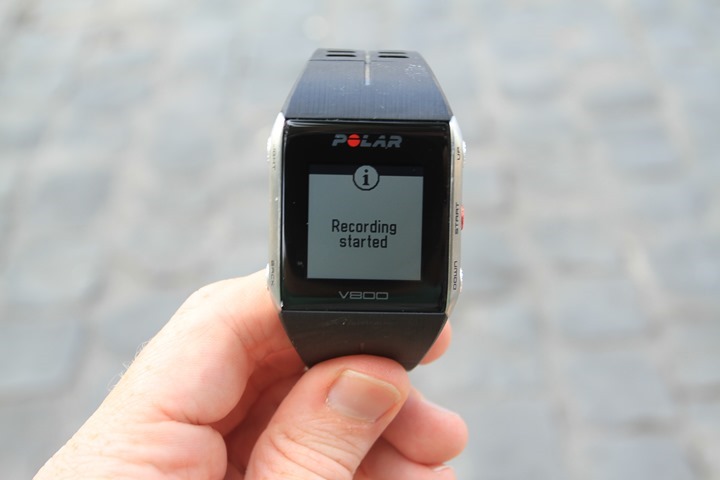

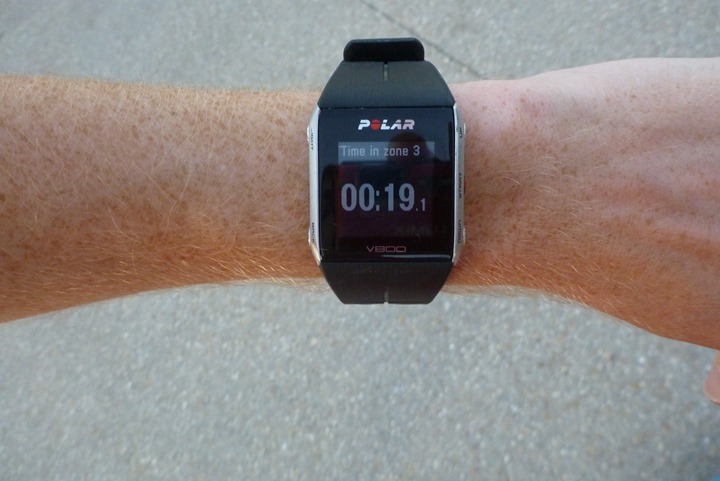



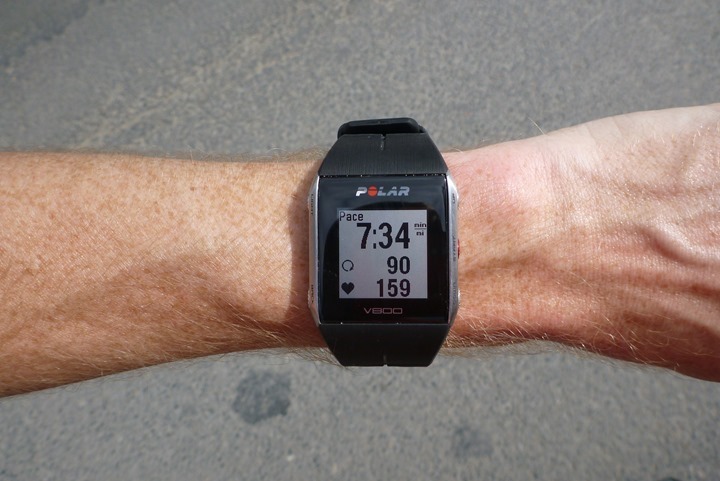



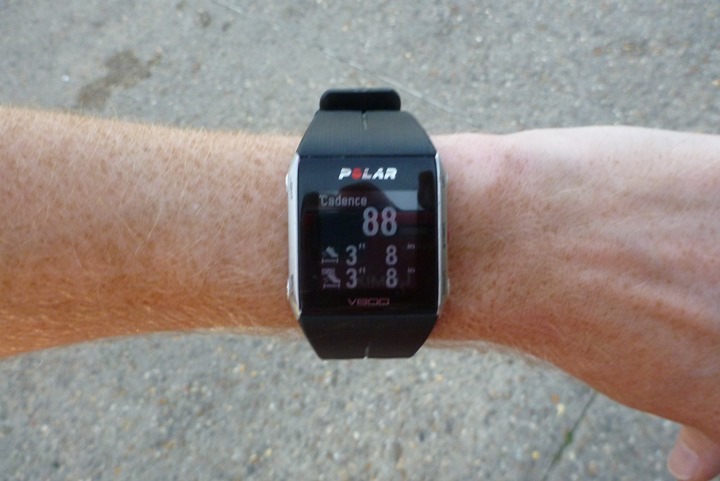



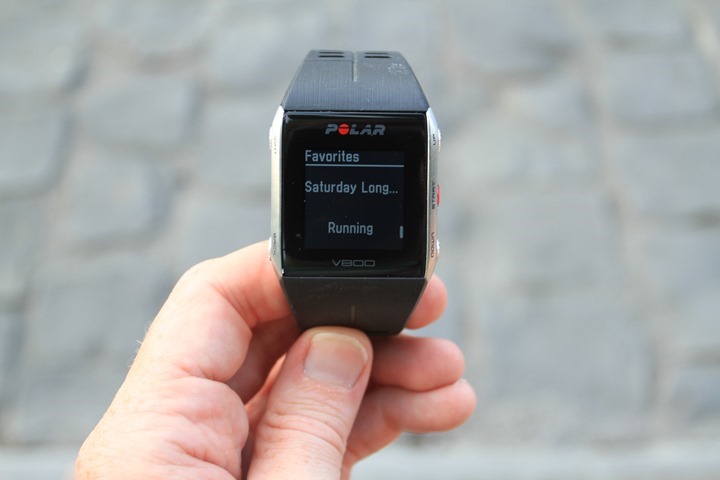
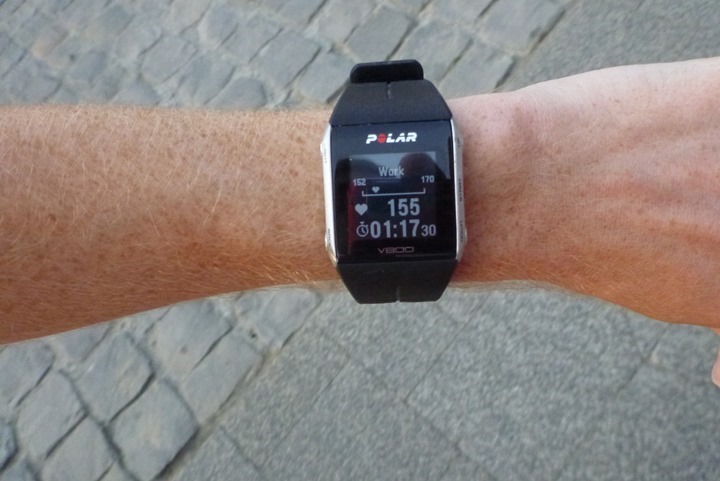
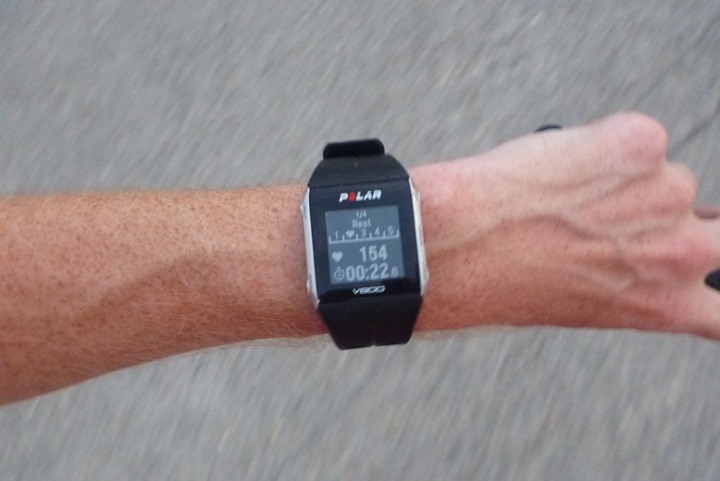


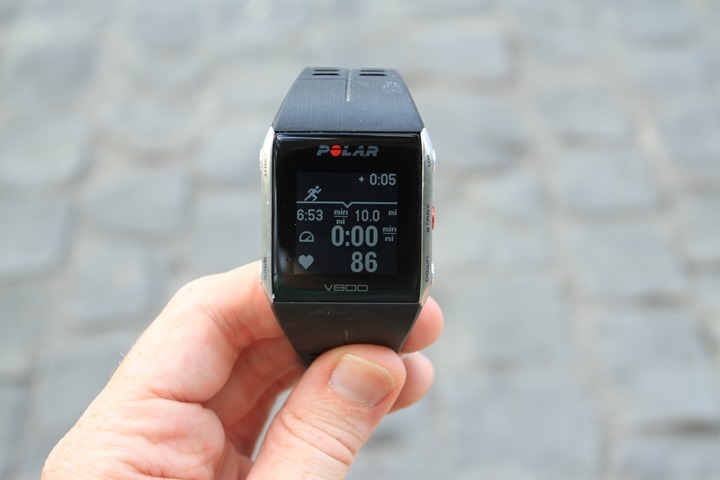

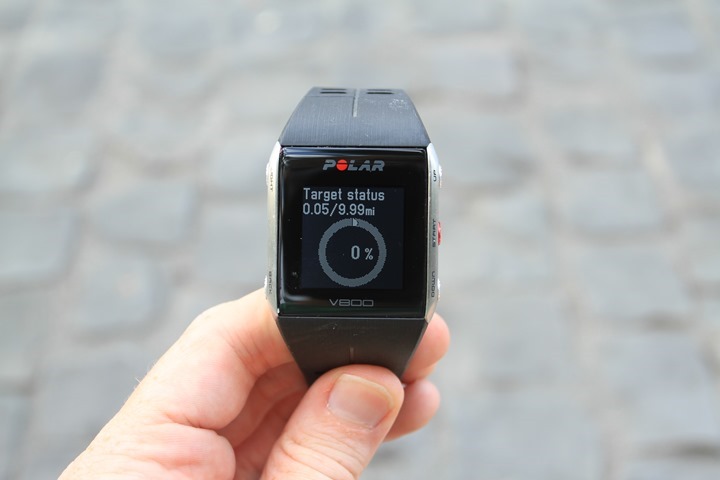

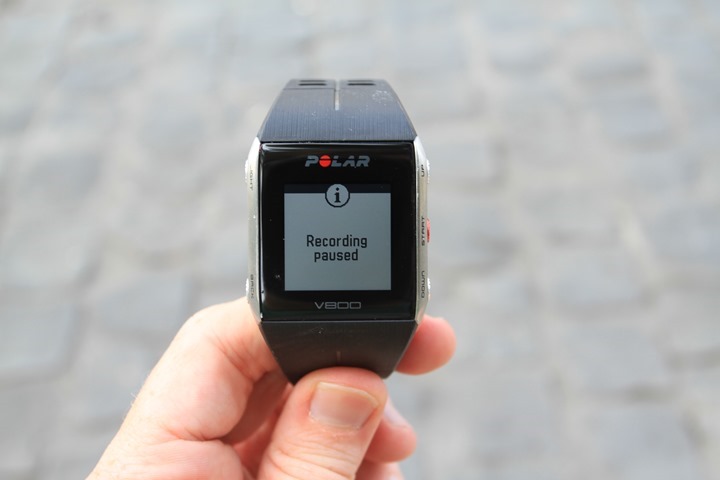
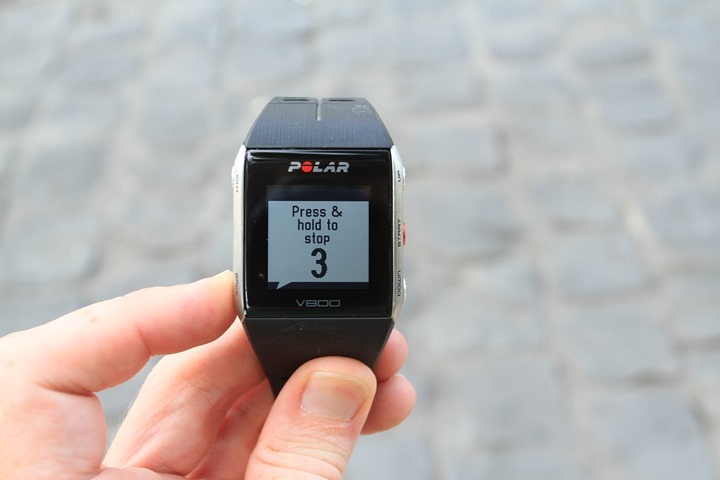
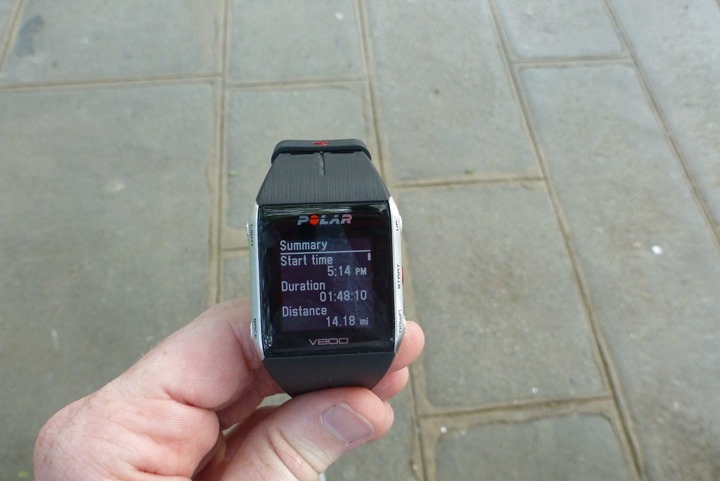
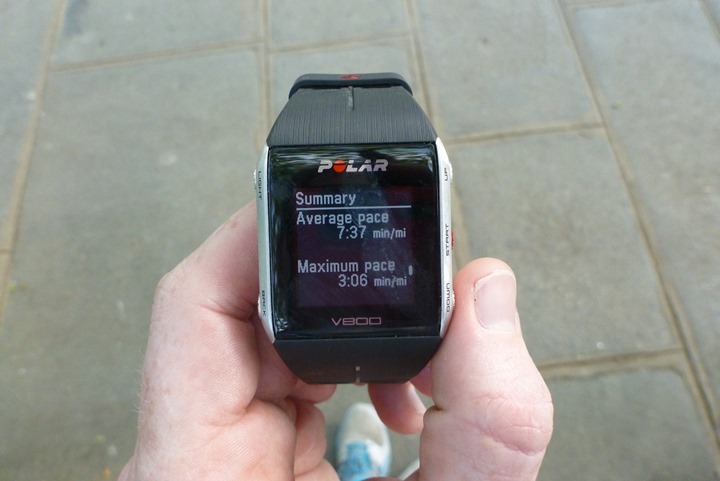
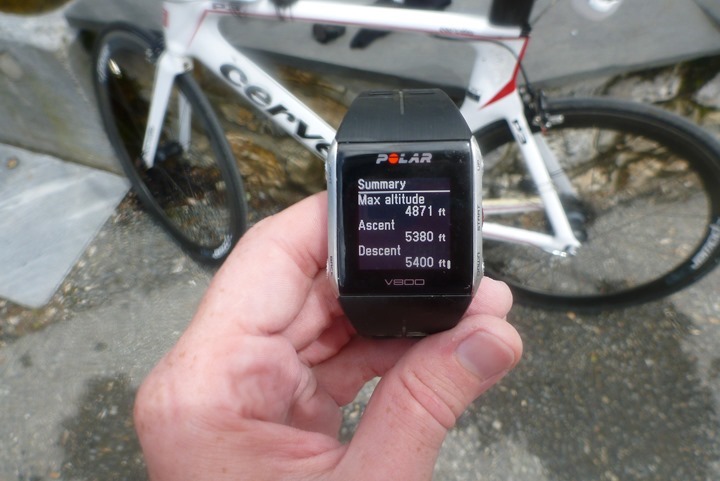
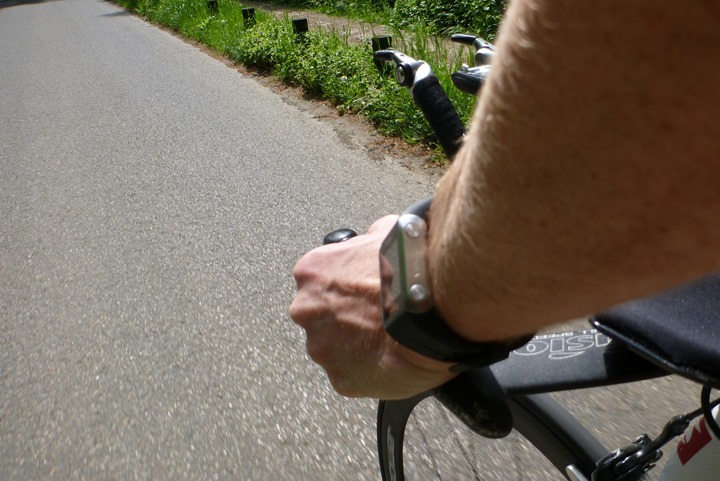
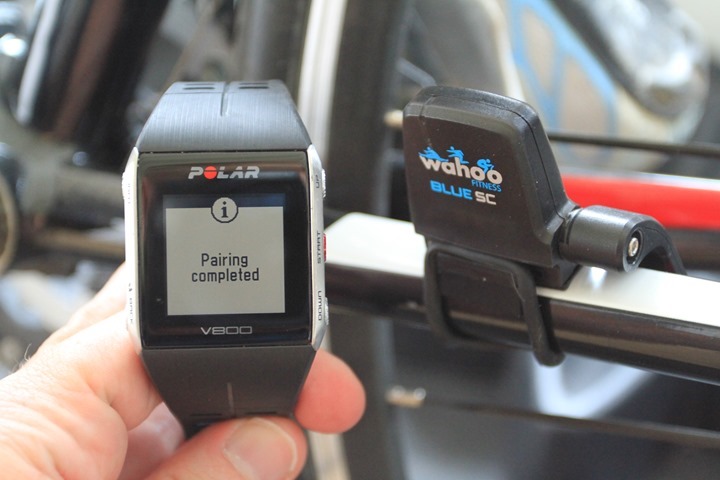


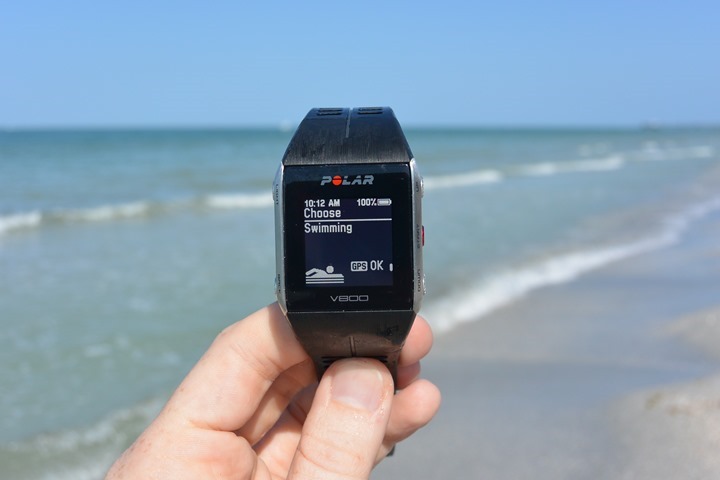
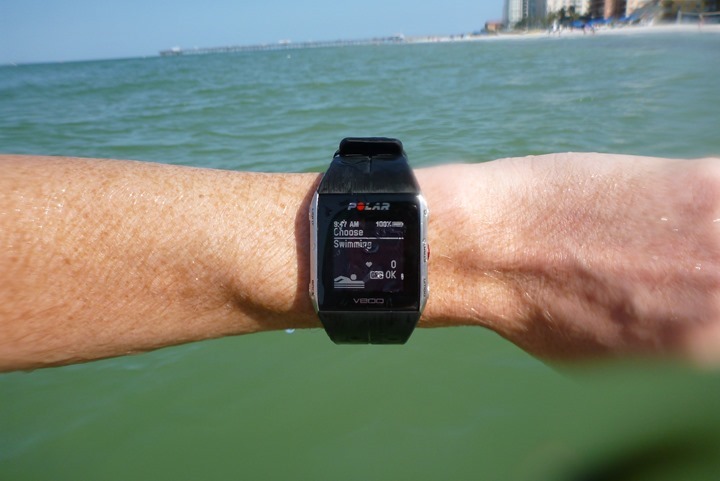
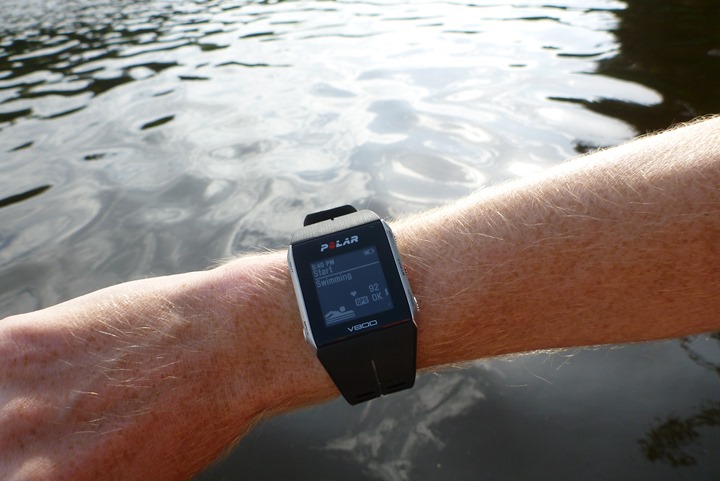


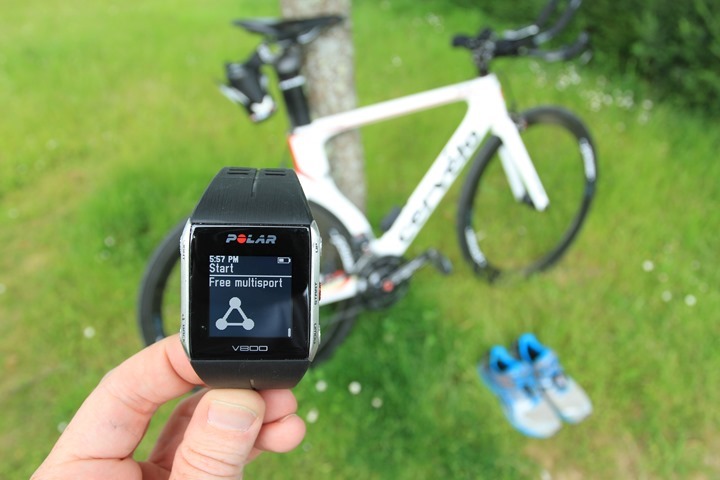
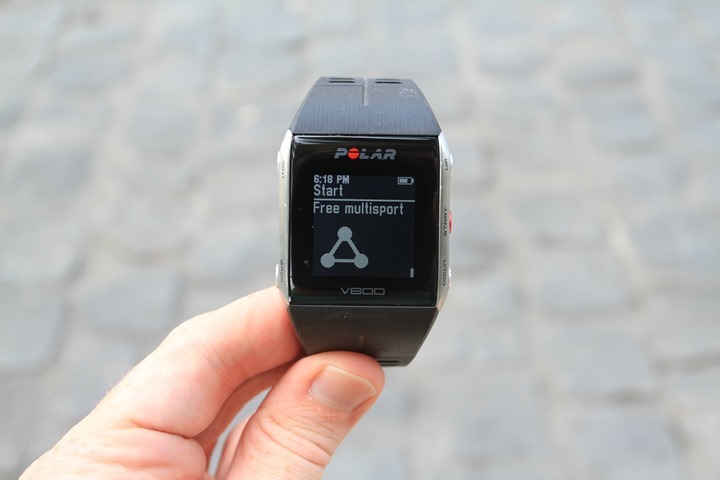
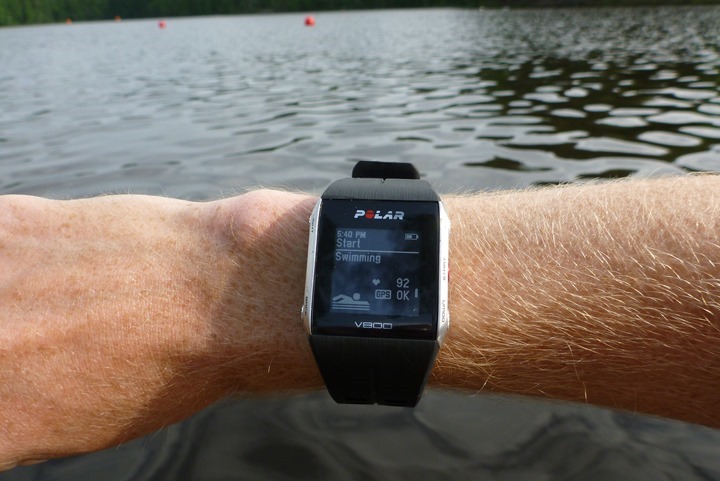
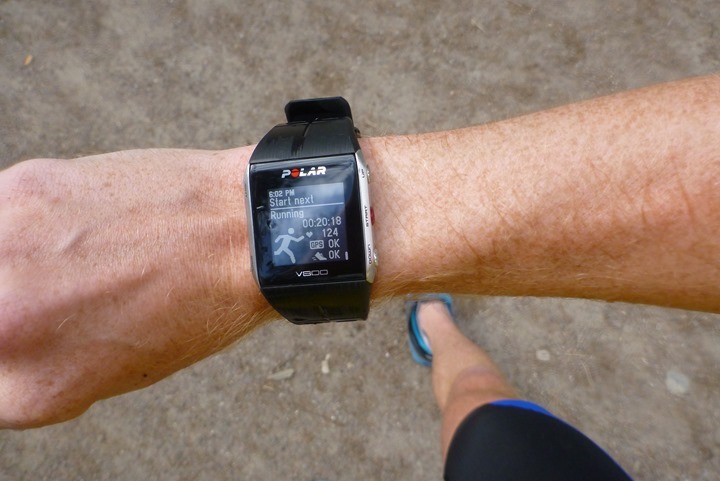
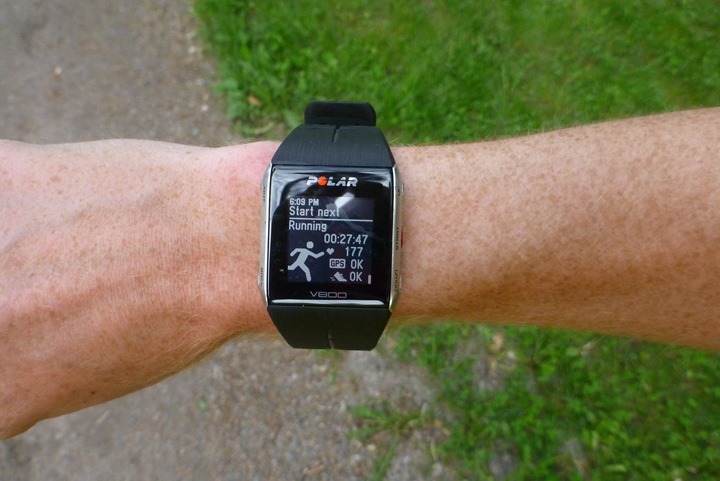






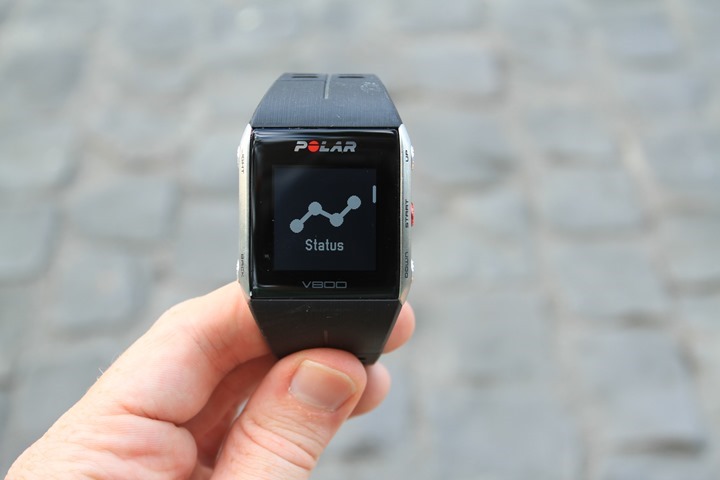
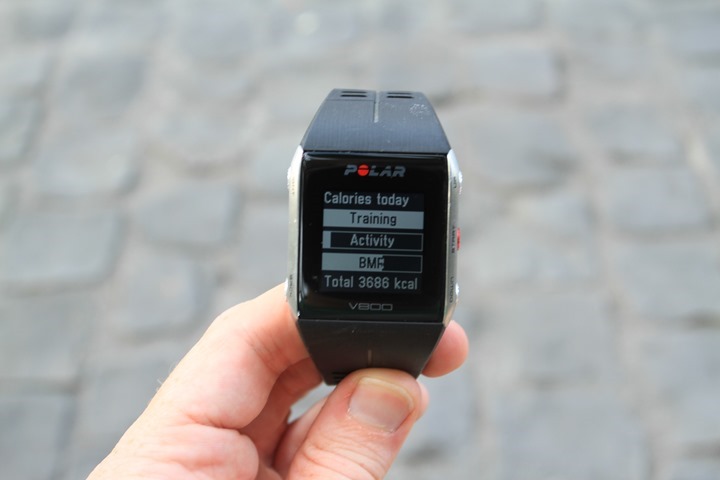
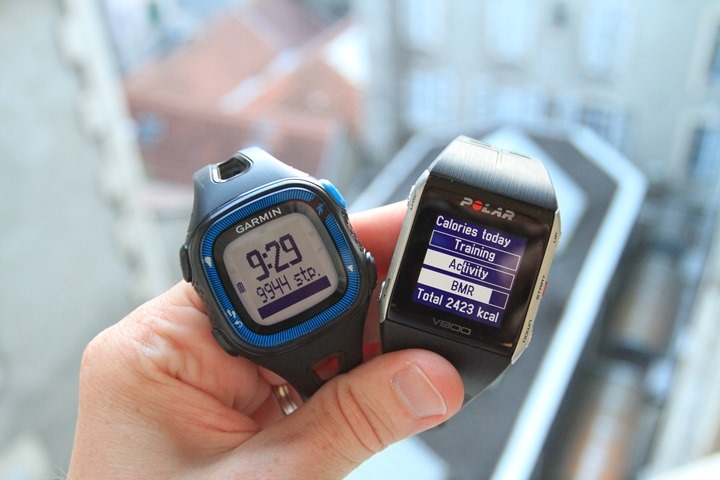
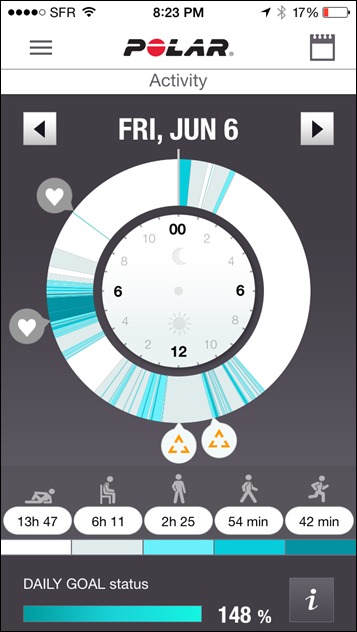
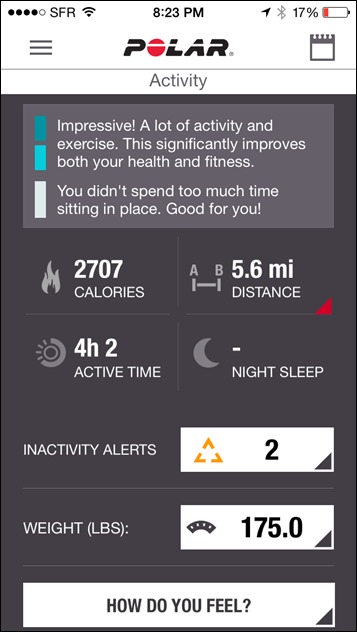

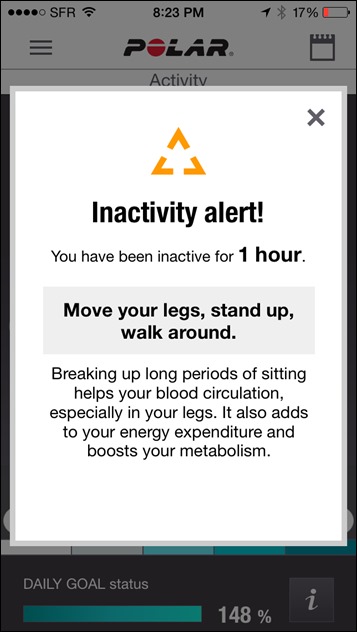

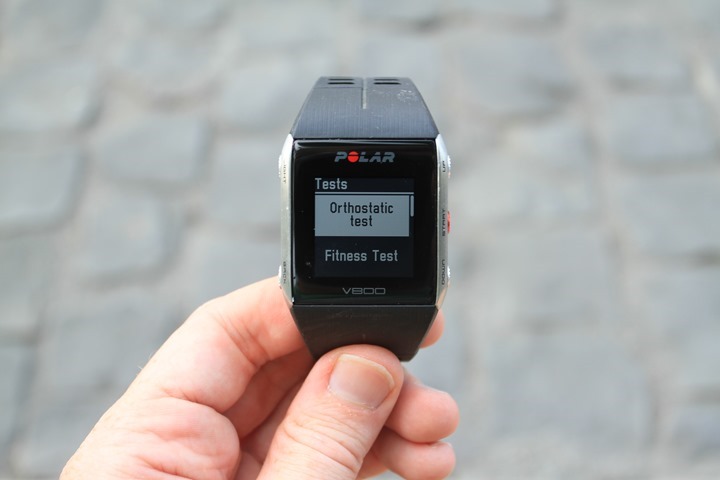
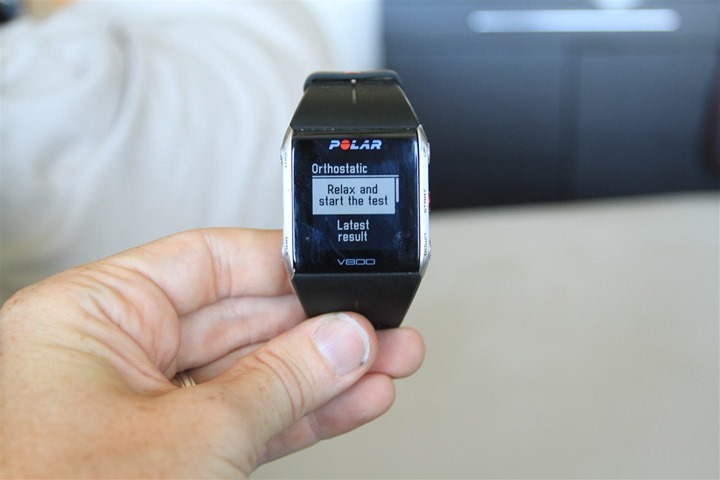
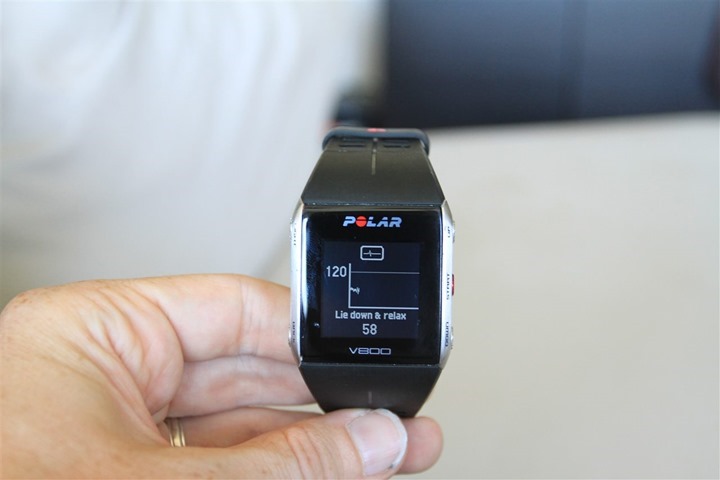

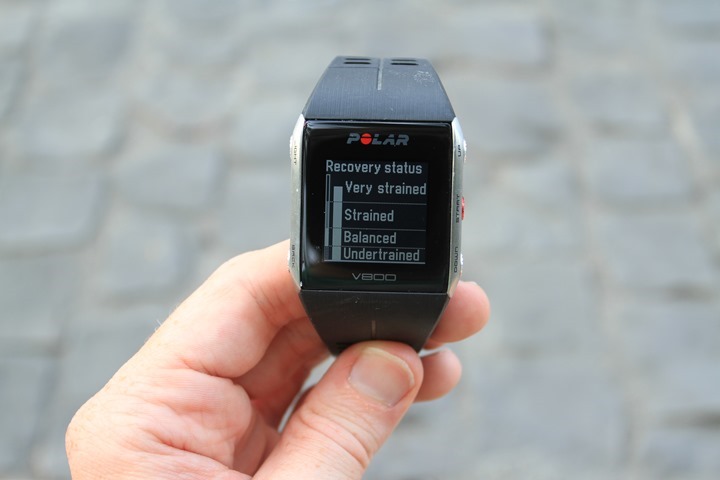
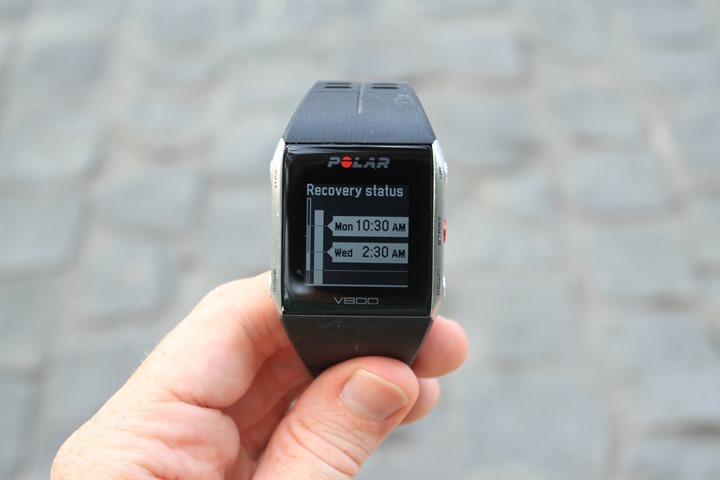
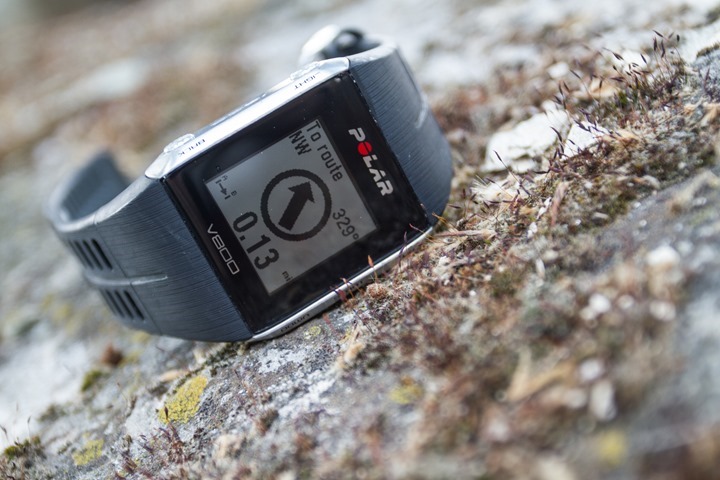
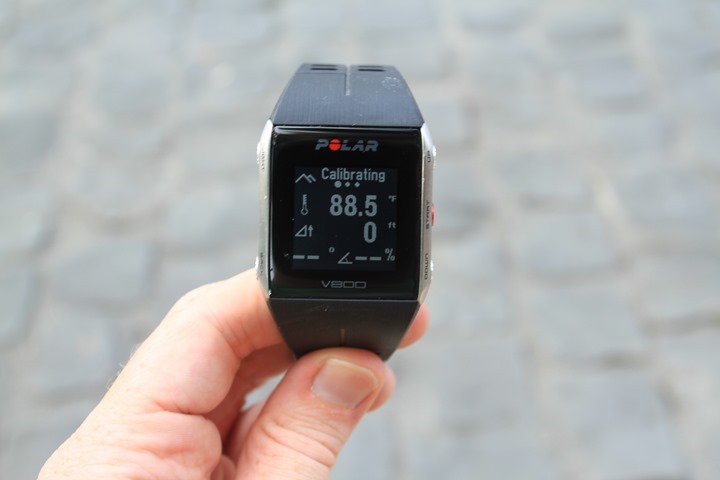



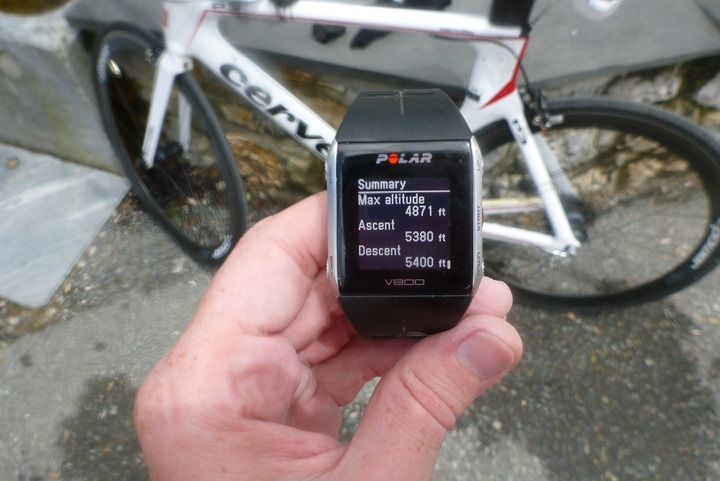
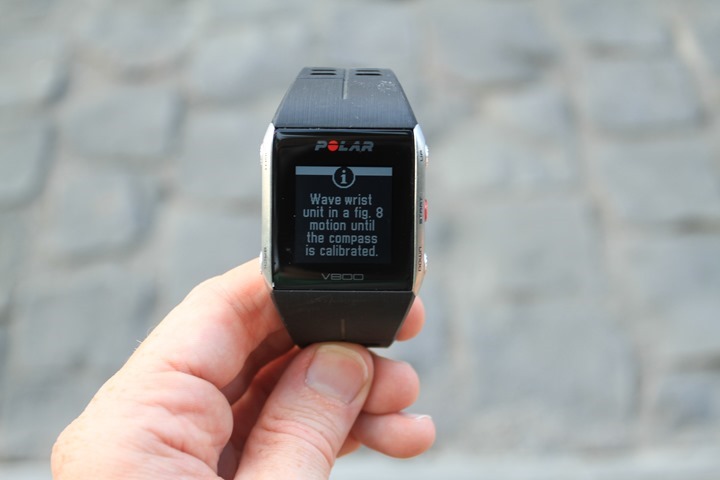

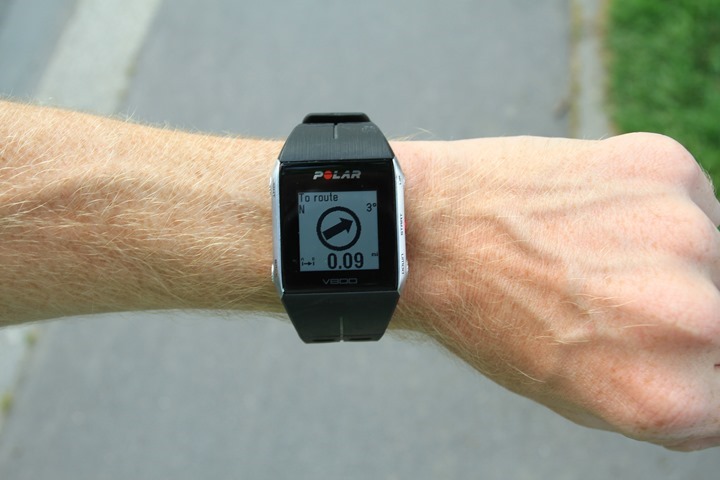
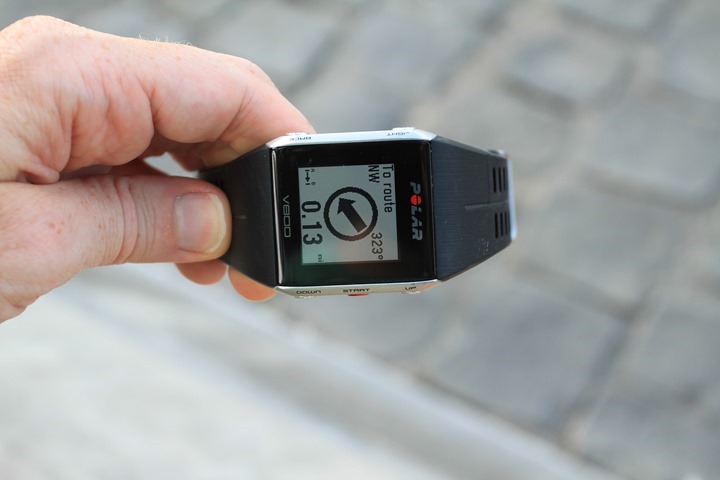
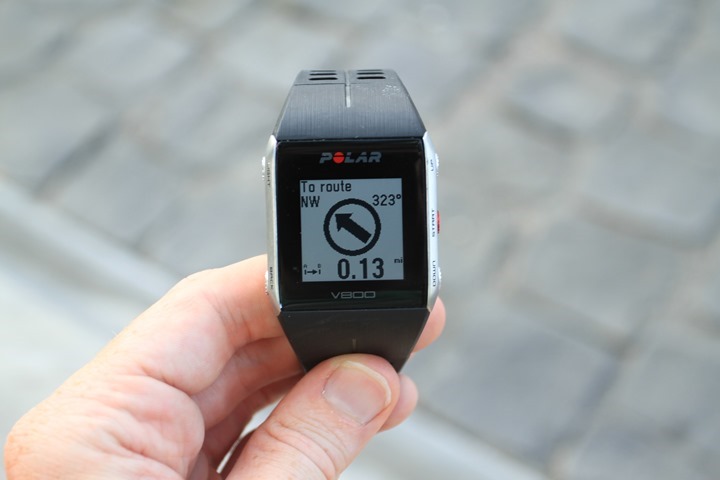

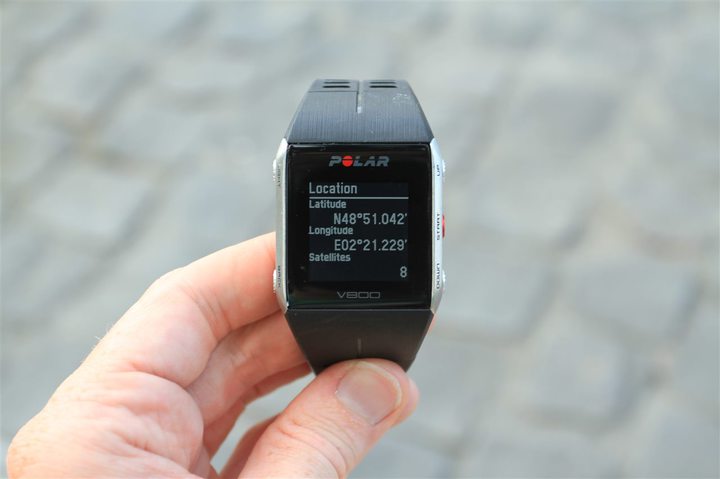
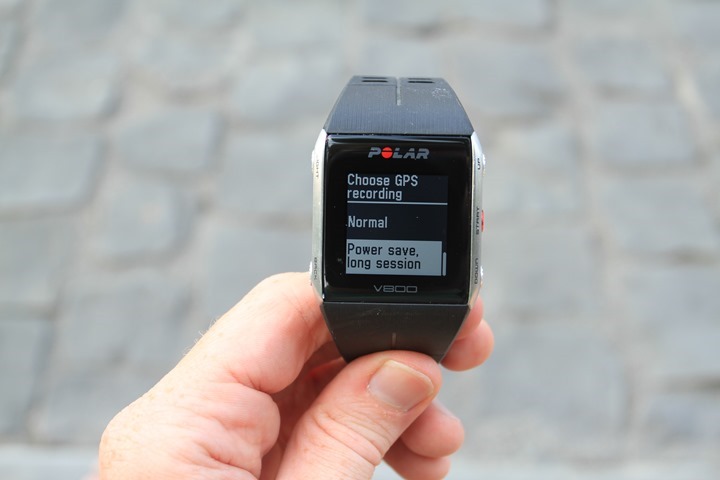
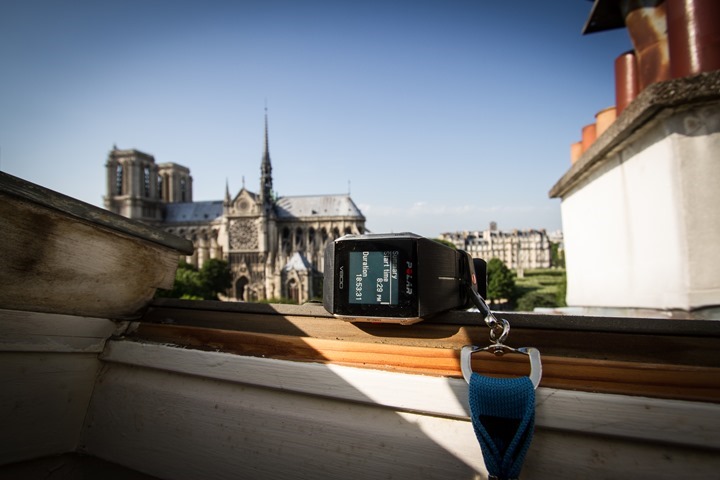
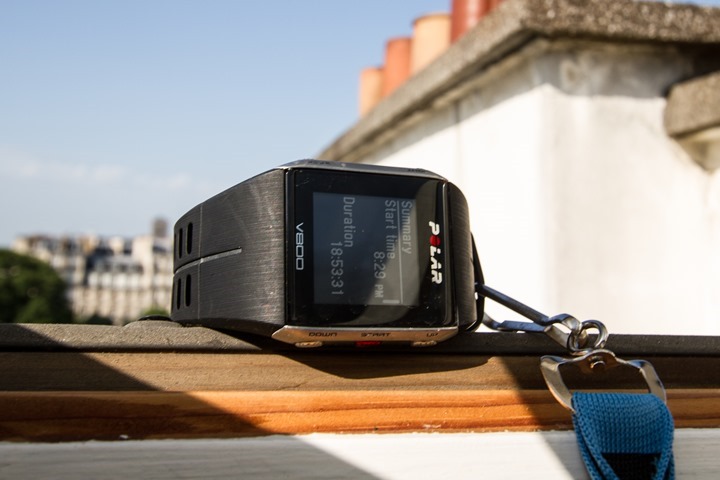
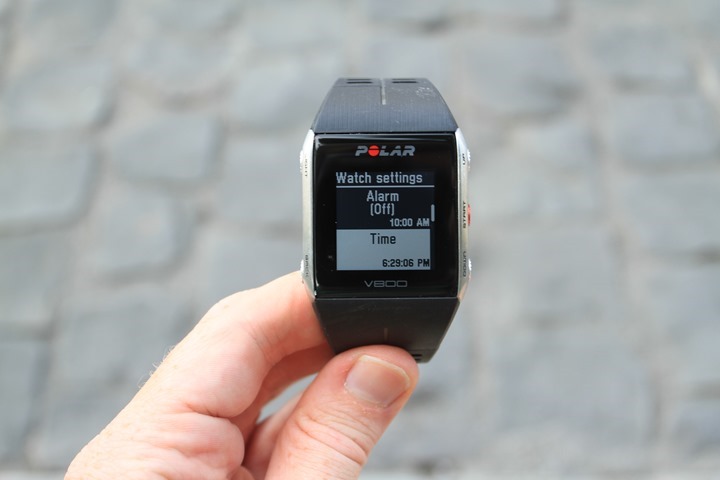
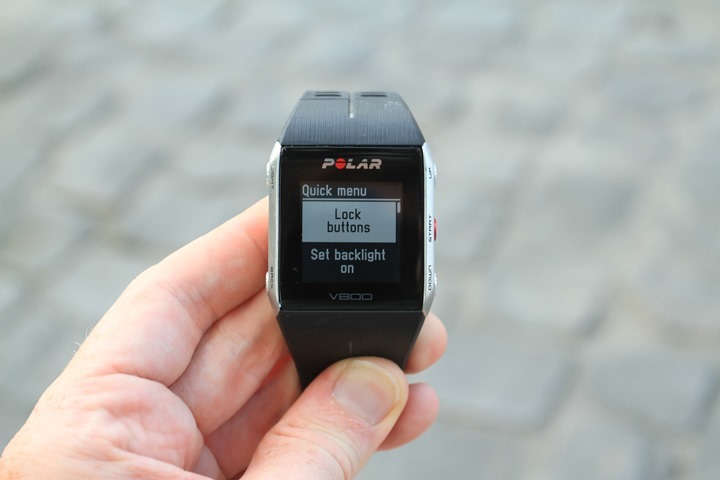

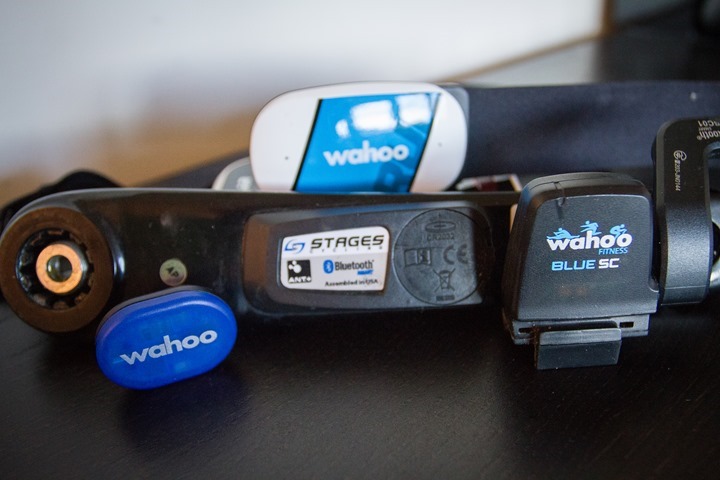
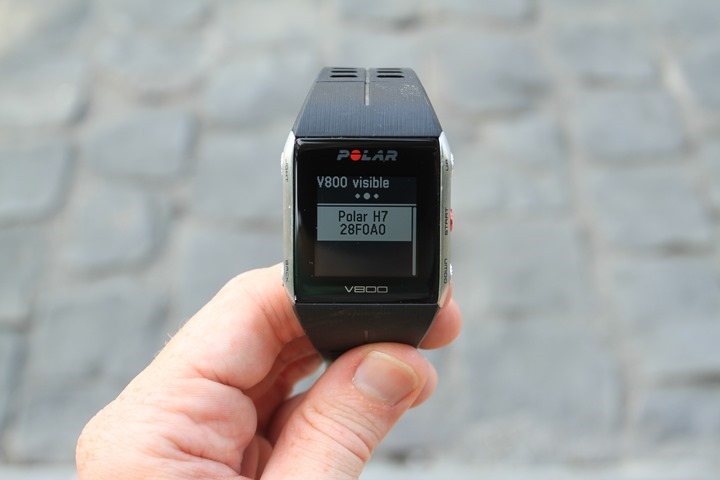

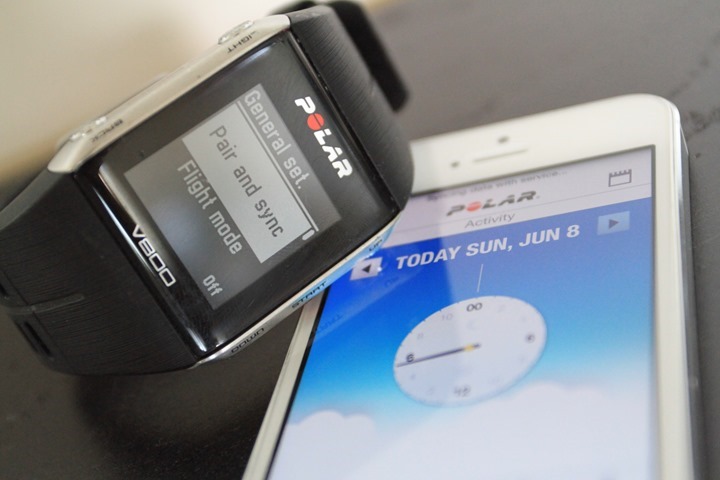

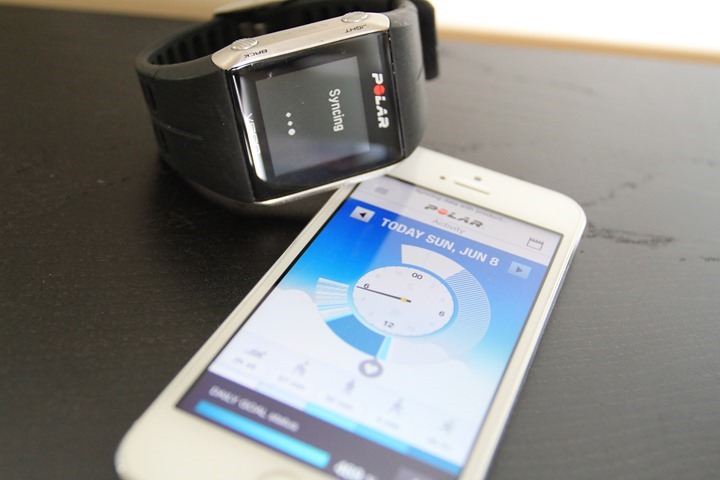
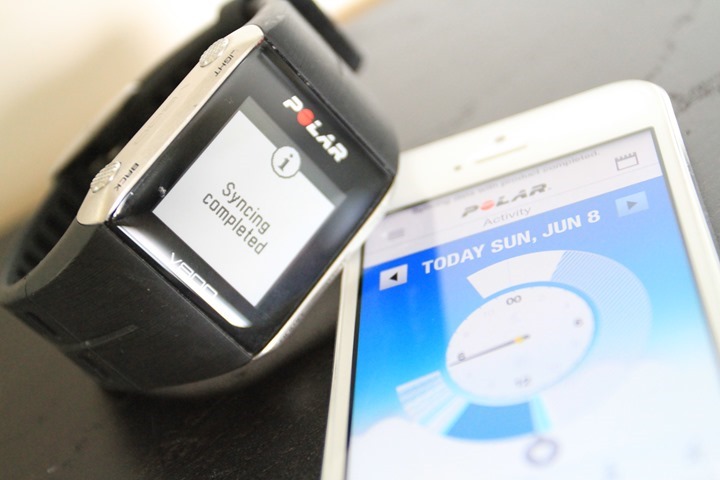
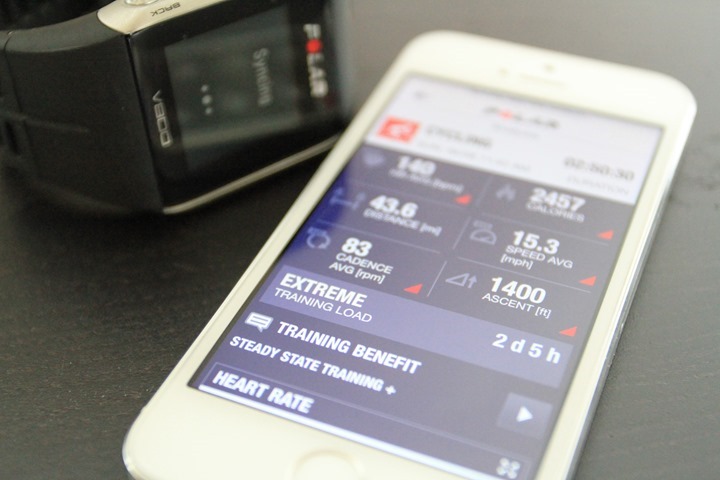
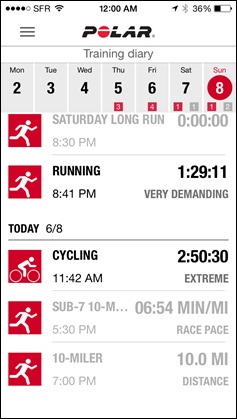
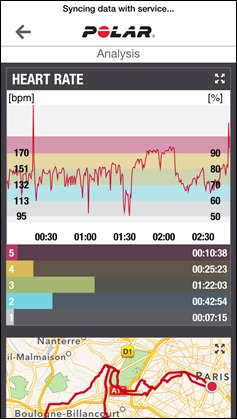
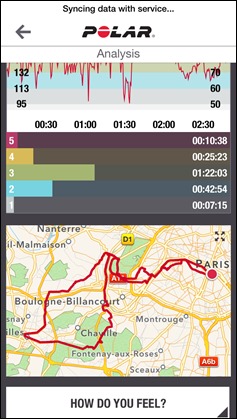

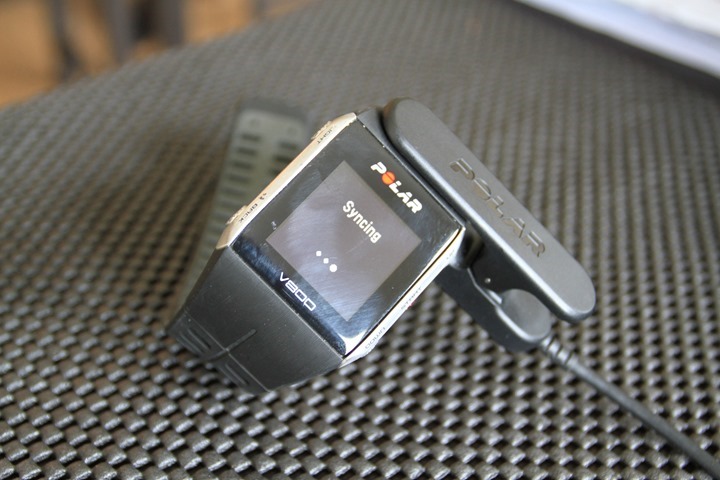






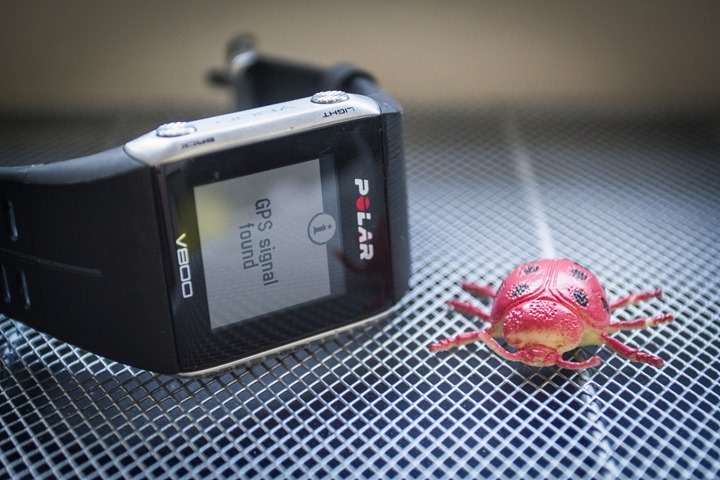
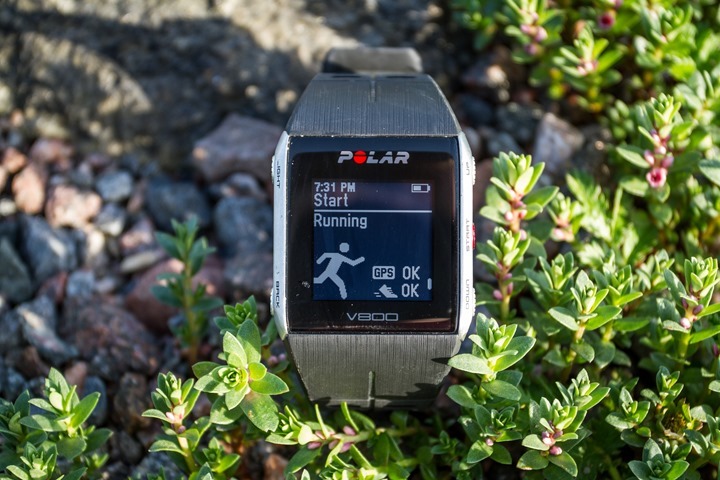
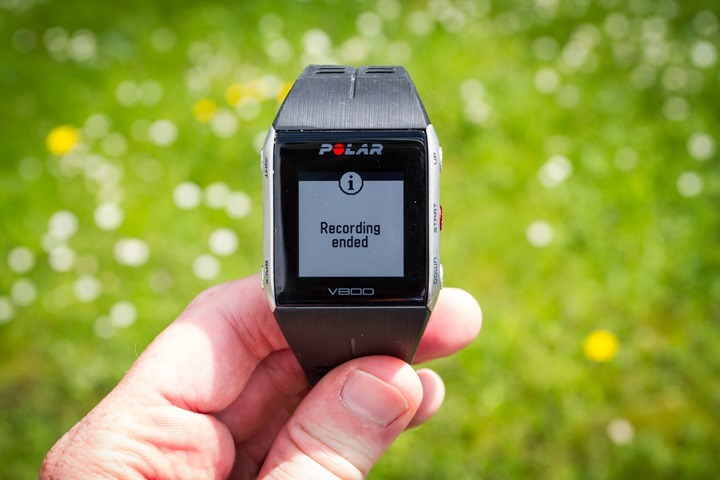
















Thx DC, I’ve been waiting for your review before make my move. You do an amazing job (besides the real one).
Wow, great review again. Ray you are the John Siracusa of fitness gadgets!
Thanks Ray. As always your reviews are the best but now here is my question. Is the V800 better than the old RS800CX??
As for the future, not only Polar has to provide what they’ve said but they could add more functions to make it more competitive since hardwarewise the watch is complete but they is lacking a lot of functionality right now. So do you think that polar will provide new features down the road that hadn’t been announced just to keep it more competitive??? Cause as of it is right now it will have to face not only the Fenix2 and Ambit2 but the future 920XT.
Hi Phellan-
I actually never had the RS800CX, so I’m not quite qualified to comment there unfortunately. As for futures, when talking to Polar in the past, they’ve definitely noted that many things are possible on the platform – i.e. LiveTracking and Smart Phone notifications, but for some of those features that would have put them on the same ‘level’ in certain areas as the Fenix2, they haven’t provided dates.
I read this overview and I would say – if it is not hard to you to carry on GPS pod then RS800CX seems to be better, at least currently.
Yes, RS doesn’t work in a water but neither did V800, so tied 1:1 here.
For me RS is better because I can make training plan by setting different goals – like speed, pace, HR, increase HR, decrease HR, cadence etc.
I can mix them together as well. Also different repeats can be added etc.
Yes, daily tracker, recovery recommendation are nice things, as well pictures are nice but if to look what is important for training then I didn’t see any big difference.
PS! As you are able to transfer data into computer, you can also merge GPX and HRM files together and “override” POD sensor when it did show you wrong data.
PS2! I still found one thing what is better in V800 – data transfer is better then it is in RS
I have the RS800CX. I think the V800 adds some “nice to have” features, but nothing super compelling.
The big show-stopper from me (something they should have fixed from the RS800CX): The interval timer still doesn’t beep at the end of an interval. Having to watch your HCM as you run, bike, xc ski, swim, or rollerski during to see if your 4 minute interval is over is unsafe and awkward. I’ve had to use either a watch with a countdown timer or my smartphone with an interval app. Seems stupid that I spend $500 on a HRM that doesn’t have this feature built in.
I have both RS800cx and v800
you cannot compare rs800cx with v800.
rs800cx start to be a bit old fation
I have both RS800cx and v800
you cannot compare rs800cx with v800.
rs800cx start to be a bit old fation
I doesnt agree with Mike it is a lot of function that the Rc800cx doesnt have.
Phellan,
I’ve had 2 RS800CXs. One drowned and the other still works. I say the V800 is much better waterproofed so if you do a lot of water based activities, that to me would be a big criteria to consider the V800. If you wear a wetsuit I think both are slim enough to not hang-up getting out of it-not like a 310 or 910.
Both have HR R-R variation capability built in so can do Polar tests based on that data.
I got a lot of inadvertent start/stop button activations with the RS and I think the design of the V800 will reduce the likelihood of that happening.
Ir data transfer vs USB/Bluetooth-hands down V800.
Notifications and near real time access to data are better on the V800 esp. if you have an smartphone.
You can compare the watches features on the Polar website.
To me the hardest comparison is the RS800 is a known quantity with an Polar proprietary eco-system. In the beginning and for a long time that was the go to system. The V800 is still being developed and who knows what functions will or will not make the transition.
There is a lot to be said for something that “just works”
I totally agree.
Also, the possibility to set the intervalls on the watch is missing.
And the countdown timer is just silly. It just keeps starting over. I’d like to be able to set a countdown timer on the watch and have the timer visible in one of the views. My old Suunto T6 did all this. I almost regret purchasing the V800
I have both the V800 is much modern, but if you are REALLY use it for training the lack of creating your own training plans and most important to me a reliable placer where to analyze your data regardless the location still makes the Rs800 better.
Add the fact that if you use the V800 5 times a week in 40+mile rides it will last you about 2 years at best.
I honestly do not get this “cloud” trend on hardware companies like Garmin and Polar, they do a pretty poor job at it and they do not know how to run a cloud service and most importantly do not have the infrastructure.
Much expected, finally available, with the usual high standard of DC Rainmaker : I am a happy man :)
Thanks Ray!!
One question : when you say that satellite acquisition is not as fast as other units, does it mean that the GPS accuracy is not as good as Garmin or Suunto?
The question that hides behind : which unit provides the best GPS accuracy? I trail, hike and mountain bike with my iPhone, and it has errors going from 5% to 100%, so I seriously consider buying a device. GPS accuracy is THE thing I look as because running in forest or canyons are really causing serious trouble to GPS chips to catch any signal. Does the GPS accuracy of the V800 makes it a good candidate?
Thanks for your help!
No, the actual accuracy of the unit I’ve found spot-on with Garmin, Suunto and other devices when I’ve ran with them – all within usually 1-2% of each other. Zero problems there, especially with city running.
When you say GPS accuracy compares to Garmin, do you mean the 910XT in your comparison chart, or the 620’s much worse GPS?
I’ve been comparing with a bunch of devices lately: FR620, Suunto Ambit 2R, Fenix2, TomTom Cardio, Garmin FR15 and occasionally the 910XT, oh, and usually an iPhone app in the mix.
For cycling, mostly the Garmin Edge units (800’s/810’s/1000), as well as the Mio Cyclo 505.
Ultimately though, when I take 3-4 units on a run or ride, and all of them come back with what is basically the same value (and that value was consistent throughout the activity) – then I kinda throw out the argument that one of them has a ‘worse GPS’.
OK, super clear! Thanks ray!
So any device more or less does the job.
Hello
have you also tested running without footpod?
Because my rs800cx with G5 GPS will so show incorrect distance and pace :(
and I’m hoping that this feature will have been improved
kind regards
klaus
Yes, I tested about half the time without a footpod and half the time with.
Before running – will you always wait that GPS signal has been found?
Do you run lots in a wood?
Just asking because haven’t seen same problem as you, when GPS is locked correctly.
And just from technical aspect – in woods GPS signal might get lost but also haven’t noticed that.
Absolutely always wait till lock (it’s funny, I actually had some semi-snarky comments about that in a recent post but removed them before publishing…).
I ran both in the woods and the city, and everywhere in between during my testing time. My long run route often includes about 3-4 miles of woods. And then of course most of my regular running routes are in downtown city areas, since that’s where I live.
That said – which ‘problem’ are you referring to in this section?
I would caution against buying anything from Polar with expectations they’ll add on functionality. They always plan/promise to add functionality to every product they release, but rarely follow through. Only buy the v800 if it meets your needs as is. Even functionality that supposedly exists, but is later found to have issues may be dropped entirely.
In addition, as you mentioned Polar isn’t very friendly with any other platform. Which also means if it doesn’t work with Polar’s platform, you are in a bind. I have multiple Polar products, including a RCX5. polarpersonaltrainer.com shows that I biked >600 miles in 4 hours while burning 0 calories. I’ve had multiple issues and Polar support hasn’t been able to help me. I’ve given up on Polar and slowly starting moving over to Garmin.
“I would caution against buying anything from Polar with expectations they’ll add on functionality.”
I agree, the only company that actually adds functionality to their existing models is TomTom, although they
have been lacking to begin with.
Any news about whether RC3 users will be able to use PolarFlow instead of PPT.com
Strange. If I look at all the major companies, all of them have added a fair bit of functionality after the fact – Garmin, Suunto, and to a lesser degree actually, TomTom.
Looking at Polar, I’m not sure they’ve had the opportunity to really promise anything previously (except Loop, which they’ve added small things to). Their previous units didn’t support firmware updates in the field, making that tough. Their Loop does, and we’ve seen updates.
As for Flow, my understanding is that they’re working to make it backwards compatible with previous devices by the end of the year, but I don’t have an exact list of which devices will make the cut. I’ll see if I can get one.
In my experience, Garmin ‘add functionality’ in that they fix some of the glaring bugs which were there at launch. Suunto add genuine functionality eg. the massive extra features for the Ambit 2 range this past 9 months. They also improve software weaknesses (eg. speed of upload to Moveslink).
It’s a proper hassle for you I’m sure, but an article on how well each company have updated, firmware and software, how open the platform is, and how easy they are to integrate with might poke them all into working in the right direction. What I’ve read of Suunto suggests they are currently the most “good” of the big companies in this area while Garmin (from your recent article) seem the most evil and Polar seem the most disorganised/incompetent where software is concerned. It’s a shame because with some great programmers the hardware these companies have would really shine and if the politics would move aside we could see which had those programmers.
I say programmers…Polar may not have plural by the look of things, but their programmer is pretty good doing it all alone!
Polar can’t be worse than Garmin.
Hi Ray, and thank you for a very interesting review!
Like Hubert above, I am very curious on the GPS accuracy of the V800. Using the V800 for a few weeks now, I noticed that my actual track deviate from the GPS measured track as seen in the polar flow map. e.g.running into an area with trees, the GPS measured track typically goes 10-20 meters beside, but parallel, to the actual track.
Did you have a feeling that the V800 chipset is “weaker” than lets say Garmin 620?
I’ll plop up a handful of GPS tracks from a few different units today. No problem.
I don’t see any issues with the V800 and actual track accuracy. It simply just isn’t the fastest unit to initially acquire it.
While using the v800 for two weeks I found GPS acuracy pretty close to my accurately measured (not GPS) distances.
What bothers me is acuracy on actual pace. On an open aerea it’s pretty good, but in the park it’s useless. On a steady pace of around 4:45 min/km it jumpes from 6:00 to 3:30 and everything in between.
My hopes had been up for the stride, but on Rays tests …
And even if automatic calibration would work its useless if it’s not constantly adjusting. I have the RCX5, and love my stride sensor setups and acuracy. But the cal-factor has problems with variation of pace and shoes. And the v800 has no setup for different shoes, so manual cal is to userunfiendly.
This is something I’m really disapointed on. Especially while the v800 should not be a jogging toy. Polar has advertised it as their top in the line training computer for pro’s.
The folloqing comprehensive and up-to-date test shows that Polar V800 is the best watch for measuring distance and also has the best track precision. Surprisingly, the old Forerunner 205 is also extremely accurate, just a hair worse than V800. Garmin’s newer watches like 920XT and Fenix3 all use the GOS chip MediaTek, and all watches with this chip get really bad accuracy scores. On the other hand, almost all watches with the SiRFstar chip have good performance.
And when we add the very good altitude/elevation measurement of V800 as reported in the present review, then I think V800 really stands out.
link to fellrnr.com
Hi Ray, thank you for your review, very extensive.
About your heartrate band problem during swimming, I’ve seen a lot of pro swimmers train with a heartrate band, because they are also quite lean they use some sort of suspenders to keep the band stay put.
Maybe you can use that?
Yeah, honestly, I’m just not going to wear suspenders or a second top at the pool.
Yesterday, I’ve swim in a pool with my V800 and the hr belt.
It was the first time in pool an after having see my hr data from previos open water swim, I was concern about the hr data.
On my open swim, GPS track went very well. I was surprised on the precision nearly perfect in distance. But the HR data was lost 80% of the time.
And when I’ve read from your recent post Ray, you had the same problem in the pool.
So i’ve give a try.
First, I get in the pool. My hr data works just well. At the moment I put the belt in the water, the signal was lost. So, I get out and signal came back. I’ve done that few times…
The moment who I was thinking to myself that feature was crap, signal begin to connect between the watch and the belt under the water!!! So, I think that it takes times before switching from bluetooth to special chanel between the 2 units. Is that a good tought?
Second thing, it’s impossible to have the belt still in place when you push from wall. You have to ajust the belt very thight and every time you push from wall, with one hand, you have to “hold or protect” the belt from sliding down the belly. It’s seem complicated but it isn’t that much.
I’ve swim almost 3km like this and thing do pretty well.
Same behavior for others?
Thx,
Stephane
Have you tried the T31 coded strap? It seems much more compact and streamlined and the longer rubber tabs seem like they would stay in place better. I have a similar issue with the strap sliding down and was thinking about ordering a T31.
Guy,
That goes to the point I was making in my post the other day. Let me know if the plastic T31 Coded works with the V800. It works with my current monitor, but I don’t know if it will with the V800.
Bill
Ray, I swim with the RCX5 (also dual frequency) but, for that, I always use the Polar T31 coded HR sensor/belt. It’s an old one (5 kHz analog, coded) that has a non-replaceable battery (2500 hrs) and is much more streamlined and low profile when compared to the normal ones, being quite hydrodynamic.
I wear it tight (but not too much) and I manage not to have glitches in the HR readings even during push-offs. It reallly works. If you set 1-s recording rates, you can count the nb of pools from the cycles/periods in the HR data.
Yeah, I have a few of those straps as well and have tried them too. Ultimately though they just don’t stay on either for me. :-/
Back when I used a S720i Polar watch, I would wear a HR belt under my one piece tri-suit. The suit kept the belt in place, even at push-offs on the wall. Of course, the data collected underwater was useless but everthing worked good once out of the water.
I’ve done one ~1.5 mile open water swim (at 67°) with the heart rate strap, but I’m female and had the swimsuit to provide some friction to keep the strap on. It stayed put during my swim and I couldn’t see any place in the record where the heart rate data dropped out. I’ve also crossfitted with the v800 strap and the only time I’ve lost the heart rate trace is when I accidentally popped one of the snaps off with a rower handle. Derp. I haven’t used the heart strap in a pool yet so it remains to be seen if I lose the trace coming off the wall.
Hi,
thanks for your great review. I still hve a few questions: 1. Can it show pace per lap? Is instant pace while running reliable?
Thanks
Markus
Yes to lap pace. And I’ve found no problem with instant pace while running being clean.
I’ll get up a table of all the data fields you can add.
Thank you Ray!
As Great as ever!
This looks like a typo to me (bugs section):
Stride sensor doesn’t autocalibrate for me, resulting in accurate run distances
I would say that no autocalibrate means less accurate distances :)
regards
hans
Thanks!
Hi Ray,
thank you so much for your review, very comprehensive! Regarding Foot pods, If I remember correct in your first look, you recommended Adidas Foot pod, instead of Polar one, basically because of the size. Do you still think is a good trade of smaller size comparing to a full functionality of the polar brand? I’m not so much into jumping test, but I’d like to have a fairly accurate distance recorded from the foot pod.
Thank you again.
Yeah, if Polar can sort out the footpod stride length & autocalibration issues for 3rd parties, then I’d definitely recommend the Adidas one. I too don’t find the jump test terribly useful for what I do.
Now, with the Adidas footpod you can still manually calibrate. So if you put a calibration value in you’ll be reasonably close on treadmills, but it might be a bit off outdoors. It’s kinda a tough tradeoff, which is a bit of my annoyance that the 3rd party pieces aren’t working well with BLE.
There is another Bluetooth footpod (Pyle Bluetooth Wireless Sensor with Wireless Data Transmission) that I found in Amazon, which is much cheaper than Polar and Adidas one. Do you think it would be compatible with v800? (I just need to get speed and distance in treadmill run)
Do you by chance have a link to the Pyle one? Trying to find it.
I think he meant this one: link to amazon.com Haven’t got it though.
Thank you for the great review btw (first time reader). I’m still figuring out if I want to buy the watch. I currently own just the H7 heart rate sensor and a compatible phone. My gym recently added screens and is displaying heart rates of all people wearing a H7 on it. Didn’t hear you mention it, but this review isn’t about the H7 of course. (The club app: link to polar.com )
I currently own the Polar RS800. As a 100 % runner should I buy V800 or FR620?
It would depend a lot on how much value you place on different features. For example:
– Activity Tracking (go Polar V800)
– Live Tracking (go FR620)
– Lots more heart rate metrics (go V800)
– Weight (go FR620)
Etc… I’d look at the comparison chart and kinda do a bit of a shootout based on what you think is more valuable.
“Lots more heart rate metrics” – what are you referring to here, since it doesn’t even do R-R recording (yet)?
Time in zone primarily (both on the device and on the unit). And, it does to HRV/RR display on the unit itself (see that in the photos).
Another great review from DCR!
I was planning to pick up a V800 next week but based on your review I’ll not bye this watch. Seems like Polar is just pushing to much ‘promised functional’ ahead of them..!!
Great review as always. Just one thing – isn’t the fact that you can’t export to i.e Strava fatal? I would really miss all the features provided by external sites (not that it makes you a better athlete, but it sure takes some of the fun out of the whole thing). For me it is a complete showstopper and a rather big elephant.
For me, yes, I can’t/wouldn’t use it as my primary watch until export is there, specifically because I upload everything to TrainingPeaks to share with a coach.
So what happens when you connect the V800 to your computer with the cable? Do I understand correctly that it doesn’t show up as a USB pendrive? And that there’s no way to access the training files either on the V800 or on your computer?
Correct, it does not show as a USB mass storage device. Rather, you have to have FlowSync to access the data on it (which is not visible to you).
Is SportTracks (PC version, not their online service) able to read data from V800? “No” would be a deal breaker for me.
Thanks.
No, you cannot. The V800 is not able to send/export/deliver data to any 3rd party apps today (because Flow can’t). Down the road, absolutely (and I’m sure ST will work with it). But not today.
Hi DC!
The Beat app sync my training to Flow website,which in turn shows up in polarpersonaltrainer.com. Does the V800 do the same? Upon syncing to Flow,does the sessios appeat at polarpersonaltrainer.com? If yes,than one export the session to a degree.
Beck,
The V800 uploads will only show in Flow where you really can visualized your training and activities. At his moment any data in Flow is not exportable only promised in the future.
Steve
thanks for the great review – it’s close but no cigar. Even if they add all the features they promise they’ll still be enough gotchas for it not to be viable (IMO) eg, the whole situation with the footpod/pace/distance is a no for me.
the battery life looks good but I’d be interested what happens when you pair a footpod and HRM
ray – any feedback on the intensity on the vibration, I’ve read some reports that it isn’t quite strong enough ?
did you find the additional things like the “jump test” of any value ?
thanks
simon
I’ve found the vibration perfectly fine.
As for jump test, no, as an endurance athlete I don’t find much (any?) value there. Perhaps I’m missing it, but it just doesn’t really seem to fit into things.
Much ado about nothing.
Quite sad to see so much efforts of marketing and communication to make us believe that the final product is more than just a beta/alpha product.
Seriously, both the firmware and polar flow are not even close from what other watches can offer, including the Polar RC3 I own currently (data output), gloups.
Although the watch looks pretty and follows the trend of hyper connectivity and all day tracking (which sounds nice to me), all this points are not enough to convince the basic runner I am, and the triathlet I dream to become. As you often mentionned, I would rather go for something available and working now than for a box of nice promises. The competition is hard (suunto, garmin, tom tom), and I suggest Polar to think about another solution to find beta testers than to ask them to pay more than 400€.
Again Ray, thank you so much for the time spend to review in depth this product. I really appreciate to be able to avoid some wrong (too early) choices thanks to your advices. I will wait six months to see the winner betwen Fénix 2 / V800 when both products will be more mature. I am sur my wife will thank you also for saving our summer holidays ;) .
Bonne journée.
Hi Ray, good report – as always!
If I use a speed-cadence-sensor – does the v800 record the GPS data too? So I can see the gps und speed-cadence-sensor date on polarflow?
Thanks Georg
Yes, it records the GPS data (which you’ll see on Polar Flow) – but the distance/speed data will come from teh cycling speed/cadence sensor. I’ll add links into a few activities here in a little bit so folks can see what it looks like.
s/Pyranees/Pyrenees/ :)
Thanks!
Thanks for the review!
I waited for this to decide which triathlon watch to buy. But I guess the V800 is out of the picture as I want to buy one in the coming weeks. Maybe someone can help me out? Just to see if I missed something.
I have started this year with triathlon (only running before that) and for now I have a few things I would like to have in my watch:
– multisport support obviously
– 8+ hours battery
– routes for biking (I own a 305 and I like the simple yet effective line that I can follow so I do not nee more than this)
– counting of lapses in the pool as I am sooooo bad at it (HR would be nice too but not necessary)
– would like to continue to use Sportracks 2 … unless someone here would suggest otherwise
I do not really need powermeter support (as powermeters are too expensive for me at the moment) and I would not use the whole smartphone connectivity stuff.
On my list were the 910xt, Fenix 2 and V800. With the V800 out of the picture I think I go for the Fenix 2. I know that it has a lot of stuff I do not need but honestly I like the design way better than that of the 910xt (and would have preferred the V800 in this). I think I have to update sportracks though, do I? Is there any other watch I missed? I know Suunto overs watches with the features I want but I could not find anything that would make it better than the Fenix 2.
Forget the Fenix2 for the routing on a bicycle though! The previous versions of the Fenix would work great combining routes and no matter which sport profile. This version you can only see a route in the “navigate” profile, invalidating all the other fields. Already wrote to Garmin asking about this issue but or my english sucks or they don’t really get the issue…
Oh. So you mean I would not be able to switch directly from the route display to a display with HR/speed/time/…? That is a bummer.
No, you can do that, you just have to configure those fields in the navigation display to show HR/Speed/Time/etc… What Tiago is referring to is that Garmin made navigating in the Fenix2 a little bit like what Polar has done with different sport profiles. So you’ve gotta kinda think ahead a bit as to which fields you’ll need.
It’s ‘annoying’, but I wouldn’t describe it as a show-stopper.
Aha. Thanks for clarifying Ray.
I agree that it is not perfect but when I am on my bike for a few hours I think it is fine to spend a minute or two to set up the display.
Great review Ray.
I think you may have a typo in the bugs area:
– Stride sensor doesn’t autocalibrate for me, resulting in accurate run distances
I suspect you mean resulting in inaccurate run distances ?
The Adidas sensor doesn’t calibrate for me also.
I can’t decide if I should run without the footpod or not.?
Thanks. As for Adidas sensor, I’d generally avoid running with it right now outside unless you absolutely need cadence. GPS accuracy is just fine.
I got the V800 and HRM Rebroadcasting works fine for me, I can see my heart rate on the treadmill display. I am not sure the treadmill make, but is what David Lloyds (UK) is using.
Emmanouil, I imagine the treadmill is picking up the 5kHz transmission from your chest strap rather than the HRM rebroadcasting from the V800.
Jake: Probably you are right, I didnt know that the H7 HRM was broadcasting 5KHz Wind signals and Bluetooth Smart simultaneously, but that should be it, as the treadmill is not that new to support Bluetooth Smart (4.0) technology.
That’s correct, it’ll use the analog 5Khz signals (actually not W.I.N.D., that’s a separate thing).
The rebroadcasting works fine. I use my H7 over BTLE simultaneously with both the V800 and an iPad mini (to graph my heart rate in real time), and over 5 GHz (W.I.N.D) to my elliptical over its screen. It’s quite neat, if Polar could work faster on allowing us to export data from Flow – i.e. for Firstbeat in my case.
Which iPad app are you using?
iCardio – you have to let it find the H7, and then allow the V800 to connect to the H7, if you do it the other way around (V800, then iPad) it doesn’t work. in iCardio there a 2nd screen/page (when tracking), that provides you with a longitudinal graphic view (with the cardio zones) of the session. It just gives you IMO a better visibility of what’s happening over time, and without having to constantly look at the watch. You can also visually see the impact/decreasing speed of recovery during cycles in HIIT, etc.
Ahh, so in that case it’s actually not both connecting over BLE. Rather, it’s connecting over the analog connection (the V800), while the app takes that BLE connection.
Thus unfortunately, not dual-connecting over BLE.
I do not have V800 (yet, but it’s coming). Last week I tested my H7 with iPhone 5 (Polar Beat) and iPad 4th gen (Polar Team) and it works well at same time in both (pairing first with iPad). Could the rebroadcasting implementation is already working on the iPad? This weekend I will try to do the test again pairing with iPhone first.
As Ray said, the rebrodcast does not work. The only reason why it looks like it works is because:
1) The V800 can work with either BLE or the 5KHz GymLink signal
2) You’re using an H7 which transmits on both BLE and the 5KHz GymLink signal.
If you would use an H6 which has no GymLink 5KHz transmission only BLE you could not connect to both the V800 and the iPad at the same time. Same if you disabled the 5KHz signal transmission in your H7 using the Polar beat app.
Hi Ray
What happened to GPS acquisition?
In your preview of the V800:
“If there’s one thing I’ve done, it’s a lot of running with the V800. And you know what’s my favorite part? Just how fast the satellites pickup. Like most new units on the market, the V800 includes satellite pre-caching, which means that it caches up to 3 days of satellite location information for quick reception.”
In your final review:
“In my testing I’ve found the GPS acquisition time acceptable but not great. It doesn’t appear to pre-cache satellites like all other fitness devices on the market for the last 1-2 years do. So sometimes GPS acquisition takes a minute or more.”
I have a sense that the comparison chart changed, too. The V800 seems to have gone backwards.
Many thanks for the review.
Jake
Hi Jake-
I don’t know why things went backwards. It was very quick in my testing previously, but I’ve found in the last month or two that it’s always been the slowest of the bunch of watches I’d have on – usually by a fair margin.
As for the charts, yup, I updated those to reflect the new reality.
Ultimately, it’s one of the core reasons I go back and do full in-depth reviews, in case things change down the road in a final product.
Quick GPS acquisition is so important, though, less regarded as such.
If there’s one thing a GPS watch should do is allow you to start running/Cycling the minute you’re out of the door instead of stretching for 5 minutes… Good thing I waited for your review.
If I’m right, TomTom and Suunto are best in this category.
Yes, though, it’s definitely not 5 minutes. More like 1-2 minutes.
This is quite an interesting finding then- perhaps it’s software related if the unit used to find a fix quicker a few months ago? Hope for the future then, unless it no longer pre-caches or something similar.
GPS satellites are not like TV satellites that appear to stay at a fixed position in the sky.
They are in a lower orbit and go round the planet every 12 hours or so. Every tine you use your GPS you will receive data from a different set of satellites.
There are no “European” satellites.
Christian
From V800 manual: “V800 uses SiRFInstantFix™ satellite prediction technology to acquire a fast satellite fix. It accurately predicts satellite positions for up to three days allowing you to find satellite signals in 5 -10 seconds.”
Have you tried connecting the V800 to a computer for preloading the satellite info before an exercise, in case the phone sync doesn’t include it (or work at the moment)? Seems a bit weird that for some people V800 finds satellites just fine (at least they are saying so @ polar V800 forum).
Yes, multiple times (usually multiple times a day). Looking at the Polar V800 forums actually some people are reporting the exact same thing that it was fine a bit ago, and less fine now.
In a video I shot tonight of it, it was the slowest of three watches, though, only about 30 or so seconds (of course, this was in the same spot as when I turned it on earlier today).
Hey Ray, thanks for one more thorough and professional review. I do have a question though. On the first review you wrote about the V800 you mentioned that the GPS acquisition was “Awesome” and now you mentioned the unit is rather “Meh!” on acquiring GPS. What do you think it happen from the earlier firmware and the current version? I am hoping this is a reversible thing or maybe the European satellites are going some sort of a crisis… (my Fenix2 also is taking a loooong time to acquire the signal, and it use to work fast and furious 2 firmwares before).
I’ve been testing everywhere from Europe to the Middle East to the US. It seems about the same everywhere.
Morning Ray, and many thanks for your review- it’s the one a lot of people have been waiting for!
As a V800 owner of 5 whole days, I had been looking forward to reading it but with trepidation as to whether I had made the right choice of ditching my MotoActv and associated ANT+ sensors and investing in a brave new world…after reading your review, I’m 50/50!
A couple of Negatives:
The export functionality needs to be A1, top priority for Polar. I urge owners to make this clear at the forums: link to forum.polar.fi
A very close 2nd to this needs to be Android app functionality- end of 2014 is not good enough, and I should not have to borrow my better half’s iPad or plug this into my laptop to get access to fitness and daily activity data.
That is without the massive drawback that the current Android App does not support the V800, and is only compatible with certain mobile phone models. I have sideloaded the App, but I really shouldn’t have to do that. Really Poor.
The Bluetooth Smart Sensor compatibility situation is dreadful, particularly as Polar is chair of the Bluetooth group. I really have got the impression over the last few months (this is my first Polar product btw) that this company has made some questionable decisions over sale of the watch, prioritised their own hardware over ensuring compatibility with open standards and are acting not in the industry’s best interests.
Positives:
Watch looks smart
Battery Good
Great display
Limited functionality at present works as expected
*I can confirm that Topeak Panobike Bluetooth SC Sensor works without a hitch – Ray, for your chart*
Questions:
Has anyone at Polar considered import of data into Polar Flow? This I would assume help to refine the recovery assistant? I’m happy to have *my* data in more than one place, and this would be useful until the Export functionality arrives.
Thanks
Rowlarry
P.S. Polar- if you bring out a V810 in 9 months time, I will find you, and I will ki..probably write a very stiff letter.
Awesome, thanks on the Topeak unit, I’ll update the chart!
No problem Ray, happy to contribute (in a small way). I’m going to buy a 2nd Panobike for my other bike, so will update if any issues present themself.
Any thoughts on importing data to Polar Flow? Any mention of this at all by Polar? Surely more data would be better for the recovery advisor etc.
For importing data, that’ll come later in the year when they get/add support for pulling in PPT and PT5 data.
I have ordered a panobike sensor in order to use with my V800. After unpacking I decided to send it back because the spoke magnet is soooo big. I did not want to install this monstrosity onto my bycicle. I was afraid it will pull in passing vehicles or metal garbage.
Great Review Ray
Hi all,
In regards to the Toppeak Panobike sensor, has anyone else found that support for this on the V800 is now just cadence and not also speed?
I tried unpairing and repairing with my V800, but instead of offering the bike 1 bike 2, I saw pairing complete then bike 1. With no options like before.
Have tried a factory reset, no luck.
Any help gratefully received
Cheers
BNM
Hi,
Great review. You say:
“What’s unfortunate here is that the common industry thing to do is to take cadence from the footpod and then pace from GPS (unless you lose GPS in a tunnel). Or, to offer a configuration option as to which source to pull from.”
But, this isn’t on planned features/improvements. Any idea if Polar plan to do something about this or if they consider this current behaviour just fine?
Dan
Good question Dan. I do not have the answer, but can relate my experience with the RCX5 –
I contacted Polar when I got my RCX5 and they seemed to think that it was perfectly fine then and told me (which proved to be true) that they did not have any intent to change the behavior on the RCX5. I could understand this (though I did not like it) because of the separate GPS unit and the need for them to have a configuration mode specific to only those runners who were using both. The fact that they did not change it on the V800 is very troubling to me and I suspect that they expect to leave it as is considering the other features they are working on.
Overall, I am disappointed with several of the current features of the V800, this being one of the bigger disappointments along with the lack of export, no GPS pre-cache, no automatic time set, the workout pause screen allowing no viewing of information, I could go on. I only hope that they take feedback seriously.
Hi Ray,
On the topic of HR signal drop while swimming:
I tried my V800 for the first time in the pool yesterday – it dropped the pulse signal every time the sensor was submerged – after a while though it did return and then dropped again. Seems like the same issue.
I was however using the old firmware (just got the update to work!).
There is one thing which you do not cover in the review: look n’ feel.
The V800 is massively nicer to use than for example a 910xt or a Fenix2 – it’s much more responsive, the screen is beautiful and it looks like a watch you can wear all day.
My girlfriend wouldn’t let me wear a Fenix2 or 910xt when out, she has no issue with the V800.
I am happy to accept the shortcomings for this reason. Garmin does sloppy job of the software and it’s devices are ugly. (I am currently struggline with the Edge 1000 and I have fiddled with the Fenix2 – ugh).
This is very subjective. I bought Fenix 2 also for looks and day to day wearing. V800 exterior didn’t impress me, looks totally as a sports watch.
“This is very subjective.”
My wife disagrees. My opinion is non-inclusive when it comes to what I wear out to dinner.
Hi Oison
My V800 Chest strap loses HR signal every time I submerge into chlorinated water as well. Also, it now gives abnormally high HR values when I am at high speeds.
Just curious, how do you get the most updated “firmware” and should this fix the problem I am experiencing?
Thanks
Thanks for your review Ray.
I decided to wait to read your final review before making a decision even though I was tempted with the ability to track sleep and assess recovery, etc. I also liked the design of the watch as well; ie a square face.
However, as a runner, measuring cadence and distance with gps is important so the current configuration with the foot pod is disappointing. Also the Flow beta site appears too simplistic at the moment. (I thought they were marketing this for professional athletes who want to analyse their data!?!)
Looks like I will stick with my trusty garmin 310xt for the moment. Maybe the rumored Apple iwatch can deliver?! Integration with Wahoo fitness products could be promising.
Thanks for the magnificent review!
I have been waiting for your analysis to decide upon switching from currently using Polar RS 800CX (Bike) and Garmin FR620 (Run) to the new Polar V800.
Now cancelled this plan right away:
Looking at the details from your review I feel very fine with my ‘old’ but stable Polar 800 and have learned to relove my new but somehow instable FR 620 ( ie talking of data transfer it still feels like a ‘beta’….).
Crucial in my oppinion:
– universal data export functionality (GPX/FIT/TCX) for analysis in Sporttracks e.g.
– historical data export functionality (within Polar devices!)
– generally: (all) Polar features ready to ‘work’ with non-Polar-world!
Agree with others in this section:
Early adopters at this stage pay the full (premium-) price for getting beta functionality: Way too early to buy now (IMHO).
Stay in touch with all of your comments here,
Reinhard
I definitely agree on ‘universal’ data export. I *REALLY* hope Polar understands how critical it is that when they release the data export piece that it be a single file and compatible with all major 3rd party apps without anything extra. Which basically means either .FIT or .TCX (to be able to include other sport data).
While they can do the combo .HRM/.GPX like they do today, that’s hurting them when it comes to upload to a lot of sites and/or apps. Which in turn, means less people buy it.
I fully agree with your comments: I use RS800 for almost 6 years (actually bought a new one like one year ago). The GPS; both the newer G5 or the G3 which can be connected worked proper, so I never used them. The S3 cadence sensor worked excellent for me, but it is really BIG.
So, now I felt really in love with the new v800, in particular with the recovery time recommendation, wifi, etc. but reading all the comments, I think for sure I will wait or maybe not switch at all. The features of the RS800 work fine and the polar protrainer 5 software is really cool and very flexible, but old ;). So if the v800 and polar flow platform doesn’t offer me the same functionality, why changing?
Now I started investigating about the FR620, but as well a lot of issues. Should I switch? I think I will wait. Does anybody use another tool to measure recovery times and training load with the RS800 data?
Peter
Nice review as always Ray. I expect the V800 to eventually be a respectable multi sport triathlon device. What troubles me is the BLE problems given Polar’s role in the creation of this standard as well as the choice to delay Android support for essentially 6 months. Unless one of Polar’s competitors releases a BLE product worth considering I’ll stick with my RCX5 indefinitely and revisit this purchase decision next year.
Ray nice review!
I am a runner/swimmer and I believe Polar v800 will be my training watch. The HR for both sports is a killer functionality. I do hope they deliver the swimming metrics by october.
I will have the chance to buy my unit by the end of august (and OFC I will support this site on purchase), so I wont suffer a lot without this (I hope).
How do you post updates here? A whole update section or just change the core text as it goes?
Once again thanks for your great review Ray and keep the good job!
For updates, I’ll add a line-item into the ‘The Futures’ section where it has the italics right now with: June 9th – No Updates yet.
Then, depending on the specific update I’ll potentially add a section. For example, for adding indoor swimming – I’ll definitely go back and add a section into the review and then update other relevant sections. Whereas, for something tiny I’ll probably just call it out in that futures section.
I structured this review a tiny bit different to try and make it easy long-term to update. But ultimately as you might guess for some major items it means re-writing opinion text in a bunch of places. I try to keep it clear where either opinion text has been updated/change, or where other major shifts in the section have been done.
Hey i used a Polar rcx5 and swimming with it and have problem when i used “new” HR sensor, but if u used T31 sensor from polar his old HR sensor it work perfect.
I know v800 no support ant+ and for this reason and for no gps under water i think is better rcx5 .
The problem with new sensor its cos water do contact with conections betwen band and sensor and sensor become crazy and no send information to unid with T31 no problem cos it is totally waterproof.
Awesome review as always Ray.
I am a swimmer/runner who recently started doing it more “professionally” and I run my first marathon yesterday and I very proud of myself.
I’ve been actually waiting for your review since I have my eyes on the V800 since its announcement. To be honest now I am more confused as I was before. I am in between Fenix2 and V800. V800 promises swimming capabilities that Fenix2 hasn’t but aren’t there yet. Fenix2 has the nifty thing with predefined custom waypoints that V800 doesn’t have. Could you maybe do a section as your preview that you were comparing them with each other or give me a few recommendations.
Thanks for the awesome review and keep up the good job!
Good call, I’ll add a ‘recommendations roundup’ to the end of the post. Likely later today.
thanks ;)
Thx lot for the review – which actually prevents me from buying this device. What I’ve planned months ago. Actually, I planned to buy the Loop and the V800. But right now, there are some things I cannot understand:
(1) Polar has two products (V800 and Loop) that would perfectly match / compensate each other. Just image using the v800 for training and the loop for the remaining 23 hours. BUT Polar did not manage to combine their data – e.g. for culculating rest etc?
(2) Polar is still not allowing to export my data to mfp or the like? And not offering an alternative. Come on.
(3) And their webservice is just offering rudimentary functionalities.
(4) Polar is not transmitting the bluetooth signal to other devices (my iPhone).
And these are just the major issues for me. So, I don’t see a reason to prefer this watch over the fr620.
Sadly. I really wanted to like it.
On #1 – At this time you cannot use both Loop and the V800 together (at least with the iOS app), it’s one or the other. Per the futures table though, combined data is planned for later.
And that is something that I cannot understand – feels a bit like the two product teams do not like to team up with each other.
Other question @rainmaker:
Have you thought of incorporating the ability / shareability of data with 3rd parties in your comparison chart? Just thinking of it, as it seems to be important for you (and is for me as well).
Yup. I’m working on some charts to do exactly that. It’s a bit complex as each company is kinda 50 shades of grey when it comes to what they allow/show/do.
It is true, that you need to change which product is active in use with Polar Flow App (iOS). It does not however mean that you can not use both Loop and V800. You should not use them simultaneously (as it would result double values), but you can use either Loop or V800. I am currently testing this and wearing my Loop today. My activity is showing in regular places at Flow App and web + it is showing on recovery bars. So same way as with using only V800.
–> You CAN use Loop for example as your day watch and V800 only when training. Everything IS in sync. When you change device, you just need to sync the with App and then change there what you would start using. AND V800 even DOWNLOADS everything from Flow Web. So syncing to V800 is bi-directional. Unfortunately it is not that (yet) with Loop. So your Loop won’t show your activities done with V800, but other way round it works (V800 shows Loop acitivites as it shows also Beat trainings in the watch training calendar etc).
This is what I have found so far. Looking forward on Beat and Loop bi-directional syncing too. As a reference, you can also see the flowchart of the data flows here: link to polar.com
Hope this helps :-)
Very useful information. My V800 arrives today, and I was hoping to use my loop when sleeping, but was unsure if I could mix it with V800.
So you can actually mix Loop/V800 and still fully use i) recovery features of V800 and ii) daily goal features of Loop?
IMO there are a couple of errors in Polar’s diagram:
1) Flow App is not bi-directional at all, at least not for android. Maybe works with iOS, but I’d be surprised if Flow App is downloading Beat training sessions.
2) Also, Beat App (again at least on Android) is not bi-directional, i.e. V800/Loop training sessions don’t appear in Beat App. This though, isn’t an issue I don’t think as everything is moving to Flow.
I suspect the Flow App for the V800 and bidirectional is referring to updating training views/etc.. Which, it does (at least on iOS).
Great!
Really looking forward to that. (as I am a bit lost in this syncing jungle)
Based on my findings 1) yes you can use both Loop and V800 and enjoy both of worlds and their special benefits 2) Agree about Beat not being bi-directional (I’am iOS). There is a bug on the picture (or maybe future feature slip from architect at Polar..hih). I have informed also Polar about this. 3.) Based on my findings my V800 downloaded my daily activity values from Flow App when I first time took it in use (I had been using Loop that day previous to changing to new V800) –> So based on that finding I would say it is bi-directional in addition to only training views or other settings. I will confirm whether this is true today when I later change from Loop back to V800.
Having said that, I’m still VERY MUCH waiting for additional views for activity data on V800. I have suggested Polar to add that on some watch faces and also to activity screen (new scroll screen maybe). I know it is a device for athletes, but I also know that there are LOADS of people wanting this (what can be red from forums and here too).. Lets keep our hopes (and friendly pressure to Polar) up :-)
+10
There are a number of things which should be very simple to implement and make a lot of people happy! Come on Polar, I’m sure you could squeeze these in before you all go off on summer holidays ;-)
– Facebook/Twitter “share” buttons in Polar Flow (also gives Polar free social marketing)
– Silent (vibrate only) alarm.
– Activity view(s) on V800. This can evolve, but basics would be good to start with.
BTW, if anyone out there wants to help me try to implement Flow export before Polar do, let me know and we can sync up. :-D
Yes. This works as I said.
1) I came home this evening from work
2) Synced my Loop to my iPhone
3) Switched the active device in Flow App to be V800
4) Synced the V800 and it downloaded my activity from today into the device (to V800) from Flow App
5) Started using the V800 to track activity and today’s workouts
So everything went smoothly. Now ofcourse my Loop bracelet is not in sync anymore with the current acitivity goal status (after three hr sessions, including swimming in the lake..but that’s another story) and continued daily activity.
So V800 is bi-directional with activity and training data included. Loop only uploads data. Hope it will start downloading also in the up-coming fw-upgrades.
Hope this clarifies the case of interoperability.
Ps. Also Beat training sessions are downloaded from Flow to V800 diary. I still think they won’t affect to daily goal though. Only Loop & V800 will.
Hi Ray,
I know this has been asked before, but as its a deal maker/breaker for me with the V800 I wanted to check whether its possible to have a different set of HR zones for each sport profile.
Yes, you can define different zones – one per each sport profile.
“When you change device, you just need to sync the with App and then change there what you would start using”
Means:
When you change the device you want to use, you just need to sync it first with you Flow App (to get the data out from it) and then change there (in the settings) the other device in use (to be active) and start using it.
Sorry abt typo.
Epic fail polar
How so?
How so? They released a $500 “multisport” watch that isn’t really a multisport watch. They decided to ignore the legacy ANT+ power meter market, not that a watch on your wrist makes for a good bike computer anyway but still. There are no swimming functions. You cannot export data to third party sites. It doesn’t cache GPS, though to be fair it seems my Garmin 220 which I’ve had since Christmas is acting up slightly with respect to this recently.
And how about doing something revolutionary and getting rid of the HR strap. Why can’t it just measure HR from the wrist?
You say below it has a good foundation with hopes they will release the new features. Sorry but that shouldn’t be acceptable especially at this price point. Same goes for the Garmin 1000 which I felt you were much harsher on garmin then you are Polar in this case.
Tucker, I have the V800 and I am perfectly happy with it, it replaced my activity tracker and my dedicated sport watch.
How do you know that is not caching the GPS? Most of the times my V800 is almost instantaneous (2-5 seconds) connecting and acquiring the satellites positions.
Is perfectly fine for my walking/running/cycling training, I still havent used it in the pool but I will soon do (in a matter of days).
As I said before I am perfectly happy with it (no compromises) and still waiting for all those features to come.
Not everything is perfect, but it is still early, my main gripe is with (mainly Polar flow) the exporting the data, and not being able to crop my graph (there is is a functionality to select the graph but you cannot crop it).
Generally I would actually recommend the watch, if not now, wait a couple of months until they get things fixed (now polar is getting a proper exposure of how people are using their watch), unless ofcourse Suunto releases Ambit 3 with bluetooth support, and activity tracker :) .
ANT+ is hardly legacy, just a different competing ecosystem, and it doesn’t work under water, so you can’t really fault Polar for not including it. Measuring HR from the wrist is done with optical sensors, and they don’t provide you with HRV data, which is a must on if you want to actually measure recovery. Not perfect by far, I have both the V800 and the FR910XT and they have their strengths/weaknesses, but if Polar can deliver on the updates, the V800 + Flow have more potential than the FR910XT + Connect.
ANT+ isn’t legacy? You may want to talk to the thousands and thousands of power meter owners out there. And I didn’t mean go exclusively ANT+ just out a dual chip in there. I get that the market will move away from ANT+ but why alienate the existing athletes? Or why not make your hr strap a bridge?
I know people might like it and that’s great, but I’d rather buy the 910 which is actually a triathlon watch and save a couple hundred or I could actually buy a Garmin watch for running, their swim watch and an edge for the same price or less than this watch.
No HR underwater? How ever will I survive?
I hadn’t thought of the HRV measurement and how it needed to be near the heart but that could easily be solved by measuring hr optically on the wrist and selling the strap that you can measure at the heart everyday like omegawave does not?
Ray,
I think that not being able to accurately calibrate your food pod is an epic fail on Polar’s part. I really do.
Not having a simple calibration by distance as a main menu choice (as the last two generations of Polar running devices) not even in release 1.0.10 is a fail and puzzling.
When you need to bring a calculator and the owners manual to calibrate the manual adjustment “factor” your “stride sensor” on a top of the line $500 sports watch, not only is it a complete fail but in this day and age can truly be called and epic fail!
Really Polar?? Really?
P.S. more below around post #777
SteveT,
Actually you can calibrate the footpod with a known distance just like you could on the RS800cx.
1) Run the distance between two manual lap markers.
2) After marking the lap, long hold the light button for the menu
3) Select calibrate footpod
4) Select calibrate using distance
5) Set the lap distance
6) Enjoy your new calibration value
Hi Greg
Can you clarify that a bit?
Do I run the measured distance with the GPS alone or the Footpod on?
Mike,
You have to have the footpod on and paired to the V800. I don’t think it matters whether you ahve it in Auto or Manual calibration prior the run. The only thing that matters is that you run a known distance between two manual lap markers and you set the distance for that ran distance in the menu when it comes up.
When I tested this feature last (very early in the beta testing) the unit did not “fix” the distance up to the calibration but all new measurements from then on used the new calibration values in that and all future runs. It also did not display the non-calibrated distance for the lap but an arbitrary 0.25 value that had to be changed to whatever distance you actually ran. I calibrated using a known mile distance on a road.
Thats very helpful, Thank you!
Do I have to end it with a lap press?
Again Thanks.
Thanks Greg,
I did know (or found out) about that.
Please see my post #783 and what my experience was using that method.
Steve
SteveT,
I read your referenced post and the one below it. First of all the S3 is a “running cadence sensor” not a “walking cadence sensor”. Walking will never get your good results, regardless of calibration. The other issue I saw was the relative short distance of your calibration. I always used a mile to calibrate the sensor, never less than that. Polar apparently allows as short as 400 meters, however I don’t think you should use anything less than a mile or a km.
As for the 400 meter being measured short and not allowing you to use, Polar basically had to draw the line somewhere. How short would 400 meter measure before you disallow it to be used for calibration? 380? 350? They basically said unless the unit measured 400 meters with its current calibration we will not allow to use it, period. It’s a limitation that is not really limiting if you are willing to run a mile to calibrate it, this is why most users would never even encounter this issue.
The “undocumented” feature to calibrate is identical to the feature on the RS800cx so they had this calibration method available for at least 6+ years. I never received nor read a manual for the V800 but having owned a multitude of Polar HRMs it was a no brainer and very intuitive to figure out the calibration and any other features as well.
Having said all this, I have done extensive testing with a beta V800 unit and my findings were identical to poster tk (comment #785) that the calibration is pace/gait dependent and it is essentially unusable for anything other than steady pace runs. As soon as your pace/gait changes the measurement will be off. Note that this is no different from the RCX5 or the RS800cx, they both used the stride sensor distance exclusively for distance measurement if they were present regardless whether GPS was also available or not.
The calibration method does work but it will not fix anything that was recorded prior the calibration, unlike the RS800cx did. So if you go out, run a mile that reads 0.9 miles then perform a calibration and run two more miles the exercise will read 2.9 miles instead of 3.0 because the first mile will still be stored as 0.9 miles. I think it is a bug and I pointed it out to Polar in a beta feedback two months ago.
I think the stride sensor lacks the required consistency and accuracy throughout the entire pace/gait spectrum that most runners use to be of true value and it would be better served utilizing the GPS distance when available at all times unless it produces ridiculous pace variations and/or paces or it goes missing.
The GPS sensor is the most accurate and best GPS I have ever used for running, including the Garmin 910xt which is lauded as one of the most accurate and best GPS by Fellrnr. The lock speed is also incredible, it is a matter of seconds on most runs/rides for me.
I did express my concerns to Polar about the stride measurement accuracy and lack of consistency on runs and I think they’re working on a fix for this issue.
Disclaimer: I’m a Polar Ambassador
Thanks for the response Greg,
There is a lot there to address;
This is what I did. 2 days using Automatic calibration on the BT Stride Sensor (SS) walking around the neighborhood. Then I went to a very good high school track to do some calibration work, first on my running shoes and then next on my trail running/hiking shoes. First trial-I did walk 1.0 mi and the auto calibration showed 0.82 mi. This was at my walking speed 3.8-4.0 mph. So I agreed with Ray the auto calibrate is not accurate.
Next I set a calibration factor that I used in my Garmin foot pod- and took 2 quick 0.25mi laps both showed the distance way short. I then guessed at a factor and did
a 0.5mi lap and got 0.49mi, two more laps and I had it dialed in to show 0.25mi as I did each lap within 3-4 steps of the start/finish line-yeah I’m happy. thats the same technique I’ve used for my CS800s and RCX5 -only it was simpler on those devices. I’ve got 2250+mi on my RCX5 mostly in the track and treadmills and never saw an issue that I couldn’t correct in two laps.
Break// so my V800 doesn’t give me an inactivity warning for not moving while I type. LOL
Steve,
Before we go any further in the discussion there are two things I’d like to say:
1) I never used the stride sensor for walking, strictly for running. I’m also pretty confident that Polar developed and concentrated on running as the primary target for the sensor and I would not be surprised if it gave inferior or completely unacceptable results for walking.
2) I’ve been using polar stride sensors since the S3 came out then switched to the S3+ and now the S3 BLE. I found their accuracy to be an issue where they would measure different distances at different paces. I was always unhappy with the fact that both the RS800cx and the RCX5 used the stride sensor for distance if it was present even if I had a G5 connected. I really thought the V800 would address this, as of right now this is not the case. The S3 BLE is essentially the same as the S3+ and as of right now I find it the same in terms of accuracy if not worse.
Fortunately I use SportTracks for all my logs and I go off of GPS distance in SportTracks so I really don’t mind that the distance is a bit off on the watch as long as I run familiar terrain with known mile markers. Given that I do all my quality work, marathon pace and LT runs strictly on HR I really don’t concern myself with pace information accuracy that much.
But I think the V800 could be improved upon greatly if Polar would reconsider how the use the S3 footpod data.
I’m back,
Next I wanted to calibrate my trail “trotting” shoes which I use for hiking etc and I do want to have somewhat accurate trail distances. I couldn’t count on the “Auto” function and setting a factor was a pain in the shoestrings, so I did find the set by distance function similar to the previous devices as you stated. However, none of that is in the current Polar documentation. Why not? Polar is using us a “Beta” testers -this is still in development and it shows.
Thats why I wanted to do some junior DC Rainmaker fan and part time unofficial Polar beta tester detective work. I reset the factor to 1.00 did 3×0.5mi laps and 3×1.0mi laps while only resetting the distance to the actual on track distance using the quick menu method. The final two laps showed 0.23mi vs 0.25mi actual.
So to my way of thinking, since Polar bills this as their flagship “multi Sport” activity tracking watch it should be able to provide a range of accurate calibration factors-not just running- and wouldn’t it be great if I could select my shoes/bike like I could before.
I believe that if Polar has a function that is accessible on the watch they need to provide proper documentation or list the fw as a beta build available to the public like they do for their Flow website.
Steve
P.S. would you let Polar know to set the default lap distance to 1.0mi not 0.6mi for all sport profiles for those that select imperial units.
Thanks again Greg I know you are trying to help.
Greg,
I agree that Polar has been in the running HRM business for decades, but now there are new use cases for the V800 (they even have Trotting, as in behind a horse, as a sport profile).
I think there is a use case for a stride sensor to provide accurate distance for someone on a trail that has intermittent GPS reception. I would also like vertical acceleration to be used to measure the accent on a incline treadmill (NordicTrak x9i) -right now Polar assumes a level treadmill and I can have 1000′ of climbing and nothing is captured.
I agree with the GPS accuracy. I’m now comparing the V800 to my fenix1, GPS only, no foot pods/stride sensors.
Steve
Greg,
To close out the discussion, I’m going to go back to the track to do some more testing over the next several days, just to make sure I have a good Speed Sensor and check the factors being calculated internal to the watch.
FWIW I did end each session after I updated the factor so I don’t think it was using corrected and uncorrected distance values.
Thanks for the info and discussion.
SteveT
I did get back to the track for more testing and the bottom line seems to be you won’t be able to calculate an accurate calibration factor especially if you are using miles/ft units. By accurate I mean the same accuracy I got with my RS800CX and RCX5 with their foot pods. (i.e.pace within a few seconds/mi and no more than 0.1mi/5mi on a measured track).
Why?
On the watch side, you need to know the calibration factor and the calculated distance the watch converts the stride sensor data into. This is only displayed on the calibrate distance page in the quick menu. If you are using meters you can see and set the distance to the nearest meter (3 decimal places) but even if you use metric units that you can set to the nearest 1 meter that calculated distance is then converted back into miles.
If you use miles you will only see the calculated distance to the nearest hundredth of a mile, so that could be off by up to 0.009mi (48′) depending on how polar does the math and rounding.
On the stride sensor side who knows what precision those have other than they do seem to be sensitive to small variations in velocity.
Bottom line: the best I got with the stride sensor was around =+/-15ft/0.25mi. I will say that I did get near spot on (+/- a stride or two) with the GPS only and a solid 11-12 satellite lock, open sky. More typical is 9 satellites and who knows what errors that means (+/- 2%)?
YM (and stride sensor LoL) MV
Steve
Hi all,
Just to let you know on my side that i’ve test both the Fenix 2 and V800 for running, biking and open water swimming and pool swimming.
My perception is that the V800 is more accurate for real distance in open water swim and more accurate too in instant pace in running.
For now, yes, i’m concerned about not been able to export data from polar flow to other site like TrainingPeak. And not having the foot cadence when running outside directly in the watch. But after few days of use, i still prefer V800. Will surely return my Fenix 2 is the next days.
I’m actually glad I bought the V800 ahead of your review, as I might not have bought it given the tone of your review.
But I’m really happy with my purchase. I bought it knowing that swimming metrics and data transfer would come at a later stage, but as Oisin wrote a bit higher up, I think you missed a point here.
The V800 first of all looks really smart compared to other similar products.
The user interface is very smooth and reactive, menus are simple and easy to navigate.
The data transfer to the phone is done with a single button press, and woosh it’s on the web. All settings you do on the Flow webplatform can be synced to the watch through the phone, i.e. you can edit your settings from any computer by login into Flow, and the data will sync through your phone to the watch, no cables needed. This is neat, I can just login with my ipad and sync the watch with my iphone.
I love the dynamic recovery features. After each work out, you get an estimated recovery time, and it will adjust according to how active your are during the rest of the day using the data from the embedded activity monitor. If you have a busy day, your recovery times will adjust. I agree that more details visible on the watch would be nice regarding the activity status. But I’m not usually looking at the activity data during a workout, and when not working out, I just look at the detailed data on my Iphone Flow app.
I agree that the Bluetooth sensor issues are a bit irking, but this must be possible to iron out with firmware updates. And I guess a bunch of sensors will come out later this year, as BT4.0 seems to gain traction. I’m not hurrying to buy these add-ons yet.
To sum it up, I think this is a great multisport, it looks sharp, all basic training features work well and I hope I won’t be disappointed by Polar in the long run. But so far, I’m loving it.
A “great mulitsport”!?!?!
From what I gather:
-no pre-cache for gps;
-cannot start running until gps is acquired (or run risk of poor data);
-gigantic foot pod that doesn’t calibrate and does not take over when GPS is lost;
-no cadence sensing from wrist;
-only target HR based workouts from Polar Flow;
-no quick release functionality;
-no bluetooth smart power meters;
-no swimming metrics for distance or strokes;
-no open water swim.
I am sorry but as far a mulitsport functionality is concerned, this seems pretty half-baked.
Except quick release, everything on your list can eventually be fixed by firmware update, guess I took a risk there.
Since I train mostly based on heart rate, the temporary lack of other external sensor metrics doesn’t bother me.
All I meant to say is that there is a strong focus here on what’s not in the watch (yet) while overlooking all the good stuff that works really well.
“All I meant to say is that there is a strong focus here on what’s not in the watch (yet) while overlooking all the good stuff that works really well.”
To some degree though, I have to focus on the things that aren’t there. Focusing on what I’d consider ‘baseline’ features isn’t as valuable. Meaning, if I look at Bluetooth sync – that works equally whether it’s the FR620 or the Fenix2 (and actually, there’s less button presses on either of those watches than the V800, not that it really matters).
I agree that the V800 has a good foundation, but it’s just that – a foundation. Polar has to prove they’ll deliver the features. Further, if someone is looking at buying a triathlon watch for this summer, it’d be really hard to recommend the V800 over other units given the lack of features today. If they’re buying it for next summer/spring/winter, then I’d say wait and see what comes out between now and then.
I agree with where your focus needs to be and that a lot of features that would make it a great triathlon watch are missing for now. Polar definitely has to deliver on their promises and hold to their release calendar, otherwise they’ll struggle to stay relevant in that field.
Although regarding button press, a single 2 second push on the stop button in watch mode starts the BT sync. Can’t see how you can beat that.
Ahh, good point, forgot about that shortcut (I always go the long way for some reason). Yeah, that’s handy.
Hola Fredrik, are you working in the polar v800 product development team?
“Once done, you’ll go ahead into the general settings and then into the Bluetooth area (‘Pair and Sync’) to sync the watch. At this point after pressing ‘Sync Data’ you’ll want to open up the Polar Flow mobile app on your phone to start the sync process.”
“Meaning, if I look at Bluetooth sync – that works equally whether it’s the FR620 or the Fenix2 (and actually, there’s less button presses on either of those watches than the V800, not that it really matters).”
Less than pressing one button? It seems that you have missed that you just have to hold the back button to start syncing the V800!?
Ooops, missed that someone else already pointed the shortcut out….
Yup. Though, actually, to answer your question – yes, on the FR620 (or Edge 510/810/1000), it’ll automatically sync the data when you save the activity and the phone is connected. Or, in the case of the FR620/Edge 1000, the same over WiFi.
(I’m really not saying that I care though, just purely noting it).
Hi!
was eagerly waiting for this review! I had the V800 for two weeks now.. really happy with it….
Bit disappointed with the flow ….
Wanna ask about laps/interval info…. I programmed several workouts on the watch but I’m not getting any info on the different stages afterward… I get all the,alerts.
I too clarify … After a 3k easy and let’s say 6*2min fast (since I can’t make a pace target in my $450 Euro watch) and 3 k cool down…. I get the alerts but I don’t see any info afterwards on the different stages….
Do you have any info on this? I have asked the polar people with no luck at all..
Assuming you’ve pressed lap, the information will show at the bottom of Flow (see my screenshots), as well as in the history on the activity (separated by lap). Or are you asking for something different?
I think Marcos means without pressing laps. If you create an interval training in PPT.com for RCX5, afterwards you can also view data for the phases (separate from any manual or automatic laps). Is this not possible in Flow? Kind of pain in the ass to take manual laps when the training guidance is fully automatic and you would just like to follow alerts.
That’s what I meant…
Ahh, I see what you meant. Good question, I’ll find out. I agree, that’d be much more logical.
yup, I just came home from doing a phased workout and was quite surprised by:
1. the watch takes automatic 1.0km splits from the beginning of the exercise – so even if am in the middle of a “work” phase it will beep and light up!? any way to turn that off? When I do a normal run I do want the 1.0km splits, but not with a phased exercise.
2. the splits for the work-phases are nowhere to be found afterwards on Flow – the watch does light up and show them at the end of the work-phase while actually doing the exercise but it’s just madness that these numbers are not then found in Flow!?
You can create another sports profile for example: “Road Running’ in which you do your Phased Intervals, then remove the autolap = 1km in the alinea “Basic – In relation with sport’.
And do your normal training in another sports profile where the autolap is ON.
Great review thank you.
Great review. Thank you
If the V800 has motion sensors built in, why is there any need for a foot pod? On the same subject, as one who runs hills alot, I can not use a foot pod if that overrides the GPS signal since stride length changes based on incline. That is why my existing post pod is collecting dust right now
It seems like the V800 is so close to being good… Guess I’ll have to wait 9 months for the V810. Of course an iPhone, a complete Wahoo groupset (once swim monitor comes out), and iWatch for showing data, may end up being the way to go…
I’d agree, I’d like to see the V800 support internal cadence like all other mid and high end GPS watches that have come on the market in the last 18 months or so.
same theory applies to the jump test, then! the accelerometer in the watch should be able to pick elevation from your body and determine the exact same parameters than the pod does. The only requirement would be to instruct the user to keep his arms still and not wave them in the air (like he just does care)… seems Polar is trying to sell ice to eskimos.
Ray,
I actually ordered last night v800 with HRM. To me I usually run on the treadmill but do you see or have you heard any future updates from Polar to enable internal accelerometer or motion sensor to calculate distance or speed?
I haven’t heard anything on that front either way.
That has been (re) added now on the latest release 1.7.18.
“You can do that with something like one of these $9 rubber blocks….”
I guess I miss a link here?
“On Flow, each of the sports are shown along the bottom on the graph: …”
I think you mean top by ‘bottom’, bcuz time is on the bottom (or i’m holding my screen upside down)
What’s wrong with holding things upsidedown? A new perspective on life, no?
Thanks for a great review. I’m underwhelmed by this device – the lace of foot pod and GPS simultaneously recording, the data lock in and the buggy 3rd party accessory compatibility.
I wonder why it is so hard to release bug free software? Are there too many manufacturer specific platforms and not programmers? Are the companies under capitalized? They can’t all have bad project managers. Should they all switch to more common or open source platforms?
Regarding the heart rate strap slipping off during swimming, have you tried sewing on shoulder straps, maybe cut from an old HR strap or a old sports bra?
Also, please add a tip jar.
No, I sorta refuse to wear a sports bra to the pool. It’s one of my ‘thou shall not’ rule pillars, right alongside wearing a dress.
LOL. I meant just the * shoulder straps* from an old sports bra. Not the whole thing. It would make a very manly harness.
Thanks for the review, I was waiting for this in order to buy the Fenix 2 or the Polar v800 and I think I’m going with the Garmin. I’m a beginner triathlon and a Mountain biker for almost 4 years and I think the Garmin have more features that can help me to complete my tasks.
Thanks and keep the good work it is always good to read your reviews.
Ray, how come your GPS reception rating has changed so drastically since your first look? Are you saying that GPS reception has deteriorated signficantly since you tested the pre-release version? Seems a little strange.
Many thanks for a great site.
Not GPS accuracy, just initial GPS pickup/reception time.
No idea why it’s shifted. But it’s been very clear (since I had video from it back in Dec/Jan) – and now it’s much slower for me. Curious to see what others see there.
Again, if I start/stop in the same spot it’s within a few seconds. But if I fly somewhere (like Finland last week), it took almost 2 minutes for initial sat.
Contrast that to when I first had the unit and turned it on in the US after flying from Europe and it was under 20 seconds.
it can be very slow….
I got sick of waiting for it today 10% – 20% – 30% – .. – 40% – 10% – 20% etc…aaagghh
I just started cycling despite the lack of GPS.
The accuracy does seem good though.
Same here, went up to 90% today to fall back again to 20% and was stuck there for a while, took 1 minute to lock. Yesterday I had a lock under 15 seconds.
Same experience for me as well! Once I got the V800 pre-release model two or three weeks ago it was extremely fast to acquire a GPS lock. After going out of my house I got a lock in some seconds, time after time. To my surprise I now have to wait a minute or two, still outside the same house and starting point. What happened????
I also got a warning that I run without calibrated altitude in the start of my two last running sessions.Still the same track starting from my house, so something seems to have changed here as well. The problem with (GPS)altitude calibration in the start of the session might indicate that the watch use some time to acquire a good lock.
Thanks Ray
I’ve seen a slowdown in GPS lock from my pre-release firmware, since I updated to 1.03. I don’t recall what the pre-release firmware was, but it’s whatever Polar shipped all their pre-June units out with.
That said, it still gets a lock quicker than my 910XT which would sometimes sit there alternating between 1 and 2 bars for like a minute.
Hopefully if enough people shout loud enough they’ll find away to restore the performance it showed originally, without compromising other areas.
Android app support (or lack thereof) is very much the biggie for me. If it doesn’t come very soon, I will consider returning the unit, despite the fact that pretty much every thing else on it is great. Only exceptions would be a) training load – which seems to be horribly over-calculated every session; if I followed it I’d need 3 days rest after every two hour bike ride at tempo, and b) button sensitivity, or something on my unit which is causing it to randomly swap profile screens whilst I’m riding my bike – could me my glove touching a button, but it’s becoming really annoying.
Aside from these quirks, I think it’s a great piece of hardware, very wearable as a watch, and the activity tracking is great, or will be once it works with Android Polar Loop.
Does anyone know if you can enter Basal Metabolic Rate manually at all? Not sure how Polar calculate it, but I’d rather use the value my scales give me.
hi,
might be that the slap-the-screen function (“touch”) is set too sensitive and you just set the setting to “scroll view” … can be that you do MTB and the loss end of the wristband initiate this action. Decrease the sensitivity and you will be fine.
Any correlation with syncing through the bluetooth phone app vs. the usb website sync? I assume that aside from the “where you were last” cache, any quickfix data is calculated on a server and downloaded to the watch when sync’ing with it.
Had continous tests on the GPS aquisition speed.
My observations:
– mid May and about two weeks forward: extremely fast (within seconds)
– beginning of Juni: suddenly both footpod and GPS takes longer time to connect (GPS upp to 40 seconds in some cases)
– tests during the last two days: extremely fast again (within seconds for GPS and footpod) HRM takes some seconds more. But sure below 10 sec.
addition: all was running in firmware 1.0.3 so cannot be connected to firmware etc.
Trailerman… or anyone else who might know.
Have you heard anything regarding more android support yet? Mainly the V800 working with the flow app? I sent some correspondence to Polar but am not expecting to get any real details.
Got the watch the other day and have used it with a couple of my Insanity workouts and walks. I am loving the new training watch.
In terms of GPS… after the initial connection which took about 30 seconds or so… it acquires a signal pretty quick. Usually within 10 seconds. I don’t have any other training watch to compare it to as this is my first one with GPS built in (or GPS period… even with a separate GPS pod).
So far so good with the watch. I hope some of that support comes sooner than later…. like actually numbers for the activity tracking would be fabulous!
Hi Tommy-
Per the table in this section (link to dcrainmaker.com) I’ve outlined the Android support. I assure you that there’s no more direct connection on the exact dates than that table (since it’s me straight to the product lead of the V800).
And, the second it changes, they’ll let me know and the table will get updated.
Cheers.
Ray, many thanks for a great review. I’m really sad about the timeline. I really
wanted to get the watch but without data export and Android compatibility it’s for nothing. :(
Again I’m curious what others think and we’re after the final review so I put a link to a new survey.
Here are previous results.
Hi Ray, I can confirm as a retail user that the Wahoo Blue SC does indeed work fine with this watch.
I can also confirm I have done a number of open water swims now and my Heart Rate works fine :)
Hope that helps.
Wahoo Blue SC just died for me during a race last weekend. Still connected but did not kick. Had to do a hardreset and finally it came back yesterday. What is going on? Is Bluetooth Smart sensitive to terristic radiation? Also other sensors on a completely different setup (not V800) all together suddenly lost pairing.
For those still waiting for shipment from Clever Training, I received this email from them today. I preordered on 5/19.
Polar has confirmed they have shipped the V800 black with HRM and we should receive enough to fulfill all of our pre-orders. We are expected to receive within the next 5 business days at which time we will ship to our customers.
I did not receive that email and I pre-ordered on 5.11.2014. Based on that, it looks like I will not get it in time for my camping trip where I was going to be doing plenty of hiking and biking. I would need it by 6.17.2014 in order for that to happen. Serious bummer!! Either way, I am looking forward to getting it. I will just keep my fingers crossed in hopes that I get it by 6.17.2014.
If you shoot Clever Training a quick note (or just ring them), they’ll be happy to give you an estimated date.
Edit: Also, I do know that e-mail went out to all V800 pre-orders, so I’d double-check your SPAM/Junk folder in case it got snagged there.
Thanks Ray.
I contacted them shortly afterward. Looks like my order should be shipping out tomorrow. Looking forward to receiving it.
Thanks for the great reviews.
1) Can V800 sync with a PC via Bluetooth (with FlowSync), without the USB cable?
2) Does V800/FlowSync give you the option to save the training files on your PC (whatever formats), the same way as RCX5?
Thanks for your review, Gabriel
1) No, only iOS today, and Android down the road.
2) No, only direct to Polar Flow online.
Is Polar planning to offer (2) later on? I.e., will they offer the possibility to save the training files on your PC when you are offline later? Or will you always have to upload to website and then export again (whenever the export functionality is available?)
No plans that I’m aware of to do that.
Thanks. That is a pity – it makes this watch close to unusable to me. I guess I will have to stick with Garmin.
Long story short, I needed a upgrade to my FR305, waited thru the FR220-620 releases. I wanted the V800 to hit the marks, but could see the writing on the walls so I opt for the Fenix 2. In hind sight it was the right move for me.
Now I have a workable unit, that I can use over the next few years as I wait to see what improved units hit the market.
As it was mentioned above the V800 seem very half baked.
Hi Ray,
I want to mention that you will enjoy the full activity tracking functionality of the V800 only if you are a owner of a Polar Loop and have registered the Loop to your account.
If you dont have a Loop (like me) you will not get the activity percentage bar and not the remark how useful the activity of your day was.
This is something very anoying.
And I want to mention that it is also very anoying to read the date of expected android app. It should not be so much difficult to offer a android compatibility. It seems to me a bit supercillious from Polar not to bring the android app earlier.
Activity tracking on the V800 is geared toward taking your non-training activity into account in terms of RECOVERY.
It is not designed to track your activity primarily in its current form, hence the lack of display for number of steps, activity bar etc. These functions you will have on the Loop, which is designed to track and encourage activity for relatively inactive folks.
If you do any training at all, your activity percentage bar will be way over 100% every day.
BTW, as someone above mentioned, I am glad I bought the V800 before the review came out, or I may have been swayed not to buy. This is a great training device, very well-made, and the activity tracking is icing on the cake. I understand why the lack of data export and android app would be a deal-breaker for some, but I am very happy with this watch. Having said that, there is no excuse for Polar not to have had data export and a functioning BTLE repeater at lauch.
Hi Urb,
as a former user of the LOOP (since it was available) until the V800 was available one question:
What is the point to wear the V800 AND the LOOP. I only can see simple one information which I do not get by the V800: amount of steps (moves). All the other activity tracking information including amount and quality of sleep is there and all visible either on the web or Iphone.
As I agree that several functions are not in place yet and have to proof to be superior or compatible with competitiors BUT I think the industry anyhow coming to a end of the war “suppling most metrics wins”
this is finally nonsens as we will not have time and knowledge to use it all out properly.
I think there are some extra strengths of this watch which yet have not been emphasised:
suppling a very smooth transition for in triathlon (including transition times) – you need only to press two buttons 3 times each during an entire triathlon to get all sections right –
As it is a 24/7 watch it will include all your daily activity, development of HRV to consider your recovery.
To tell you if you are on the way to get overtrained or undertrained.
This is going far beyond than if there is one more function (even if I want them all !!!! )
Hello TX911,
I dont agree with your opinion. There is no lack of display at all. The display offers much more scope than the Loop display. BTW I don´t miss anything on the watch itself. I miss the data in the flow service. All relevant datas are collected in the V800, and, as far as I know, if you just have registered a polar Loop you will get the informations wich I miss. Even if you not use the Loop.
Hello TheTrimaster,
the point is, I dont like to buy a Loop because all the datas are collected by V800 as well.
You are wrong in a certain point. As a no loop owner, I get the steps as well. But I miss the percentage bar and the description of activity benefit.
Of course I might be above 100 percent a lot of days. But this should not be the problem of Polar. I would like to know my level of activity even on normal working days, without training.
What makes me angry is that it is not a problem of the device. They just turn the functionality of if you dont buy a Loop.
Urb,
in this case it is a bug or a very strange thing. I was wrong I see the steps, the bar, and also the activity benefits. Exactly all features which I had with the LOOP. It is still registered but I do not use or sync it anymore. Is that the reason I can see the features and you don’t ? I cannot believe that. Ask Polar via Facebook etc.
Trimaster,
it is exactly like this.You don´t need to use the loop, you just let it registered and you get all the information. As soon as you remove the loop from your account all the information is removed also. This is what another user told.
And this is what makes me so much angry.
I already contacted Polar Germany by phone, they advised me to write an E-Mail with a lot of informations about my Computer System and so on, and I never got an answer.
By design you are 100% right.
However found it very useful in my case.
Stressful job with long hours and recovering from injuries it keeps me honest on my total training and activity load. And it looks even kind of decent under a dress shirt.
And I would expect it to work quite well for tapering for an important race.
I have to concur with Urb. I’m an owner of a Loop that recently purchased a V800, and the only way to maintain the daily activity goal tracking (blue percentage bar) is to keep the Loop registered on my Polar Flow account. I thought I’d be able to delete the Loop but I can’t if I want to maintain the daily activity goal tracking feature. While I use all the training tracking features, I want that daily activity goal tracking for the days I don’t train, might sound dumb but I want to make sure I walk around enough on my days where I’m mostly stuck sitting in the office, and that blue percentage bar (or the red bar on the Loop) was a good and easy to read indicator.
At $500 (not to mention the $130 I spent on the Loop) I was hoping that the V800 would at a minimum have the same activity tracking features as the Loop. Whether I’m running, or walking around a cubicle farm, I’d like the feedback that I achieved my daily activity goal aside from info on any training I’m doing. I hope a future V800 firmware upgrade includes Loop activity tracking features along with whistles and bells.
It would be nice if syncing with an iPhone wouldn’t crash either.
Nice watch with nice idea on a road.
I see that Polar wanted to build lets say – most valuable product and put into market. Now they will start adding features and updating it by using their own thing list as well getting input from users, like DC and some others.
I hope they will keep their promises and will not get lost on a road what I think have happen previously – you can find lots of user comments under polarpersonaltrainer forum. Most probably reason was that they wanted to build something new, something big and that’s why turned back to existing products and wish list.
I’m still wondering how this recovery thing is working?
Do you have any idea / info what logic they are using? On what their estimations are built on?
Average person, average sportsman, your own data?
I see currently on personaltrainer that Polar thinks I should rest but I don’t understand why, according my feelings. So it’s sometimes hard to accept what they are showing and calculating.
And one additional thing – if I will be injured, can I add it somehow, so that “brain” inside of watch will not say that I have been un-active x hours?
So if I had to choose between a 910XT and a Polar V800 for tri purposes it must be the 910?
Or a Suunto Ambit 2S. Much cheaper than the V800 and robust software and hardware. Also looks much nicer than the 910XT.
I have a V800 since a week. I use it with an Edge 800 and a Stages power meter. To be able to use the Bluetooth and Ant+ values, i use a Viiiiva strap. It works fine with Edge and Stages. With the V 800, i have the values for “regular” use but not those for R-R, Fitness test and orthostatic test. Not a big problem, when needed , i change for the H7 unit. Maybe later, i hope the Viiiiva will be fully compatible.
I have a Viiiiva too and AFAIK it records R-R, I wonder if Polar ever will address this. Care to do a bug report to them? I’m still waiting for my V800…
I was surprised to see my first treadmill run with the V800 automatically synced to my MapMyFitness.com account after I had manually logged it in yesterday cause I didn’t think it would work with Polar Flow. I had the Import Workout from Polar account setup for syncing but assumed it would only work with PolarPersonalTrainer.com
So you have discovered the workaround for the data export? :-) It seems that data uploaded to Flow will be automagically synced to polarpersonaltrainer.com. From there you can actually export…to gpx and xml. Unfortunately gpx does not have HR values and xml does not have coordinates :-(
I wonder how many 3rd party sites can sync automatically to polarpersonaltrainer.com? Can you do export then on mapmyfitness?
The confusing part is that PolarPersonalTrainer.com is not showing the run?!
MapMyRun only allows exporting as .CSV for paid MVP members.
Well I don’t have V800 yet (still). I have experimented with Polar Beat and thought that the data flow would have been the same. I guess not. Perhaps the Beat is uploading to PPT which then gets synced to Flow.. So it is that way around.
But as mapmyfitness is able to pull the data from Polar, there must be a generic shared API which is used for Polar accounts/services. Then we would need to find a 3rd party site which syncs to Polar and allows data export. Crazy – uh?
Lack of proper BT sensor support worries me, what about power meter support promise. Could be just PolarPower sensor is working in September. Powertap and Stages users will be very upset. Is there any commitment geven here?
Thanks for review.
Hi Ray.
Thank you very much for your great review. It helps me a lot in my decision to buy/or not tne V800.
Currently I use the RC3X and – for me – the very good training programs from ppt.com. How does it works with flow? Are there any functions for complete running programs for marathon etc.? Or do I have to enter alll training sessions manually from ppt to flow?
Thanks.
Andy F.
Right now there are no training programs in Flow, that’s still coming. So, it’d be manual for now.
Thank you very much for your prompt reply.
Wow to be hones Ive expected bit more from Polar. Their to do list is quite impresive and I agree that if they will be able to tune it than it would be probably best multisport sport tester arround. But right now I am bit tired of being used as beta tester. And I am not pointing just to Polar but also to Garmin with their “unfinished business” Fenix 2. Both units v800 and Fenix 2 cost ALOT and you would expect certain level of quality but it seems development teams are bit overhelmed with all possibilities that they forget about main purpose of multisport tester. For now I keep my Suunto Ambit 2 (returned Garmin Fenix 2) which is also far from perfect but at least works. Anyway as a IT geek I am looking forward to future fw updates on Polar and Garmin products. BTW it would be cool if someone would offer sporttester with opensource system.
totally agree with you… My Garmin Fenix 2 is on eBay an I will be lucky if I sell it…. I thought the delay on the V800 was to release something decent and not a unfinished watch like the Fenix.. but I’m afraid it is not so… I love polar but I must say that the watch is not really finished… The funny thing is that if you wait say 6 month you well be able to buy it with 30 % off and in the final version…. I don’t understand really why are r we paying more to look for bugs … They should we paying us for our help!!
Semi,
I do not get the point. The V800 is a very solid watch of high quality maybe the best hardware built of all. The watch works in all functions which are supplied yet with very great response. The advantage is that is has the newest hardware and as a IT geek you know, when the hardware is good you can built fantastic software on top of it. (it is most often the hardware which is the fault when it does not, right ;) )
So the quality is there and the hardware is there.
But if you like to go with a diesel car don’t buy a Tesla you would be very disappointed.
I do agree. The hardware is rally great, and already a great running partner.
On the software side polar is a bit slow, but they have huge potental with this hardware. I really hope they understand and contribute with all their resorces to make it a even better product. And my secound wish is, that they go the path to give pros and semi pros tools for their training. Even if the masses are more interestet in a cool fitness watch.
That’s my point… The V800 is like a Ferrari… But a Ferrari you can drive at max 20 miles per hour….
You can’t programme pace training
You don’t have any info on your training phases (you have to hit manually the lap button !!Come on!!!)
I talked with polar and they don’t know when this features well be available…
Polar flow is so rudimentary when you compare itwith ppt…. Maybe in the future… Funny thing in the future the V800 will cost 300…
Thanks for the review Ray!
Do you know if enabling custom apps, or a sdk to allow users to write custom apps, is planned in the future? Or if it would be possible to hack the firmware to allow to do so (similar to the canon firmware hacks)?
It’s not on any roadmaps that I’m aware of. And honestly, that would be a pretty big shift in thinking for Polar.
Ultimately, it’s the direction the industry is slowly heading though (whether or not said industry wants it). Shifts from companies like Apple and Samsung will soon cement that idea, and the major fitness players will have to find a way to respond to that shift.
What exactly is the “Fitness Test”? Does it estimate V02 Max?
It is mainly based on what you add of info on your training background. I discovered this some years ago when I tried changing every parameter in the RS800, and than I observed how it influenced reported VO2max. It is in other words based on statistics, and the heart rate variability including other parameters directly measured has just a minor influence. Just try for yourself to put in the watch that you train 1 session a week training background- take the test… than change to elite background – do the test again……. you will see!
I was very disappointed after this discovery!(And I assume it is the same for V800 as for RS800)
Thanks.
So it is an estimation of V02 Max? Can anyone say how accurate it is, compared to proper tests/ other watches etc.? Is it just based on a single test or does it update after every run like Fenix 2?
What updates every run on the Polar is not the Fitness test, but rather the Running Index.
The running index supposedly takes into account not only VO2max, but also other components such as running economy.
The fitness test is astonishing close to more expensive labtest. Certainly if you set all input values lik max heartrate, personal values etc. right and do the ortostatic test regulary (HRV). Even if there might be a slightly deviation (offset) from real numbers its so very good to tell your VO2max level.
If I could wish I would like to have an abitrary fitness level which I could correlate to my competition results … we know it does not fully correlate with VO2max only.
I’m guessing something like this must be the case.
Today I got a result of 62 (Elite) whereas a few weeks ago with the RCX5 it was 47. At first I thought this might be due to them changing the test (RCX5 used to call the result “OwnIndex” and say it was comparable to VO2max, but 800 seems to just use the term VO2max so I thought they might have adjusted things). But looking way back over my RCX5 history, it did give me the 62 result once or twice
.
For it to hover around two numbers that are so dramatically different, either my body must be all over the place or some setting in the watch must be behind it. I don’t think adjusting my weight by a kg, or my age incrementing by 1, would do that so can only assume it’s the Training Background.
Hi Ray,
thank you very much for the long awaited review. I think you put so much effort into your reviews that it would be a day time job for a ‘normal’ person. I preorderd the V800 and I am a little disappointed now. I am considering to cancel the order and wait till autumn.
Cheers
PS: Could find nothing about temperature. Is it included and can you display it on the watch?
Yes, temperature is on the display (I believe I have it in a few photos above).
Ah, ok found it. I think it is in Fahrenheit, so didn’t recognize it.
Was looking for a new running/ulra watch to replace my trusty old 405. The hardware, display & battery life are great but for me there are too many missing features. No ability to assign footpod to cadence with pace as GPS, I assume no instant pace, poor configuration of workouts, no android connectivity, can’t use it with sports tracks, can’t upload tracks from third party mapping apps, no soft watch strap or quick release strap for winter, poor 3rd party accessory support. Unless they added 90% of these things i wouldn’t consider as it doesn’t really offer anything more than my old Garmin. Also just not convinced about a watch telling me my recovery needs, maybe if i tried it i would be sold on the idea but from what i have read people generally tend to ignore this feature. 6 months down the line it may be a different watch but then Garmin & Suunto will no doubt have something in he pipeline.
yeah, in the pipeline… and customers will do their beta testing then.
This annoys me and this is why I switched from beta testing half baked super expensive gadgets to surveying exisiting/proven solutions and buy what fits my needs best.
Maybe thats why I still love my working FR305 and SportTracks3. Because in the end, it’s about running and excercising not about web 2.0 and debugging closed software stacks.
This is exactly the setup I use. Unfortunately the battery of the 305 is getting worse and worse. So I have to make a decision what to do. I thought the V800 is the solution. But after Rays review I am not sure anymore.
so what do you recommend to go instead and why?
Sorry, I can recommend nothing, because I am no expert in Triathlon or Multisport watches. At the moment, for me it is the best to wait till my old 305 dies completely and then have a look what the market offers. Perhaps we will have a Fenix 3, 920xt or a V810 at that time. Who knows?
Get a new battery for your FR305! ;-)
Hi Ray
“No pace/cadence/speed/etc…”
“TRAINING PROGRAMS: ABILITY TO CREATE PROGRAMS AND TEMPLATES FOR TARGETS”
Will it be possible to create training on gait target?
Hi Ray
Perfect review , thank you !
A crucial question for me is can you delfine manually HR target zones for different parts of a workout other than Polar standard HR zones ? From your screenshot it looks like you can only define xyz km in Zone 1 (=50-60% hrmax). This is crucial for me as I follow an individual training plan based on threshold / vo2m lab test.
Thx in advance for a response :)
Btw I can not understand why a top of the line model such as v800 offers only a fraction of training plan programming features offered by old school rs400 or rs800 with pro trainer 5 ??? Is Polar targeting v800 at “Sunday runners” ?
M
You can customize the HR zones though, per sport profile (which is what I’ve done).
Hi Ray,
Many thanks for the review. It seems Polar is sticking to the major flaw I see in my RCX5 with the stride sensor: if used (for cadence), it forces you to use it for speed/pace also, which yields greater uncertainty than GPS (and variance in the running index scores); if not used in favor of GPS, than no cadence and no data when in tunnels, which is unacceptable in urban areas!
BTW, does the V800 now provide average speed/pace in the current lap (another major Polar flaw)?
there is average speed /pace in the current lap
Thanks for the rundown, always appreciate your work. I just got my watch last week and have the same in water issue with HR. As soon as I submerge I lose all HR tracking. Did they believe it was related to strap or watch in your case?
They initially suspected strap, but since I had a bunch of straps to try they now suspect unit. A new unit was shipped out yesterday to try.
Great review! but really dissapointed with the watch… It seems that polar is falling in their old habits… And deadlines are really dubious with them… Was seriously considering getting one but beginning to question if I should look somewhere else… Used to use a RCX5 and wasn’t really happy about it. Hated having to add so many polar accesories to it. Will probably get a fr910xt.
Conflicted. Really ready to replace my FR305, appreciate the idea of tri GPS watch + activity monitor. Not excited about the ‘trust me’ approach wrt future functionality – although my customer service from Polar has been pretty terrific. Still, not paying full price for a partially baked product.
Hi Ray!
Thnx for the in-depth review. I have waited for ages for this watch to hit the retailers now, and have to say its a bit dissapointing to read the review as of now.
Still I see the people who bought it are pretty satisfied.
I need help – I’m now pending between the v800 and the Fenix2. To those of you having experience with both, feel free to help me a littlebit:
1. Polars future updates for swimming metrics and such, is it reliable or am I buying a really expncive HR watch for running!?
2. For those with experience with the fenix2, why did you choose the v800 instead? As of now the Fenix is more a multisports watch than the V800 is it not?
I really hope you guys can share your thoughts on my to questions. Btw, so long Polar will update the watch to what they have promised, I will most likely buy the V800 beeing a beta tester doesn’t bother me if the basics work like a charm.
Thnx again Ray, your review are as always really great!
To be clear: the review is great, it’s Rays results and polar slow go I’m disappointed with:)
I use the v800 since two weeks for dayly training. In general I really like it, despite some issues and unfinished software.
To be able to use the Mio Link is something I really love the v800 for. It’s so great running with no HR strap :-). And no real issue with it.
Last weekend I tried to take my combo for a swimm. But no love with HR. Even outside water there was no HR. Than I tried to use a other sport setup. Used cycling, and perfect HR reading, all the way through my swimm.
I guess Polar switch off BT connectivity for swimming. But unfortunately there is no option to say otherwise.
Hi. Thanks for the review.
One question: once I’ve sync the V800 whit polar flow, there’s possibility to export data to trainingpeaks like for garmin?
Unfortunately there’s absolutly no export possibility.
yet … annonced for september
Hi Ray!
Outstand review (once again)! I will buy the V800 as it has (or better: hopefully will have by the begining of next season) everything I need. There are just two things I’m currently not happy with:
a) The inability to set pace-depending training phases (I don’t care for HR during work outs as I only use pace and power). Do you know If this is in the pipeline?
b) BTLE rebroadcasting. Is it true that the V800 will only be able (once rebroadcasting is enabled/fixed) to rebroadcast HR? I wanted the V800 to rebroadcast all cycling data to my future V650 (or vice versa) because I don’t want to bend my arm every minute or so to observe my wattage in a race and I don’t want to mount the watch on polar’s Universal Bike Mount as this costs way too much time in T1 and T2…
You never provided a video of the stability of the momentary tempo. Is it roughly the same as FR620?
I really want to use this watch while swimming, but hate using a chest strap. Is it likely any of the optical sensors would work? I don’t know if any of them are waterproof. I know Polar is using analogue for chest strap but wonder if bluetooth signal would work if Optical strap was next to, and almost touching to V800?
Yup, as Stefan noted, it works if right next to it in a non-swimming mode. I did some testing with both the Mio Link and Scosche units in the pool. No problems.
Great. Though sounds like will be a problem when they include swimming metrics. Unless they add the option to use bluetooth in the swimming profile, or allow you see swimming metrics in another profile.
I’d really, really hope they do that in recognition of how hard it is to swim with a chest strap, but I can see them saying because bluetooth isn’t supported in water they won’t.
…Just read article again and noticed that optical sensors mess with the recovery estimate. Do you know how much that messes things up? Is it just hat the little estimate you get at the end of a session it wrong, or does it mess up other data like training load graph and other things in flow?
Haven’t got an issue with this vs. Ray. And I where the Link all the time, except Tests. Training load and recovery need are just where I would expect them. Even better than on PPT with my RCX5.
Interesting… but it can be only a coincidence. It’s a match for you but not necessarily for other people if optical doesn’t measure HRV correctly. I expect it’s not measured to save power.
My guess is, that it’s calculated by ordinary HR, pace alivation PLUS your settings with Resting HR, VOmax, HRmax, activity level and your training history. If all of this is set realistic they can calculate a close match.
I’ve got now two weeks with about 15 sessions, most running approx. 150 km. And not one odd number. I gained a pretty solid understanding of training and recovery on years of running semipro. So something should work, I guess ;-)
It’s not a power issue, it’s a signal noise issue. I’ve talked to all the major companies (and minor companies) in this space about it. They’re getting closer, but nobody has quite nailed it yet with getting truly accurate HRV/RR out of it.
For some people, or more specifically, some activities – it’ll roughly work out. For others, it could be all over the map. I’ve had some activities where it matched spot-on with what other devices were saying. But then I’ve had other activities that it was off an order of 5-7 times.
The cool thing is that I just got my WASP unit updated to record/show the raw RR/HRV values, so I’m able to now compare a bunch of units at once and show (for example) what the Scosche is sending vs the Mio vs the TICKR vs a regular HR strap, etc…
Thanks for the explanation.
I’ve just found some plots showing it well, chest straps are spot on, MIO tries to measure it but it’s garbage, good for HR only.
link to marcoaltini.com
Very cool link explaining it, as well as the charts. I’m looking forward to pulling up a bunch of the data I’ve collected over the past two weeks with the new WASP to see how the HRV data looks across everything.
Just trying to get one more review out the door this week first, before I get to ‘play’ (with the data).
I just tried a Scoshe Rhythm but can’t get it to pair. Android sees my Rhythm. V800 pairs with my H7 without a problem. But v800 just can’t see the Rhythm. Am I missing something? I’ve turned off my Android’s Bluetooth so it can’t be because the Rhythm is pairing with that and preventing the pairing. I’m going to the v800s Pair and Sync menu and it just doesn’t find anything.
..never mind. See the problem!
Mio Link works just fine. One little issue, in the moment I don’t get HR using the profile swimming. If I use cycling it’s fine. You can change sport later on flow again. And this even sync to the v800 back.
Don’t have a V800 (yet), but I noticed that
In the review
” it would be a nice feature (or, to sync to your phone’s time instead like most activity trackers do).”
In the manual on p. 30
“When syncing with the Flow app and web service, the time of day is automatically updated from the service”
Yeah, that doesn’t work. ;)
Having played the timezone change game on a weekly basis, I’m always changing the time manually, despite a sync with the app.
That’s very strange…
I’ve let the time by default on the watch. It was 2:00pm but in real life, it was around 5:30.
Since i sync it with me laptop, it does sync time too. So Ray, i don’t understand when you say that it doesn’t sync time….!!!
I’m not sure on your example.
But my experience is really clear, even from this past week:
1) I live in Paris, where the timezone is CET (Central European). The time is 2PM, my phone shows 2PM, and the watch shoes 2PM.
2) Now I fly to Finland, where the timezone is Eastern European Time, thus an hour forward.
3) Now, the time is 6PM, my phone shows 6PM, but the watch still shows 5PM.
4) I try and sync the phone to the watch, hoping it’ll sync time: It doesn’t. The watch still shows 5PM.
5) I turn on GPS to get time, hoping it’ll show 6PM. Nope, still shows 5PM.
Hopefully that explains it. For reference, all other activity trackers on the market will use the time on your phone to set the time on the device.
Wouldn’t you call that a time zone bug then?
Sort of.
Technically it’d be called a time bias bug. But, most people don’t know about offsets or the like, all they know is that the time is wrong.
Ok, so maybe it just updating via polar sync on desktop…
You travel too much! ;-)
Just tested with my device.
After the USB sync via Flow Sync the time is adjusted to the time of my desktop. I guess it is the same with the time zones
So the time sync should be added to the mobile phone app and/or GPS for travelling tasks.
As some people seems to get a satellite fix pretty fast, could it be possible that the satellite position caching isn’t working either when you use the phone app for syncing. Anyone care to test this?
My Polar V800 is losing time, in a related issue.
I have noticed over the last couple of days that my V800 has gradually lost time- it happened yesterday and my watch was suddenly 3mins slow when I looked at it.
I have a feeling that something is happening whilst Bluetooth syncing is taking place, ‘suspending’ the watch time? Interestingly, the opposite seem to happen when plugging it into a PC, the time seemed to correct itself.
I’m very confused- has anyone else seen this behaviour, and should I report it to Polar, and if so how?
Unbelievable a £400 watch can’t keep time properly!
I did my first run today with the V800, and the GPS connection was amazingly fast…I did not actually time it, but I am sure it was less than 10 seconds (clear sky, no trees or buildings). The accuracy seems really good as well. I ran on a 10 mile certified course and the V800 agreed with the mile marks to within a few meters. The thing that was a bit strange was the recovery time recommendation…..4 days for an easy 10 mile run? It also said my “running index” level is “elite” for doing a 10:32 pace…I am 69 years old, but nowhere close to elite. I’m not sure what’s going on with this…I was careful about using my correct resting and max heart rate in the set up.
Other than this stuff, I really like my V800 so far.
I recently flew from the UK to Turkey. On the first synch with the Polar Flow App on android the time and date were correctly updated. Likewise on my return.
Just received an email from Polar’s support today. They are still committed to allow data export to 3rd party apps and services in September 2014.
Ray, has there been any hints of to which web services? Again Strava is on the top of my list, and preferrably automatically. No one should need to (or want to) manually transfer files anymore.
No hints. Well, to me anyway.
Interesting. They answered to my question (an their German facebook page) that exporting to 3rd parties is definitely NOT on their roadmap. Which fits to their past behavior (also in terms of Loop).
It’s been well confirmed that export is on the way – both on Polar’s official site and in all their communications to me (which come direct from the V800 Product Lead/Manager, along with a slew of PR people on the e-mails too). Thus, I have no doubts they’ll put something together.
Hi,
is there a reason you don’t mention the “Fixed Multisport”-Feature? In the manual I found the following:
There are two different ways to perform a multisport training session: fixed multisport and free multisport. In a fixed multisport (multisport profiles in the Polar sports list) like triathlon, the order of the sports is fixed, and they must be performed in that specific order. In free multisport, you can choose what sports you perform and in which order you perform them by selecting them from the sport list. You can also switch back and forth between sports.”
I was hoping fixed multisport minimizes the needed button presses during a race (No scrolling through list). Can you confirm that?
I actually don’t see a Fixed Multisport mode in either Polar Flow, or on the watch, or on the settings.
I can for sure confirm there is a fixed (triathlon) multisport feature where you only have to press the button for start and stop for each sport. After the swim stop the watch display prepares for cycling and timing continues in order to get the transition time. When you press the start button for cycling (which maybe could be be initiated by autostart – not tested), the cycling timing starts and you see the transition time for a while on your display. Same after T2.
How you choose the different displays for swim, bike run (on swiming I only want to see time or puls BIGGGG) you can see at this video link to youtube.com
at about 1:55 …
Flo is right, there is a triathlon mode where you don’t have to scroll to the next mode, just hit back to do T1 (mode is automatically set to cycling) then start to start the cycling then back again to do T2 (mode is automatically set to run), start to start running and finally back to pause/stop the session.
The times on T1 and T2 are counted but the last one is not, so after running you can pause and minutes later actually stop (holding 3 seconds) and the time will count till the moment you paused the first time.
Ahh, I see, not called ‘Fixed Triathlon’, but just ‘Triathlon’ within the Flow site (must add it first).
Ray, thanks for your review. Like several have mentioned, I wanted to really like the v800, having been lukewarm on my Fenix2 purchase, but find the v800 also lacking. To me, the deal breakers are the lack of exporting capabilities to TrainingPeaks, underwhelming BTLE functionality with 3rd party devices like the Adidas foot pod, “funky” data results in your running recap, the still under-baked Polar Flow site, and the looong list of “Future” updates that (in my mind) don’t justify purchase today.
Additionally, if I may rant a bit, I find that I’m getting frustrated with the inability of any one company to just KILL IT and try and dominate this market, rather than just provide incremental and evolutionary devices/platforms! I find that I’m dealing with multiple sites because no one gives us the “One Site to Rule Them All” scenario. I download to TrainingPeaks for deep analysis with my coach, to Strava for the “fun, competitive factor” (which in my mind, should not be minimized for its importance), to Nike+ because of the community and fun, quirky site, and finally Garmin Connect basically as my archival database. Personally, I don’t think this market needs to be so segmented…I think someone could bring all of this together, and just NAIL IT with their platform.
Ray, does this ever come up in your discussions with these companies?
I think it’s tough. Both in my day job in the datacenter/cloud computing world as well as when I talk to companies, I often talk about not trying to boil the ocean. When you do that, you almost always fail.
For a company like Strava, their core is really the social aspect. We’ve seen them ever so slowly creep into the analytics side – but even then, it’s only barely putting their toe in the water. On the Garmin side, we’ve seen them slowly add in pieces from Training Peaks (like TSS/NP/IF), but really only as baseline stats.
When companies try to do it all at once, they usually fail to do any one thing good. For example, Garmin introducing Segments – which hasn’t really been terribly awesome thus far. I think the best possible solution is to have a full ecosystem. Ideally, Garmin would have leveraged Strava for segments, and if they did, they would likely have sold an impressive multiplier of Edge 510/810/1000’s than they are today. Doing so would have left Garmin free to focus on other things (their core competencies), and then at the same time Strava would have gained from it.
Finally, whether or not companies like Strava or Suunto (or to a degree, Garmin), realize it – the fact that they aren’t ‘hanging out’ in the Bay area does hurt them. I think had they (Garmin) not canned their Garmin Connect team which was based on California, then they’d be leaps and bounds ahead there.
Looking at Polar, they’ve done well in pulling together Flow, which is leaps and bounds better than PPT. But, I think they still will need to hire more aggressively and pull in fresh blood from outside the company to stir up innovation.
I said to Polar a while ago they should just buy runkeeper, that would have shook up the industry a bit with innovation!
I agree about wanting the “one watch to rule them all” – who knows maybe the v800 will eventually become that.
regarding Ray’s reply:
it seems to me that polar/garmin/suunto all produce great hardware but don’t seem to have the devs to be able to get the most from them…….AND…….strava/runkeeper etc have great devs but don’t have good hardware to run their apps on.
it also seems to me that somebody should buy somebody else to try to fix the problem, BEFORE the whole problem goes away and apple/samsung give the devs and everybody else the hardware.
and just to re-iterate what Ray was referring to:
link to dcrainmaker.com
GC has essentially stood still for 4 years, which is a lifetime in the tech world.
Ray, I work in software/cloud computing too (Sales Mgmt side; not IT), so a lot of your points resonate. I can appreciate your point about these companies not trying to boil the ocean, but I also think that the category is fragmented and still relatively young enough that if someone was strategically visionary enough to go for sort of a “Fitness Unified Theory” approach, they could REALLY shake things up. High risk/high reward for sure, but transformative moments often happen only when companies are that adventurous.
You may have mentioned this at another area on your great site, but may I ask what sites are part of your personal training workflow (not just for testing/staying current on what’s out there, but what you personally use), and why you’ve chosen them?
It depends on the sport, but for running for example, I’d use a Garmin FR620 and then upload the files to Training Peaks. With the new AutoSync now, I simply have it automatically push the files to TrainingPeaks once I get home and WiFi takes over.
I have a backup copy of the files on Garmin Connect as well, plus I generally leave a copy of the raw files on the unit itself and then every few months I back them up.
I am so frustrated. Why can’t there be a watch to rule them all?
Ambit 2 is a bit too thick and lacks upload via wifi or bluetooth, Fenix 2 has too many bugs and v800 lacks a lot of features as of today. How hard can it be?
I feel you. The 910 seems like the top pick but I really don’t care for the bulk. I love the TomTom’s size and feature set (though a bit limited) but I’m really concerned by the multitude of quality issues reported by users. Alas Gods of the multisport, give us guidance!
I’ve got V800 over the weekend. The watch design is pretty good. It works well with H7 HRM and Wahoo BT cadence and speed sensor. Good battery life and cool looking. Couple of things I have submitted my feedback to Polar and hope they can fix them soon.
1. Polar Flow app currently does not sync with Flow web service.
2. Tapping function not working well on the watch. (made me wonder if tapping function of my watch is broken)
3. Should be able to view activity / steps on the watch, to become a true activity tracker.
4. Enable target features from Polar Beat app, profile editing on Polar Flow app -> sync to watch via Bluetooth
Hi Ray, been a long time follower of your blog and always enjoy your posts. Thank you for all your effort that goes into these posts.
Being a polar fan for so many years I have been quite excited about the launch of this watch. I started off with one of their M series watches (I think) then moved to the S625X and then moved to the RS800CX. You know very well about their journey into triathlon and they never really got it right with the above watches especially when it came to racing. Granted the S625X was great as it let you read your heart rate while swimming (nice to have but in reality it doesn’t work as the bloody HRM keeps falling off!). Then I switched to the RS800CX as it had a few features over the 625 which I wanted and was happy to not have the heart rate in water reading. It still however didn’t make racing with it very easy. All this time I see other watches come to market that have really nice features and seem to get the whole swim to bike to run concept.
So here we are, the Polar V800. It looks nice and the name even sounds awesome BUT I am left feeling very disappointed especially after reading your post. Why don’t these guys get it right? I mean they are a clever bunch, they know how to make good HRM’s, they have access to your expertise and yet they still fail to launch a watch that could have easily taken the crown of triathlon watches!!! Perhaps they wanted to launch something before the season kicked off but why do this when you don’t have a fully functional watch? Maybe another reason is that they wanted to get this out before the summer because as some of you might know, everyone goes on long summer vacations in Finland, leaving us users to do all the testing and then for them to come back and fix all the problems….
Oh well, perhaps it’s time to stop being brand loyal and start looking at other companies or even better, Ray starts making watches and I’ll be the first to sign up!!!
No watch making plans for me. That seems like a giant headache. :)
Great review Ray, I bought a V800 I knew that I would be a beta tester and I’m cool with that. I hope that Polar can deliver on there promises.
I hope Polar reads this so that can continue to implement the things customers want.
I’d like to echo the requests that other made, swim metrics, proper & equal support of other BT sensors, smart use of sensors (e.g bimodal use of pod & GPS on conditions, auto calibration), plus the others that you mention as you have a good feel for what we’d like to see in a watch.
I am a weekend ultra runner and I target to finish some Olympic distance triathlon next year.
(I don’t have a bike now but plan to buy next year.)
Which one is your recommend. V800 or Fenix 2
(I want to share my workout to my phone app like Endomondo and Nike+ as well)
In general, I’d say that if you’re planning on using a watch this summer, then buy what’s on the market and get back to training.
If however, your goals are from later this year to next year, then I’d say buying what’s available today probably isn’t the best of overall plan. Of course, that’s true of any technology device, especially ones that tend to iterate every year – but even more so ones where major competitors in the market are overdue for updates.
Come on, tell us what you know. Guessing there will be a new Suunto Ambit soon. The Ambit 2 is getting old and is falling behind the competition in for example wifi/bluetooth connectivity.
Or do you think the IWatch will be a competitor? Will it work without carring your phone with you? Gps? HR? Barometric altimeter?
Thanks for your advice.
Maybe I should buy running watch and wait for next season for tri-watch.
This is what I did. Nobody seems to “nail it” and spending $400 in a watch that is not reliable (Fenix2) or doesn’t have all the features (Ambit2 & V800) didn’t make sense to me.
I have already raced the first triathlon of the season without a triathlon watch, but so be it.
Hoepfully next year someone will actually make a good triathlon watch and set the standard for the rest.
Hello I’ve gone from Polar RCX5 in suunto ambit 2s because the function fc in the water worked very badly. I would understand if this is still happening with the v800 I have now works fine.
Congratulations on your site and all your reviews and posts.
P.S.
I’m sorry for how much I write in English but I am Italian :-)
Hi Ray, nice Review, thanks. I have a question: You write that the MIO LINK is compatible with the V800. Is the accuracy of the heart rate as well as with the POLAR Heart Rate monitor strap? Is then also everything transferred correctly on polar flow?
Hi Jorge-
I detail out the compatibility pieces here for Mio Link in the table: link to dcrainmaker.com
Cheers.
Thank you Ray. What do you mean by “BUT NON-TRUSTED HRV / RR SUPPORT”?
Do you mean that the heart rate is not as accurate? So you would not recommend it? Thanks again and excuse my many questions. ;-)
It means that with optical HRV/RR measurement, it’s not real, it’s just a guess by those companies. That’s because today’s technology doesn’t allow accurate measurement of HRV/RR via optical. Most companies take a swag at it, and sometimes it works out, but I’ve seen cases where the recovery numbers are all over the map when depending on optical estimated data (both in the V800 and Garmin products).
That in turn impacts a number of areas, but the big ticket ones are anything to do with recovery, as well as the HRV/RR estimations. It also can impact VO2Max estimates and other training impact calculations.
Ray,thank you very much for your opinion. :-)
Thanks for the great review Ray! Do you still have some time to train and work besides writing great reviews?
I’ve ordered the V800. I had a RS800CX which a lost with swimming :(. I want a replacement right now and think the V800 is the best choice at the moment with regard to my old polar data in PPT5 and my Polar experience with other older Polar watches.
Keep up the good work and enjoy sporting!
I’d go buy another RS800CX instead!
Why?
The price difference between a new V800 and RS800CX is not so big.
Hi All-
Just as an FYI, I’ve added/updated a few sections within the review:
1) GPS acquisition (within running section): Added a paragraph and video showing how long it takes
2) Added new ‘Data Field Options’ section, listing all data fields unit can be configured for
3) Added ‘instant pace’ piece to running section, and video showing how GPS instant pace looks starting from standstill to interval pace
4) Added small section to triathlon/multisport section on how fixed triathlon mode works
5) Added explanation on HRV/RR ‘non-trusted’ sensors to Bluetooth Compatilibty section.
6) Added a bit more detail on Orthostatic testing.
Thanks!
-Ray
Thanks,
I noticed that in this review, you have made no reference to your earlier statements about the speed of sattelite aquisition (which was according to your first look, and some comments in the polar forum much better). I understand that the point of a review is to tell the people what they are getting right now instead of what was or will be.
But just out of curiosity: Do you see them fix the issue (if fixable) and make it fast again?
I don’t have a clear idea why it’s changed yet – but it’s something I have an e-mail discussion with them about currently. Some other users have seen a recent shift as well.
That said, as of today, the unit does NOT actually cache satellite from a computer/phone. Rather, it predicts it (explanation here): link to csr.com
Do you know if the V800 uses A-GPS or similar tricks to help get the GPS fix? To my slight surprise I have been repeatedly able to get a “GPS OK” indoors, with definitely no line-of-sight to any satellite.
Has the non caching changed since the press release in january because in the “first look at Polar V650” article you wrote “Like the recently announced V800 GPS unit, it includes satellite pre-caching capabilities for up to three days. This means that if you sync your V650 unit every 3 days it’ll pre-populate expected satellite location information and dramatically increase initial satellite reception each time you turn it on”
Any idea on when your V650 review will be online?
It sounds like it was a bit of a terminology confusion thing. While I referred to pre-cached in my e-mails, they assumed that meant predictive.
In any event, I don’t think the V650 will be any different, but I’ll validate. Right now my V650 firmware is pretty old there, so I’ve got that on the backburner until I get a newer firmware.
From the pdf on the CSR site it say’s that it’s not A-GPS, it uses something called SGEE/CGEE.
Seems like if the firmware upgrade would wipe the SGEE data and make predictions harder.
Side question, has any of you ever received reply from Polar support team? Hope they can provide better features forecast for the users.
FYI:
I can connect the Polar strap sensor to my Samsung Galaxy S4 and V800 at the same time. This works, for example with POLAR beat or runtastic. BUT it only works if you first connect with smartphone and then connect with the V800. The other way it does not work. I have just tested it now.
Looks like you connect your strap sensor to phone by BTLE and to V800 by GymLink. It works but not reliable.
Yes, the V800 is using the 5kHz signal from the H7 strap, NOT bluetooth. So, not the same, but still a workaround at this point.
Does it make a difference if it is connected with bluetooth or using the 5kHz Signal? The data are the same or not? Thanks
Yep, data is the same but GymLink isn’t reliable as BTLE and you may have some spikes on your HR graph. Normally V800 use GymLink only in swim mode because it works in water.
ok, but how can I recognize it if I am now connected with bluetooth or with GymLink? How can I adjust it? Thank you.
I am able to use my Mio Link to connect w/ANT+ to my Samsung Galaxy S4 to collect HR data using MapMyFitness while connected at the same time via bluetooth from the Mio Link to the V800 also tracking the HR data! Really enjoying my V800!
I do not have V800 (yet) but last week I tested H7 with iPhone 5 (Polar Beat) and iPad (Polar Team) and it worked with both. Could iPad or iPhone software rebrodcast the H7 signal?
Hi Ray,
I’ve read all the review & all the comments so far , as such i think it’s been made clear that the V800 as it stands is the first Polar product ever that doesn’t give it’s user access to his/her own hrm/gpx files !!?? So this new V800 is in no way usable with Polars own desktop software ? (protrainer 5 ).
Sorry to have to ask a question that already seems to have been answered , but as a devoted polar user for 20 years , i’m really finding this difficult to believe :-/.
When they do allow data export in september , it seems it’s only going to be via flow , so obviously only ever possible when online ! Pretty hopeless as a step ‘forward’ ..tragic if your trying to see it as a giant leap into the future ;-/
Hi Ray, odd question, do you test for north/south east/west differences on GPS? Maybe I’m paranoid but I feel my current watch gives a faster pace on one axis and was curious whether the watch peeps have just used coordinates to measure pace which would give massive issues. I don’t have the patience or gubbins to measure an east/west mile and a north/south mile but feel convinced the RC3 GPS has an issue here. I’m sure you’re aware of the problem but if not, a nautical mile is one minute north/south while east/west varies with altitude. No good testing at the equator but you’re all over the place so may have time and location to try this out on some kit?
If you think I’m just paranoid do say so, but I find it odd that my pace is better in one direction consistently!
No, I’ve never looked at some thing like that. Sorry!
What about HRV/RR support from the Viiiiva? I see you mention it’s on its way for the Tickr. I would like to see the Polar tests work wirh other than Polar sensors.
I don’t know on Viiiiva offhand if it’s there for HRV for BLE (I know it is for ANT+). For some reason I thought it wasn’t, but then thought they added. Can’t remember offhand.
The Viiiiva I have transmits HRV for ANT and BLE. It is not at as good a resolution as other devices though. For ANT the underlying clock is 1/1024 seconds but the Viiiiva HRV data is always a multiple of 8 of this so the resolution they look to have is only 1/128 seconds which is not so good. It’s the same resolution for ANT as BLE. I only have 1 Viiiva for testing with and it’s not the latest firmware so this may of changed.
I’ve been using Viiiiva with ithelete app on my iPhone 5. I definitely do not only get values only divisible by 8. Perhaps it is averaging reading over an extended period of time (it measures for 50 seconds).
I would like to ask the current user how the feature recovery time works. Is this somehow useful and the values make sense? This a key feature why I want to change from my RS800 to V800.
Hi Pedro, while the recovery estemation works for me, it’s no feature i would buy the v800 for. Try to listen to your body and you’ll be fine.
Thank you Stefan. You are absolutely correct. But since I am already 53 years old, I am sometimes not “sure” what my body tells me and some additional external advice would be good. I have just looked what Garmin has done with the FR620 and Firstbeat at the Firstbeat side and it seems appealing. I am now using Polar for over 10 years and I am very confused if I should buy the v800 or the FR620. Actually I am only a Runner, so no issues with swimming and biking.
My previous was RS800 and then RCX5 with GPS and now I have Garmin FR620 (about 3months) I want to broke this up or sold – I don’t know more bad watch than this. this is not works – old Polars is so much better and I believe V800 can’t that bad witch is FR620.
I don’t reccomend FR620 if you are user of Polar – disapointment is very very big, this sucs all the ways.
with FR620 don’t see current speed – only last 1-2minute average,
hr strap is chafing all time, I changed this to old Polar strap
Garmin GPS don’t work in forest trail where Polar GPS is works good (in trails I use my old Polar RCX5 after that)
and so on and so on,
you can’t train with FR620 if you have old Polar user and know’s what is good watch for running. and I have a “hard” runner and can say this. believe me, you don’t want FR620!
I find that about 80% of the time the recovery values seem roughly in line, albeit overestimated often. The challenge is that the whole recovery value thing (be it Garmin, Suunto or Polar), don’t do a good job of matching to things like triathletes that may be doing double workouts or simply working out every week.
Thank you Sensor, so I will not buy the FR620. The best is to continue with my RS800 and buy the v800 in a couple of month when polar delivers on their promises. The need to look into the rs800 features and the pro trainer 5. I Want This but BETTER.
Pedro
Hi Ray,
Great review. Wanted to ask. When you use your v800 and the wahoo bike and cadence sensor, what wheel size do you input on the v800 for your road bike? I’m assuming a regular 700x23c type. Reason I ask is because wahoo uses a different measure man and polar traditionally uses a different number. Thanks.
In the Polar manual it say’s 700×23 is 2070mm, you can measure your actual value with out much difficulty.
Interesting view point from Tony Vienneau:
link to slowtwitch.com
I’ve had the V800 for a couple of weeks now, and have done around 10 run and ride sessions with it, and worn it as an activity tracker over the last week.
Fundamentally it’s a great watch, looks good, works well for daily use, battery life is superb, GPS is very accurate – all the basic stuff works really well.
Here are the main issues I have:
1. Tap gestures is a half-baked concept that doesn’t work very well. In particular, as I have now had confirmed by Polar support, tap functionality is unable to differentiate between a tap gesure and a bump in the road (when riding a bike), meaning that if you have tap gestures set to change display or trigger laps, a bump will do the same. This happens to me constantly and renders the whole feature pretty much useless.
2. Training Load and Training Benefit reports are not helpful. I’ve done rides from 1.5 to 2.5 hours at varying paces, last night did a 40 minute easy run. Every single session I get the exact same report for “Tempo Training +”. This should be a big selling point for this watch. Polar do heart-rate monitoring better than everyone else (MHO) and ought to be able to differentiate between different levels of intensity in an adequately sophisticated manner to allow a proper analysis of the training load. The info I am getting is basically useless, and if I followed the recovery recomendations, I’d barely be training. This needs sorting ASAP.
3. Android app support is STILL not available! Until we have proper app support, I have to physically connect my watch to my PC to get meaningful data, which is a step backwards from my current sports watch. Not to support the world’s most popular mobile OS on launch is IMHO unforgivable.
In short, I have mixed feelings. It does things other watches don’t, looks great, and has solid basic functionality, but many of the features that should differentiate this device from the competition are either not properly implemented, or next to useless. We need a .1 update ASAP to turn this into the watch iit should have been on launch, and a bunch of quick follow-ups to satisfy swimmers and data exporters.
Hi Trailerman, Did you adjust your user settings? Espacially, HRmax, HRrest, Training Level (5-8, 8-12h), VOmax and aerobic/anaerobic threshhold?
I think this it’s crutial to carefully adjust.
Hi Stefan
I set HR Max and HR Rest and training level. I don’t have an accurate VO2 max. Don’t recall if I set an anaerobic threshold. HR Zones I let the watch calculate automatically, because ti should be able to do this from max and resting rates.
Either way, the watch calculates some of these settings, and should be able to distinguish between different levels of intensity more accurately than just working on the basis that (for example) ‘every session where majority of time is spent in zone 3 or 4 = Tempo +’ – that’s simply not accurate training load analysis. It should be weighting time-in-zones on the basis of activity and other metrics and delivering far more sophisticated information. Otherwise it’s just a gimmick and a fairly pointless one.
Hi Trailerman, have you tried a Fitness Test. You’ll get your VOmax from it.
I’ve been sceptical with this features, but must say it works just fine for me. Not that I need it, my training is based on a propper plan from a human coach.
Are you doing the orthostatic test? Mine became align fairly well after doing the tests. I do them almost every morning.
I haven’t done any of the tests yet – will give them a try.
Android is widely used but a nightmare to develop for and Android users spend very little on accessories. No reason for Polar to give it much effort.
Most Android users have low end phones that they use as feature phones. So popular is relevant
Apple owns the market of people who are willing to spend money for quality.
I don’t believe that to be the case. Even though what you say is true about Iphone owners being likely to spend more, the Android audience is so much hugely bigger that it is a bigger market. You also have to consider that Iphone users are going to flock to the new IWatch with its reported health features because Apple users love Apple products.
Far more important factor in this battle was the lack of support for Bluetooth LE/Smart in Android until relatively recently. Some individual Androids had it built in like the Galaxies, but it was such a mess of different systems that it was horrible. I couldn’t get anything BluetoothLE working with it.
Now BluetoothLE is part of the AndroidOS itself, but Iphone had a big head-start
Figures of note..
Overall mobile numbers for DCR for past 30 days:
iOS: 70.49%
Android: 28.08%
Everything else: Leftovers
In looking at the V800 page numbers, it’s within 1%.
Hi all, I’m struggling a bit with the (basic) interval/’Training Target’ functionality, and I wondered whether anyone could help. All I want to do is the following (cycle):
Warmup until Manually Triggered
3x1min Work then Normal riding until
Manually Triggered
9x1min Work
Warm down until Manually Triggered
I tried to set this up yesterday, but see no option for Manual Triggering- tried putting in a time of 00:00:00 for the different segments with a next phase start of ‘manual’ but it didn’t work- just skipped the warmups with and went straight to the work. The route is heavily trafficked so I can’t schedule a distance/time for these to begin.
Any ideas?
I posted yesterday about my watch losing time- turns out that it takes the time settings from whatever it is plugged in to- i.e. iPad and Laptop, both of which have slightly different internal clocks so the time on the watch changed depending. This was confirmed by Polar Support.
I find this bonkers- you should at least have an option for choosing which one, or turning this ability off.
Try using the free multisport mode.
Warm up in cycle, when you are ready to do the interval session, switch sports to the 9×1, when done, switch to cycle.
I haven’t tried this (don’t have my V800 yet), but it looks workable.
Press and hold LIGHT. Quick menu is displayed. Choose Start next phase from the list, and press START
(if manual phase change is chosen when creating the target). If automatic is chosen, the phase will change
automatically when you have finished a phase.
G-Mon, thanks for the comment. I will have a look.
Toby-
Thanks for the comment- didn’t seem to have a problem triggering the next phase, but couldn’t see an option for just having a ‘free’ session before and after the intervals? It tried to make me put in either a time or distance target, couldn’t leave the fields blank.
Not being able to access my own raw data (which I parse and analyse independently with custom-written code) is a deal-breaker for me for *any* device. I have a Polar RS800CX (with foot pod) from which I can download raw data to my PC. Until I can do the same (via Polar Flow, or otherwise, and *easily* do the same at that), the V800 is a non-starter.
Hi Ray, I’m just half way through your review and I think you’ve made a mistake in the navigation section. I tried the preplanned route feature last week on abusiness trip where I was lucky to find a route on flow that fitted. The compass view is only used to guide you to the starting point of the route. Once reached it is changing to some sort of breadcumb navigation mode (In which even shortcutting works).
The compass can also be used for getting back as well. I need to get better shots of the breadcumb trail, I didn’t like the photos I had since it was too poor of light. It’s on my list though for today. Thanks!
(Side note: Actually more impressed you found a route on Flow – nice!)
Something I couldn’t work out how to do is use a existing route like you did, but at the same time setup HR zones. Any ideas?
Yes, it was nearly the only one in this particular city. And it was the only one with a length > 10k and out to the nature. Since it was a 20k route and I wanted to go only for 15k, I simply made a shortcut of a 5k extra loop in the middle of original run. This was handled very well by the navigation mode. Looking forward when I can use my own GPX tracks.
Anyone else notice the adidas Speed_Cell sensor no longer pairs to the V800? A few days ago my battery on the Speed_Cell went dead. I replaced it, it worked again. However, another day later it’s no longer being seen on the V800.
I’m also now unable to sync to my iPhone 5S. Almost as fast as I press and hold the back button, it reads “Connection failed. No paired devices nearby.”
Any ideas? I did do the required firmware update. I’m befuddled.
Just got my v800, speed cell won’t pair and the pod has been working. The watch did require firmware update so something must have changed…
I noticed that as well. Speed_Cell works on my iPhone. But after the firmware update neither the Speed_Cell nor the GPS works on my watch. Basically, my V800 is presently a mere Timex w HRM.
I don’t seem to have these issues – my speedcell is still detected and GPS fix is instant in most cases. I never used the watch pre firmware 1.0.3 though, upgraded right after unboxing last week.
Double/triple check that your iPhone isn’t holding open the connection since the Adidas unit has a beacon mode and just stays open. Just temporarily disable Bluetooth on your iDevices and see if the V800 will find it. Also, try deleting it (if still available) in your V800 and see if it shows up then upon repair.
Ray, iPhone isn’t holding open the connection.
I only ever paired the speed_cell with my iPhone after all these problems developed with the V800. I’ve since unpaired it. The problem started with my speed_cell dropping, now my V800 won’t natively capture a GPS signal at all (it won’t even say it’s searching, i.e. 10%) AND I cannot get ANY Bluetooth device to pair OR sync (no pairing: speed_cell, no pairing/syncing: iPhone) except the original H7 HRM. It’s strange.
I did a factory reset, still no help.
I’m fairly sure I have a faulty device. I just noticed the device is off this morning after charging it yesterday (battery life has quickly degraded).
I got my v800 yesterday, did the firmware upgrade and paired with my speed cell with no issue.
I think it is a software and bluetooth issue, as in you like I have many many bluetooth pairings on our phones.
I disconnected the polar app on my phone and the issue I had with my car went away, bluetooth issue and phone not connecting.
I have not tried to reconnect yet. the v800 syncs with my pc still with no issues.
Hello Rainmaker,
I have the same problem as you, my watch seems to lose the HR connection as soon as the strap goes underwater. I tested in a pool with two diferents h7 straps. Before the strap goes underwater the watch show the hearth rate, but when i go underwater the watch shows 0 ppm.
Is it hardware problem? Or is software problem?
Thanks in advance.
Happens to me too. But i’m guessing the watch is switching from BTLE to 5hz transmission when it gets underwater.
It does go blank if I have a prolong stoppage in the water.
Hi. I have not tested my unit while swimming, yet.
But maybe it will help to “unpair” the strap before starting for using the 5 kHz signal right from the beginning? Only an idea for testing…
Hi. I have not tested my unit while swimming, yet.
But maybe it will help to “unpair” the strap before swimming for using the 5 kHz signal right from the beginning? Only an idea for testing…
similar issue. it appears that the watch is not able to pair via 5mhz. i did call polar to discuss the only remedy is to send the unit back for service, arghh.
I should probalby mention that as soon as I start swimming, the heart rate shows.
Same for me. It seem that you have to keep moving in the water to get accurate hr. If i stop to long, blank appear to on flow.
Regarding where the issue lies – unsure. In theory a new unit arrives from Polar today for me to test and see if it fixes my issue. I’d suspect it probably will since it’ll be arriving direct from the product team and I’d imagine they probably ensured it will since that was the issue that caused them to send it.
Which…unfortunately doesn’t really solve anything for anyone else. Don’t worry though, I brought up the fact yesterday that others are seeing the same thing on their forums and here. I’d definitely drop by the Polar forums and leave a note there too: link to forum.polar.fi
Hi Ray,
I want to buy a speed and cadence sensor for my bike. I doubt between the one Polar just released today (combo set) and the Wahoo Blue SC.
Apart from the difference that the polar one are two sensors instead of one unit like the Wahoo one, is there any other difference? Will all available functionalities on V800 like the inclinometer, work exactly the same on the Wahoo?
Any pros or cons to go with one or the other?
I’m very interrested in the answer too.
Thx
I’m also wondering about this and am kind of inclining to the Polar sensors as they will be attached to a MTB not road bike. They look a lot sturdier than Wahoo SC and attaching by zip ties is the way to go anyway with a MTB (at least I think so) instead of rubber bands.
As a general rule I’d go with combo sensors over single sensors – unless you’ve got a specific bike configuration that doesn’t work with single sensors.
Why? Well, it’s one less thing to deal with and one less thing to put on your bike.
At least, that was my guidance until sensors like the Wahoo RPM and the new Garmin magnetless ones, which are way cleaner to deal with. Right now, the Wahoo RPM sorta works with the V800 (I’m having discussions with Polar about that, and they’re doing some research on why it’s only ‘sorta’), so I hope that will get sorted out. But there’s no magnetless speed sensor yet for BLE.
Ray the question was to compare Wahoo Blue SC against Polar speed and cadence sensors.
I don’t want to but the Wahoo Blue and find out that I’m missing a feature like inclination just because the v800 doesn’t support that with the Wahoo.
What do you recommend in this case, the Wahoo Blue SC or the Polar speed and cadence sensors?
The V800 natively provides incline, so I don’t see much use for a secondary sensor to tell me that.
I know it’s not an ideal solution – but polar flow syncs back to polar personal trainer, which does allow you to export gpx trails and xml files with heart rate info. It’s certainly not seamless, but it is possible to extract your workouts from the world of polar. (At least from recordings taken using their beat app…. The lack of a nice export functionality really puts me off the V800 for the moment, so I haven’t bought one.)
Hi Chris
it doesn’t seem to do for me- I can login to PPT but I have nothing in my activity feed, and can’t register my V800 as a device; any ideas on how to set this up?
No, sorry. I just logged into PPT with my Flow login and everything was synced between the two. Maybe it’s the case that it’s only working with the Beat iPhone app though, and not the V800? I’d be surprised if that was the case, but I’m also incredulous that Polar brought the V800 to market without any export, so it’s certainly a possibility.
I’d be very interested in hearing if anybody could confirm that V800 activities are syncing back to PPT?
Only Beat trainings are syncing to both Flow and PPT. V800 (and Loop) training sessions are only synced to Flow.
Thanks hessuj…. It’s almost as though Polar are deliberately making it difficult just to force people to use Flow in the hopes that they’ll like it enough to stick with it once export finally becomes available. *sigh*
Hello Ray,
for quite long time I’ve been using my Polar S625 triathlon sporterster, including foot pod.
Now I would like to upgrade and I am selecting new sporttester with GPS tracking. Models on my short list contains Garmin Fenix2 / Suntoo Ambit 2 / Polar V800.
In several reviews you commented accuracy of GPS signal of tested watch, comparing it to other model/device.
While output from GPS is important for calculation of several other information, it seem that accuracy of GPS output is vital.
Have you ever compared output from GPS sportester with some other measuring methods (for example bike ride measured from bike (magnet unit), or car?
And second question…I understand that staying independent view sort of prohibits you to state judgement and leave the final decision on each of the readers, but I will try anyway. If you would about to choose just one of the watches for thriathlon purposes (half / full ironman distance), which of the 3 units from my short list would be your choice?
Many thanks Andy
Hi Andy-
I do accuracy tests with a wheel from time to time, the last time a few years ago: link to dcrainmaker.com
I have it on my schedule to do again, just finding the spare time (it takes at last a full day, which is tough to balance since I still have a day job).
As for recommendations, yup, I have those too. The last time I did it was this past fall: link to dcrainmaker.com
Obviously, things have changed there and I may update this again shortly.
Thanks for the answer and recommendations as well.
I am doing the same job as you do (unified communications, contact centers and partially networking), so believe me I fully understand the time is always an issue :-)
Have you ever considered help in these tests from some other people from thriatlon comunity? ;-)
Anyhow, thanks a lot for your effot to publish vendor independent info about sporting gadgets, which makes rest of of us more secure when selecting a new piece….. rather then relying on official vendor descriptions, which will quite understanably never present any flaws.
Andy
Thanks for the Quality review (As usual I would say). Detailed, visual, and technicaly sharp.
Once said, I baught my V800 in Grenoble this week and like any mountain sport addict I already used it several times since. Beautiful peace of HW! But like all other fresh V800 users you are rapidely facing the wall. It’s only a half finished product because of Polar Flow low maturity. Polar Flow is clearly the limitation today. I’m really upset that Polar forgot years of know how and did not capitalize at least from PPT5 features/functionalities as a basic input requirement set for Polar Flow developement. PPT5 remains the best peace of Polar SW results of years of developements and Customer/user feedback. All this vanished, and seems now restarting from scratch their Learning curve, and struggling on top of that with new SW technologies and ecosystems.
Polar is extremely and chocking silent about Polar Flow Roadmap! On top of having technical difficulties to deliver competitive SW or extractors to move to 3rd party available platforms, they also fail in communicating. In my opinion They should realy make a simple and basic communication with roadmap of key features delivery expected by all users. It’s good to know that PPT5>Flow porting is expected by end of the year, or Android support is coming, but before that, I’m more interested to know when Flow will allow me to plan a basic interval training session with speed targets!! I think it’s even more urgent to communicate on basics!
Do you personaly have some insights on Flow feature delivery roadmap or some influence at Polar to convince them to get out of their silence?
Hi Nicolas-
Thanks for the notes. For the Flow delivery map the key items are listed within the table, which is the major ones they’re working on. I communicate with the V800 team, and a few other people pretty much daily, so when the table changes I’ll update it accordingly (and you’ll then see a comment in the tables ‘notes’ section so you know it was updated). I’ll also update here in the comments for subscribers.
Cheers.
The Polar Flow Web Service is not so bad if you take into account that it is programmed by Polars deputy cleaning Lady. She got only a two week IT basic training course in order to be able to do the Flow Web Service. Now that she finished she is going to take the android training and start doing the android app.
What? It was not done by the cleaning lady?
O.K. in this case i have to agree with all the other detractors. The quality of Flow web Service an not availibility of an android app is really something we did not expect from Polar.
But they dont need to care about us. Because we are stupid enough to buy Polar products since about 20 years and I guess we are so much stupid to continue with this behavior.
Noted Ray and thanks for the great effort to ease the communication between Polar and their end users!! ;)
Like mentioned in my initial comment, despite the excellent level of details you share I think we are very numerous to see more on Flow basic feature roadmap (the basics, like speed target interval training capability for example, or possibility to analyse and report cumulative ascension, more graph custom capability, add markers manually to analyse your training session, edit/correct errors, search options, …). Items listed in your table are all related to get V800 fully operational with complete set of accessories sensor, extend connectivity to other mass market Android Platform or porting of former Polar End user training data to new environment, Nothing related to Flow Planning and Analysis Capability enhancement. Do you get my point?
No doubt, they just haven’t released those dates. Within the table though there are pieces around Flow training plans, and Flow import/export, as well as Flow for Android.
Please help out through your direct Polar internal contacts to re-emphasis the importance of such basics and get from Polar and official communication that all those items are really considered seriously and integrated in their developement roadmap and by when.
Hi Ray,
Thanks for you great review.
How would you evaluate the orthostatic test and the fitness test in terms of usefulness?
Is this something one would use more than once? And do you have the impression that the results of the tests reflect reality or are they just kinda random numbers?
Would you personally surrender some of the missing features in the V800 compared to other watches, just to have these tests availbable (let’s assume the v800 would mainly be used for running and cycling)? Or is there maybe another watch which offers such tests but is more of a triathlon-compatible watch?
Kind regards,
Rudolfo
The Orthostatic test can help you in figuring out a bit where you stand with fatigue. I’ve long used resting heart rate to help judge that a bit, but it takes a lot of data over a long period of time to really understand your trends and the impacts of them.
I personally wouldn’t sacrifice core training features for recovery related ones.
Wasn’t going to say anything but whats with the size of the Polar foot pod? Compared to the Garmin the Polar is a brick.
My last Polar, a 625x before dumping them and going over to Garmin because of there refusal to support or even acknowledge the Mac had a similar sized foot pod and that was 10? years ago.
A big deal is made about the size of the Polar footpod.
I think you’ll find that you don’t notice the newer Polar footpods any more than the Garmin ones once it is installed on your shoe. At least, this has been my experience.
Quite possibly in use it wouldn’t be noticeable but its not something that you can slip into a pocket or a wallet as I sometimes do with the Garmin.
Also what does it say about Polar not having moved on in 10 years which is an absolute age in technology terms? Would you buy a CRT TV? or trust a company that was trying to flog you one even if it showed TV just the same as an LCD flat panel TV?
The polar one (obviously) doesn’t fit into the pocket in Nike and adidas shoes.
Hi Ray,
I add the Incline view in my cycling display. I was surprise to see that it was always staying at –% all the way when I was riding. Today, I search for info about that and found that for having the Grade, you must have a speed sensor !?!? How come does it works like that?
The GPS with barometer from the watch should not be able to give right inclinaison?
What about your experience? Is it because you had the Wahoo SC on your bike that it was available for you?
Thx,
Stephane (sorry for my english)
No, you must simply be in cycling mode (I’m pretty sure I’ve done recent rides without sensors and received incline). Incline can be added to running but won’t actually show up when you run.
uh….
That’s weird… I’ve make at least 3 rides with that setting and never get any info on grade. OK for ascend and descent but not Incline %.
Am I right to think that in an other thread, you mention that Wahoo will come with an new Bluetooth and ant+ speed and cadence sensor soon? Do you have a time frame?
And between Wahoo and Polar new Spedd and Cadence, which one do you recommend?
Thx,
Stephane
No Ray, I can´t agree. You don´t get incline without using speed sensor. I was cycling in cycling mode till now without speed sensor and never got the incline. Just now the speed sensor arrived and I will install. The same is written in the manual
So what’s funny there then is that I know I did some rides with just the Wahoo RPM, which is a cadence-only pod. In doing so, I got incline – because I had talked about it with the Polar folks (in relation to the fact that it incorrectly thinks it’s a SPD/CAD combo). Which, ultimately proves the point that it’s silly to require a separate speed sensor when every other unit on the market doesn’t. Well, not really silly – it’s just stupid.
I’ll bring it up during our next chat.
So then is quite clear that Polar is “forcing us” to have a speed sensor to activate the incline in the V800 display.
Ray now all make sense!! Because the Wahoo RPM is detected as SPD/CAD combo then you were able to see it in your rides and we don’t.
Were the incline values correct even thought the speed and distance were 0?
Yup, they were correct and matched with what I had on the Garmin Edge series units.
Hi Ray,
Did you had the opportunity to talk with the Polar guys about the incline and restriction to require a separate speed sensor?
BTW it is possible to calculate the inclination if the unit is in your wrist? I guess the data won’t be correct as the degrees will change depending on the position of the hand, right?
Rico, inclination cannot for sure be calculated at your wrist based on a 0 degree absolute reference. But other workarround could do it. based on immediate distance and elevation progress you could estimate a slop. I can’t see a way you could get an accurate instant inclination thought.
Rico-
Yes, I discussed it with them. It sounds like they’re coming around to the idea of removing the sensor requirement for incline while cycling, but that they still have investigating to do. Thus, both investigating and establishing a timeline.
Cheers.
Thanks Ray, good to hear that they have the idea to remove the restriction.
Nicolas thanks for the explanation on how the incline is measured, was lot easier than I previously thought.
I guess that if the restriction is removed will be available on running mode too.
Any update on the incline data?
It’s been another year, has there been any progress on the incline feature? It’s a bummer… :(
I guess it´s just their marketing strategie. Like for now I wanted to have the speed sensor and they sold it only in combination with cadence sensor. The same for the percentage bar and activitybenfit of the activity tracker. Polar want me to buy a Loop to get this functions activated. They Play a awful game with their customers.
Its such a shame that they didn’t come to market with the features that make sense for a multisport watch (especially at this price). This was the watch I had my eye on all year until I read your preview more closely and realized it was missing the really important swim features. If they had made a true multisport I’d have this instead of the Fenix2 now (not that I’m unhappy with it!). I feel like over the past few years, Polar has just been a step behind on everything they do. Which is a shame because what they do make is top notch. My RC3 GPS is great and my RS300x may have been my favorite running watch.
I’m gonna talk myself off buying the V800… My logic goes like this:
You pay all in advance for a promise that you’ll get a return in the future.
Ironically, instead of interpreting this act of trust as such, a company might think it’s a prove for desiring their product as is… And it looks like Polar feels it’s completely reasonable to ask a customer to roam inside their private garden… By the time they will open the gates (compatibility, export, BTE etc.) you would have got accustomed to this garden. While this Blog empowers us as consumers, I just don’t know how much Polar will treat this review as a “contract”.
And I must add that I wouldn’t mind buying this watch just for the present features… It’s not a hard measure like a feature list, but the watch looks slim and sophisticated… and they did innovate in the field of recovery measures…
I think you’re absolutely right. The only way to show that the product is not up to standards is just not buying it. I was ready to get it but I won’t until data export and android data upload are ready. To me the unfinished features are just a promise. The company can always say they were trying hard but it was simply not possible. Or they postpone things forever. Or they get new chipset for which implementing features will be twice as simple…
Hi Ray,
when it only comes to running and biking as an allay watch, which of these two (v800 oder fenix2) would you take?
As a running watch, it depends on how much you use the ‘extra’ features. So things like Training Plans, custom workouts, etc… If you use those – then the Fenix2 is better. If you don’t use those, then the display on the V800 is more clear, but otherwise it’s mostly a wash from a running standpoint.
For cycling, if you have a power meter or existing ANT+ accessories, then the Fenix2 makes more sense. If not, then it’s sorta back to the features/display tradeoff. For mounting on a handlebar where you’ll be a bit further away – the V800 is a much easier screen to see.
Hi Ray, in the instructions it’s says you can tap the screen to bring up the recovery view does yours do that?
Funny, I did it by accident when I put the watch on, if I flick the tip of the strap then it shows up :)
As of my comment here
link to dcrainmaker.com
I’ve now taken a decision and returned my V800, sadly but without alternative for me.
Though the watch is definitely nice looking and most likely capable of all and everything I do no longer trust any promises of certain features to be implemented – and besides that to me Polars implementation plan appears to be awfully slow. In addition quite a lot of features I’d like to see implemented is not yet on Polars list or not officially announced (like livetracking, smartphone messaging, more and better alarms/vibrations, visability of activity trackings like the Loop, wakeup by vibration like the Fitbit One…). I’d really love to see the V800 become an all-in-one device.
I’ll stay focused and will reconsider depending on Polars progress and politics.
In the meantime I’ll continue using my RCX5 and FR620.
Sorry, but if features you reffaring to are your top priority for a top of the line training computer, you’re really better of sending the v800 back.
Polar vs Garmin and others always stood for products that help you deal and analyze your training. Therefore they’ve been late on integrated GPS, and other things not essential for it. That’s what they good at.
With the v800 they once more built a great peace of hardware. On the software side I do agree, they unfortunately have to catch up. But training related features and analyzes should be top priority.
:-)
Priorities are subject to personal expectation.
For the money that Polar charges for the V800 in relation to features I do expect more than basic features already integrated in the watch.
I agree that those basics are fundamentally important with regards to training and analyzing. And I said that the hardware and amount of builtin sensors appear to be really capable. But taking into consideration the price and what’s available as smartphone traning apps (and with regards to Running is already available in the Garmin FR620) a watch as new as the V800 imho should deliver more than just that.
And in terms of analyzing: speaking of the software side: in my mind its a No Go to not have an export function right away for the start in order to be able to upload to other sites.
Anyway: The watch is nice, has potential and its up to Polar if thats getting to the pole position.Thats why I’m staying focused…and will reconsider!
After a lot of thinking and collecting additional information for me is now very clear what to do:
1) I will sell my Polar RS800
2) I enrolled already in trainingspeaks as a data platform. No PPT5 anymore, etc. I have already uploaded the data for 2014. Access for me and my coach.
3) I will buy a FR620 with footpad. The download to trainingpeaks will be very nice. I have the date on PC, ipad, iphone etc.
Perfect solution. I am Polar user for over 10 years, like the v800 but many things in the unit and the platform a very bad solved.
Petr
The training peak platform is really cool with the performance management chart. So no need for PPT5, Polar flow etc. anymore. I have uploaded and cleaned already most of my RS800 files from ppt5 to training peaks.
i can’t wait to get my FR620 to get all the data uploaded automatically (wifi ;) to training peaks and can use all the functionality. Only downside, the service is not free – but I think its worth the money. So soon I will be a very happy runner again. It is very disappointing how Polar messed up in key areas:
The design of the v800 is really cool, but….
1) Features (they didn´t even analyze proper the current available features of the devices (up to the RS800) and understand what the user needs and does with them (basic marketing)!!!
2) Ease of use
3) Data management including compatabilty with other data management platforms, again: simple work with the enduser. He will provide the insight what people do with the data (market research !!!)
4) Data analysis = what data do the users need! (and why they want them)
As I mentioned already, I am a loyal polar user for almost 10 years, but now I believe the timing and scope of the trainingpeaks/Garmin (FR620) cooperation is super and makes me change.
Here my recommendation to Polar, as a retired VP of global marketing in a large cooperation. Please let strong marketing people drive the product development process so the available technology is used to make the enduser happy and drive competition crazy.
Pedro Manzana
As far as I’ve read the general consensus of the watch is of an unfinished software product.
Shame on Polar, for once they got the right hardware but they’d to rush their launch and give a deficient software all the way.
Even if they roadmap of updates is accurate they need to add more things. By the way a Windows Mobile app is also needed, you know not everyone has an android or ios device.
Is there a possibility to change the battery of the v800 by a Polar Service Partner?
Hi Rainmaker,
You said you are in contact with the V800 product team, do you have any idea if they actually follow the V800 forum? link to forum.polar.fi
There are a lot of valuable post there with not just frustrations around missing or half-backed features (like phases) but also some great ideas like a field in training view to show sunrise/sunset and being able to compare progress on an favourite route in Flow etc.
Just wondering, because there are rarely any replies from anyone from Polar, and if there is it seems to be someone looking after community rather than V800 product managers. Unless they are listening silently?
Dan
Hi Dan-
I don’t know if they follow the forums regularly, but I’ve linked to them in a few e-mail chains – so they seem to be aware of it. But again, not sure if they follow daily/etc…
OK, well continue to link to it :-)
There is one area thats been discussed in some detail on the forum that I don’t see in the “future” table at all :-(
– Combining of training target/result on device and Flow with overlay of target phases no result data.
– Ability to view data fields for current phase of training target (currently only total training or using lap).
– Ability to analyse phase results on device and in Flow. e.g. average pace for “work” phase, or time in zone 2 for phase etc.
– Ability to define phases based on pace and not just HR.
Any idea where these go in the “futures” table, if at all? Can you ask?
thanks,
Dan
In general Polar thinks of v800 more as a platform for the future. v800 will probably receive updates for a long time and those depend what customers request. Polar does follow the discussion groups with some frequency and the moderator responds now and then.
Niclas
(Engineer working for Polar, not a spokes person)
Good to hear Niclas.
There are plenty of daily posted valuable and constructive feedbacks on Polar Forums. But we do not see yet some clear communication and feedbacks from Polar Team. I remember over 15 years back, I was providing so much feedback to Polar on PPT5 and Polar was eager to gather and implement those customer feedbacks.
Hi Nicolas, I will forward that to the support team. I know there is. I go there myself now and then and answer, it is not my job but I try to support our users anyway.
All the best, Niclas
Fantastic review. Thanks for the huge amount of work you do to get these reviews so accurate, Ray. Apologies if this has been asked before: Does the V800 offer latitude and longtitude position? I’m particularly interested if it can do this in Ordnance Survey GB grid reference format, that we use in the UK. Thanks.
Yup. Simply hold down the ‘Light’ button (once in an activity with GPS enabled), and then scroll down to ‘Current Location Info’. It’ll give you the current Lat & Long, as well as the current number of seen satellites.
Thanks Ray. Just to be specific, what form is that data in. degs/mins/secs? or can I customise it to our own UK grid format? Can’t find this info anywhere and it’s a deal breaker on my ultimate decision. Suunto Ambit 2 and Garmin Fenix 2 both do this. Many thanks.
I’m not seeing a way to get it in other formats online in Flow in Sport Profiles (but perhaps someone else knows of a trick). I just added a pic of what (exactly) is shown to the review in the navigation section: link to dcrainmaker.com (right before the subheading of ‘Battery life’).
Hi!
Great review
Just one question.. Why does not Polar use more of the physical size of the watch on the screen? The screen could have been many millimeters bigger, but insted they want a big frame? If you compare with the smartphones today the screens are on the whole frontside…
John
My guess would be that they need to fit in some other electronics into the device and that eats up space as well.
In smartphones it is not such an issue because 1mm more thinckness gives much more space for electronics than in the watch.
Far from being an expert on this topic, but my guess would be that a bigger screen=more battery usage (other than the main reason Greg mentioned). At least it looks like Polar is making a good use of the existing screen. No pixel left behind…
It is also so that displays many times come in certain sizes. For battery a little bit larger unit is better. The v800 display is wonderful and has very excellent contrast outdoors.
Niclas
Engineer
Hello Niclas,
Fully agree. Great job on the watch!! Beautiful, ergonomic, intuitive, innovative all potential features built-in.
Some FW updates could make it even greater (Home screen: Let people decide date format, Time Format, in which position, size, possibility to add logo, Free text field, …
Exercise Display: V800 measure and collects lot of metrics, be more creative in computing data and let your users choose what to display and use to monitore their exercise (few examples: VAM, current GPS accuracy based on # of hooked up satellites, based on GPS position estimation of sunset sun rise time, …).
On the activity tracker, what happens while the watch is in charge in USB. Does that show in the results and does it calculate an average of calories during that say, 1 or 2 hours?
If calorie tracking is an important feature and you miss 2 hours every second or third day while charging it might be a problem. Or will it calculate an average?
Hwo accurate is the calorie tracking assuming all measurements and inputs have been correctly entered?
First, the battery lasts way longer than 2-3 days, even with daily workouts.
Calorie count during charging is likely minimal, but I personally wear my Polar Loop while the V800 charges :)
I find the calories to be quite accurate overall, IMO.
Hi Ray,
You have mentioned about Polar pipeline (roadmap). Do you have some information about combo (cadence/speed) cycling sensor and non-magnetic sensors.
Thank you very much for your reply.,
Petr
They’re supposed to start shipping this week. Though, I don’t believe they have any non-magnet sensors in the pipeline, I’m pretty sure they’re basically the same sensors as before, just with BLE.
That is a great review!
Do you know what happens when you use for half of the day polar loop and for the other v800? Does it nicely combine activity tracking and include it in recovery calculation?
Confirmed from Polar: Unit Battery is not replaceable so your V800 will die in 4 years and it is useless after that time. I think that this really sucks! And what sucks more is that it is not written even in User Manual (maybe you could guess it if you can read between lines). I m glad I did not buy it!
There are no main-stream GPS watches on the market today with user-replaceable batteries. The closest you get is the battery pack on the Magellan Switch, but that’s a secondary battery.
so your V800 will die in 4 years and it is useless after that time
Please tell me that you can send it in to Polar for a battery replacement. Anything else would be madness…
4 years is an eternity with electronic devices these days.
The V800 will be totally obsolete long before the battery wears out.
It depends if he meant user replaceable or not at all (or at reasonable cost). Sounds like he meant not at all.
My Forerunner 305 is still going strong after eight years… no bugs no problems.
Pretty much all the major consumer electronic devices enable some form of in or out of warranty battery replacement program. Sometimes at a fee, sometimes not. There’s no specific “4 year life” of any device. Most of the times it’s related to battery cycles (re-charges).
At the end of the Polar V800 manual, it discusses this exact point:
“The Polar V800 has an internal, rechargeable battery. Rechargeable batteries have a limited number of charge cycles. You can charge and discharge the battery over 300 times before a notable decrease in its capacity. The number of charge cycles also varies according to use and operating conditions. Do not charge the V800 battery when it is wet.”
That paragraph says in other words that “the battery of your Polar V800 is going to die after 300 cycles.” Nothing about a battery replacement program.
I didn’t say it did. I simply noted the lifespan, which was asked about above.
If someone is really curious they could ring up Polar and see what the battery replacement policy is on the RC3 – which has a similar battery, and thus likely has the same policy.
Nobody (not user nor service nor Polar) can change the V800 battery when it has weared out. So The the whole unit will die in 4 years. Confirmed.
I’m not sure why you keep saying ‘4 years’. Care to elaborate?
I asked from Polar and they gave me 4 year estimated lifespan for the battery.
It doesn´t matter how many years. Just the fact that it will die after some years because of the battery is fatal.
Exact translation from Polar reply: “V800 battery is not replaceable. When the battery wears out, the whole unit must be replaced (= buy a new one).”
Maybe this kind of info should be there in your great reviews, too. I definitely think that user electronics like this should last more than about estimated 4 years or 300 charging cycles.
Just now I got the following Information from Polar Germany Facebook page:
“Ein Akku geht mit der Zeit nicht kaputt, sondern verliert nur etwas an Kapazität. Unser Kundendienst kann aber in diesem Fall ohne weiteres helfen.”
This means: A battery is not totaly defect after a certain time it is just loosing a bit of ist capacity. In this case our customer service can help without problems.
I just reached out to the product team to get exact clarification.
Yes, most certainly it is losing just little by little its capacity and does not totally die after 4 years. But the capacity may not be enough for high demands and he would like to replace the battery but it is not possible so for me with high demands its dead unit strickly speaking.
In talking with Polar about this today, the unit will last at full capacity (as noted) for 300 charging cycles. After that, they note it might start to gradually decrease, but of course won’t just flat out die.
In any event, they confirmed that there will be an option to replacement of battery via customer service for 159,90€.
Hi Ray, it would be interesting to understand what is a “charging cycle”? After a Training I connect per USB, at least to sync the data and evtl. in the morning to sync the orthostatic test. So at least I connect two times a day to sync. And when I did 3 or 4 hrs cycling I recharge normaly, just to be sure to have enough power for the next Training.
If every connection with the computer is a “charging cycle” the Batterie will start decreasing in 100 or 150 days.
159,90€? Crazy… Let’s count it as not replaceable then. I bet Polar plans to send a factory return to the two users who will use their service.
Seems it’s totally non-serviceable watch, all glued together to make it a bit thinner.
Did anyone payed attention to above Urb interesting question? I did not notice some answer.
On top of all discussion, I’m personally interested to understand how to best use my V800 to extend it’s battery lifetime. I train between 5 to 6 times a week. So a minimum of 260 exercise recording sessions a year. what is best?
Option 1: Fully recharge my V800 everyday after each session?
Option 2: Let the battery drain a bit before fully recharging it (maybe a recharge every 3 to 4 sessions depending on duration)?
Thanks for your recommendation
Option 1.
One charging cycle is from empty to full battery, so topping up the battery doesn’t count a one cycle – just a fraction of cycle. Lithium ion and NiMH batteries don’t suffer from “memory effect”, so I would recommend fully charging the batteries after each training session. Letting the battery “empty” does not help it last longer.
Some notebook computer manufacturers recommend discharging the battery fully once every few months, but I think this is done to calibrate the battery management system, not to improve the battery itself.
Polar FlowSync just updated to 2.1.5 but Release Notes not displayed on the support page yet.
Not sure what improvements were made. Anyone else know?
Oh dear, looks like Polar have been pruning negative comments on their Facebook page in an effort to improve PR. It’s never a good sign when a company decides that instead of sorting out the things their customers moan about they cover them up instead. Good luck to everyone who has invested in one of these, I’m still jealous of the hardware but feeling glad I stayed away from the software/vendor/lock in at the moment.
Really wanted to buy this and been following all activities here (first on the first look page of the V800, now on this page) for months. This past weekend I was able to try the watch on my wrist and my fear turned out to be true … the watch is waaaay too big for my wrist. Way. Too. Big. So, that makes it easy for me to decide not to buy this one. Too bad.
Hello Linda,
The watch may not fit all wrist. I have a lot of complaints toward Polar with respect to FW and SW but fairly must say that HW (watch) is just perfect and beautiful. Integration is very good vs competition. I’m not sure you will find Garmin or Suunto less big at your wrist.
Thnx. I know. I haven’t been looking at the competitive watches as I liked some of the V800 features that other watches/brands don’t offer. During the summer I ride my bike a lot, so my new Garmin 510 will do the job, although I’d really liked to have a feature about my recovery and daily activities. When winter comes around and I decide to run a spring marathon again, I’ll think again about getting a watch for running (or not). Still, I’m disappointed about the size of the watch …. if they’d rotate the screen by 90 degrees, it’d make a better fit, for me :).
I agree, it would fit my wrist better too if it we’re oriented in landscape instead of portrait. I think even a circular shape would be more comfortable perhaps.
THX Ray for all your time you invest in this blog! As a trailrunner I appreciate on my older Suunto the count of ascent(meter)/Min. Does the V800 has that feature too? I just found ascent/descent (as total?)!
Best from Switzerland, Marc
Hello Marc,
Also part of my wish list to Polar, but VAM (Vertical Ascent in Meter) is unfortunately not available at the moment. But I do not see any technical showstopper for Polar to update the Firmware and propose this feature.
in general Polar must integrate more features to exploite elevation as a key factor of exercise monitoring and analysis. Anyone training in Mountain area knows how much it is important.
I would be really curious to hear how you would use a VAM display in an actual ride? As in what are you going to use it for real-time, while riding? Given VAM is based on grade and speed, and one of these (grade) is not something you have much control over while you’re climbing a hill. Unless this is for trainer/sim workouts?
Hello Aaron,
Among all sports I practice intensively (requiring close monitoring and analysis) Trail Running is maybe the one were VAM is the most relevant. I practice Ultra Trail Running (>100km >10.000m cumulative ascent). In such sport you don’t care much about you running speed (especially in rocky mountains), usually your final speed average race is around 6 to 7km/h. To evaluate your performance and progress in this sport what you analyze most is the elevation. Slop, cumulative ascent and VAM.
Hope this explanation helps you out to understand. I live in middle of the French Alps, and believe me all athletes around me also care about VAM and usually buying Suunto devices having VAM calculation integrated for years now.
Thanks. So it seems its more related to post-analysis on the website, especially trends over time, rather than a “live display” on the watch? You’re not reading your watch VAM while running up rocky mountain trails with cliffs nearby are you?
If that’s the case, there isn’t a need for a firmware update – it’s a simple calculation of time/grade they can make on the polar flow website. I expect it would happen sometime?
I ask because we show both VAM and Grade Adjusted Pace (on SportTracks), but we understood VAM is more for cyclists. Are you using GAP at all or don’t find the numbers (or algorithm) interesting?
Hello Aaron,
Both.
1. During training: You do monitor how much elevation you gain per minute while walking/running just like you would do on flat land with speed and pace. This helps you out to set the correct tempo and evaluate how fast you progress. During such Trail race you go for successive climbs (1000m then 500m then 1200m, and so on), monitoring km and km/h in such circumstances is not so much relevant. Of course when the trail is becoming “runnable” it becomes relevant. >> FW update is therefore much welcomed! :)
2. Post Analysis: Because it is the key indicator, like you would monitor your speed, average speed, … PPT5 already have auto detection of ascent and descent sections of your exercise and automatically calculates VAM when selecting exercise info or sub-selection of your exercise. >> I also expect Flow to perform such analysis and take more care of the elevation as a key parameter
When is comes to GAP. I’m not familiar with this calculation, even if I understand the concept. in my opinion it is far too subjective. It depends so much how technical is your trail. So far VAM is best to me.
Salve!
In my case the VAM is essential during trail-training and hiking: it helps me to estimate how long it will take to reach the summit/col just knowing the altitude there. If you have to decide to go on or to return that information could be vital! The VAM motivates me further just knowing that I have to climb in a i.e. 20m/min-pace for the next 10 minutes (makes about 200m elevation). And as Nicolas already mentioned: in steep area the VAM is more informative than any other pace information.
Thanks for allowing me some “customer research”. It is really interesting feedback, and you’ve given me some inspiration for a few exciting features we can add around VAM for foot athletes (as opposed to wheel athletes, lol). I’ll be tossing the ideas over to the team to think about.
I suppose given the watch knows the route, and knows your VAM, you could imagine a countdown to show “time to peak” so instead of doing that 20m/min calc in your head, it just says “you will reach the top in 1:20”. Cool stuff.
Sure Aaron when you previously uploaded your route. But here in the alps and i.e. on the GR5 (600 km) you can’t upload the entire route. The european (ultra-) trailcommunity really need this feature!
Hi Ray,
Thanks for this review…!
Do you think that Bluetooth problems with non Polar accessories can be because of non Bluetooth 4.1 in those accessories ?
The Polar system seems to already be a 4.1 device (4.1 is a software update of 4.0 Bluetooth) with the rebroadcasting… so :
Polar V800 Bluetooth 4.1 + Polar H7 Bluetooth 4.1 = OK Full fonctions
Polar V800 Bluetooth 4.1 + xxxxx Bluetooth 4.0 = Not fully fonctionnal
I’ve already tested a beta V800 in France with Polar but I forgot to ask about Bluetooth 4.1…
One thing strange with H7 HR.
During the test of the V800, I’ve tried to “read in Bluetooth” the H7 with V800 and “read in Low Frequency” with my RCX5. Impossible to pair the RCX5 with H7, but after running the training mode, the HR was visible.
HR was the same on RCX5 and V800.
During another training, I’ve tried again pairing an H7 with RCX5… Impossible again… But one more time, HR was visible on the screen when training mode running on my RCX5.
In the same time, I made the observation that HR was also very unstable. visible, invisible, and sometimes requiring a restart of the training…
Maybe some issues with low frequency and H7 ??? (Relative to your comments on H7+V800 in the water)
I will ask Polar for this.
Thanks again for your website !
Cyr
I don’t think it’s related to 4.1. Mostly because I don’t think most H7 straps are 4.1 (if any). Some of my straps I tried were brand new, and some were from 1-2 years ago (well before 4.1 was even announced).
H7 supports BTLE and GymLink
RCX5 – WIND and GymLink
So you saw your BPM on RCX5 over GymLink that is unreliable (in comparison to BTLE or WIND) and works only on short distance. Also GymLink always broadcasting to all devices, that’s why you wasn’t able to pair H7 with RCX5.
Got my V800 today and up to now I’m very disappointed, especially concerning PolarFlow. Am I it right that there’s currently no trainer function available for the V800 and I need to plan and Create every single training session manually on it’s own?!
Concerning the hardware I like the watch very much. Only the tapping feature really needs hard taps Even if it is set on “light tap”. Any idea on that?
By the way: Thanks DC for your great review!
On the Flow site, you can create a training session, then save it as a favorite to quickly use and load later. You can also change the date of an existing session to the date/time you plan on doing it next. Personally, I’m more concerned about a calendar history of my actual sessions rather than all my planning, just what I’ve found in the past week. Hope this helps.
Ok, I broke down today and ordered the V800 from REI as it just became available there. REI is the only place worth ordering this device from IMHO IF you are not confident that the product will eventually meet your needs. Reason being, REI has a 100% satisfaction policy for 1 year after purchase. And if you are a member you will get $50 back via your annual 10% refund. See below…..
We stand behind everything we sell. If you are not satisfied with your REI purchase, you can return it for a replacement or refund. Items must be returned within a year of purchase, except items purchased from REI-OUTLET which must be returned within 30 days of purchase.
REI’s guarantee doesn’t cover ordinary wear and tear or damage caused by improper use or accidents.
If your item has a manufacturing defect in its materials or workmanship, you can return it at any time. See our limited warranty.
Hi Ray,
On your “Polar V800 Bluetooth Sensor Notes”, there is a mistake.
Schosche Rythm+ note said “HR Works, but non-trusted HRV/RR support”.
Rythm+ doesn’t support HRV/RR at all. Not “non-trusted”, it should be simply “no”.
(Just bought it based on your review, slightly disappointed now)
This is gonna be a long explanation.
I am an engineer which happen to know more about Bluetooth standard.
Since BLE (Bluetooth Low Energy) is an open standard, everybody can check this out easily.
Now, first about the BLE HR measurement. For each measurement, you got few bytes
from your peripheral. Each bytes/bit meaning is explained here:
link to developer.bluetooth.org
So you will get the following data:
1. Flag (explain this later)
2. Heart Rate itself
3. Calories (Optional)
4. RR-Interval (Optional)
Flag is 1 byte data. Each bit has meaning:
First HR, it can be 1 or 2 bytes. But mostly only 1 byte (max value is 255 which is enough
for human, for animal research 2 bytes might be used). So mostly the flag bit 0 is set to 0.
Next Calories (Energy Expended). Most HR sensor does not support this. (You can always
take the HR value, then calculate calories yourself anyway, using Firstbeat algorithm etc).
So for most sensor, flag bit 3 is set to 0.
Now, RR. If the sensor support it flag bit 4 is set to 1. RR reading can be one (2 bytes each)
or more for each measurement.
How to check it? If you have iPhone/Android this is very simple.
Search for “lightblue” in App Store. It is a free app for seeing BLE (mostly used by developer).
Run it, you should see your HR sensor on the list, click it to connect.
(BLE only support one connection, make sure it not connected to your watch or
other app in your iPhone, otherwise it will not be shown on LightBlue’s list)
After connecting, select “Heart Rate Measurement”.
Next, Click “Listen for notifications”. You will receive the measurement in interval.
For each reading you will see prefix “0x” meaning the value is in hexadecimal.
Next you should see mostly “0N” or “1N” it is the flag byte (N is some number).
If RR is supported bit 4 is set, flag should be “1N”, otherwise it will be “0N” (RR not supported).
Next 1 byte for HR. Lastly, if RR supported you will get some extra bytes reading.
(If you use Android with Bluetooth 4.0 support, check “nRF Master Control”.
Basically it the same function with iPhone’s LightBlue)
By The Way, you could also check battery level, device information (firmware version etc).
There could be some extra (proprietary) information too. For ex. Polar H7/H6 have one extra
info (which I think to measure lactate level for their Energy Pointer ex. in Polar Beat app).
Some polar test doesn’t work with regular sensor, it is either they check device info to limit
their testing for their sensor only, or might be they need those EnergyPointer reading.
I do have several HR sensor, here is my result if should anyone interested.
1. Scosche Rythm+ (Firmware 2.1) flag byte: “00” -> RR-Interval IS NOT SUPPORTED.
2. Mio Link (Firmware 01.00) flag byte: “10” -> RR-Interval supported.
3. Polar H7 (Firmware 1.1a) flag byte: “16” -> RR-Interval supported.
(6-> Sensor Contact feature is supported and contact is detected)
4. Polar H6 (Firmware 1.2.1) flag byte: “16” -> RR-Interval supported.
5. Viiiva 4iiii (Firmware 1.7.0) flag byte: “16” -> RR-Interval supported.
6. Wahoo BlueHR (Firmware 2.1) flag byte: “14” -> RR-Interval supported.
(PS this is not the current Tickr series. Still waiting the one with memory/Tickr X)
Cheeers.
Woah. Holy comments batman. Ok, after cleaning up/consolidating the 11 comments left… I don’t manually screen comments per your accusation, but simple SPAM filters sometimes put them into a bucket for me to approve – and while it may have been the middle of the day Japan-time for you, it as the middle of the night for me, hence why I wasn’t immediately responding within a few seconds.
In any event. I think you’ve over-read what my entire point was there. Here’s the simplified version:
Optical HR sensors don’t send accurate HRV/RR data. Period.
To that end, I tried to capture that in the table in the most simplified way possible that would resonate with the thousands of people who would read it each day. The goal was to illustrate that basic HR data was fine, but that ANYTHING THAT DEPENDED on HRV/RR would be untrusted.
While I think the BLE inspection stuff is cool (really, it is), getting down to that level in the review is only going to confuse 99.99% of the people out there. And, it won’t really matter since at the end of the day the data is still untrusted for HRV/RR calculations using an optical sensor.
As for the Scosche, I did note that in my review there (a lot in fact). And, it does actually transmit RR/HRV data (certainly on ANT+).
Cheers.
Haha. Sorry for the accusation.
First I thought there was a delay after submit before the comment show up.
But since I reply another comment and it immediately it show up, I was wondering what happen. (After giving you a job for cleaning those 11 comments, the conclusion was that
“a href” tag seem not properly working…). Sorry again anyway.
Nice for ip address based location prediction. Someone can use proxy/tor or anything to fool that though if they want to.
Back to the matter, I understand your point about optical RR data. But the table does
fooled me. “BUT NON-TRUSTED HRV/RR SUPPORT”, It make me think that Scosche
does transmit RR (on BLE side, since we are talking about V800), albeit it not.
Mio does transmit RR so that word is acceptable. Again, my suggestion is to remove
that word from Scosche line.
Scosche things, Gary was using iPhone and there is no ANT+ support by Apple now
(for the future too, I think). Okay optical RR is not reliable, so I guess you gonna say
period. I guess I am those 0.01% by your decision, of people who doesn’t care for the
accuracy for now (until tech catch up), but whether it transmit it or NOT does bothering
me.
Love your review.
Buying from CT for support.
Hi Devsar,
Good that you spend time reading our specifications! Unfortunately I have to make you disappointed. There are really no unpublished features in H7 that would be of any real use,
Niclas
Engineer working for Polar
Ex Bluetooth chair
Hi Niclas,
Thank’s for the clarifications.
If there’s no changes at all, then there’s no need to change the characteristics spec,
right? Changing char spec is not doing anything for improvement, but it sure useful
for adding some functionality. 16 bytes can transfer more data than 1 byte,
Adding another write/indicate characteristic, well that can be use for other
functionality too, right? I’m still in doubt, but only time will tell.
Anyway I’m gonna took the new one, so this not bother me very much.
I’m a fan of Polar for a long time, and I am also did some soft dev. for life time.
So I understand that you guys all are working hard to improve the V800
(there’s many improvement needed). So keep up the good work there,
my best wishes to you all.
Thanks again,
Hi Niclas
I just found a differences on V800 with old H7 and new H7:
You don’t need to pair your new H7 to work with V800.
Even if I delete the pairing on the settings, V800 will catch the sensor automatically.
(“Just work” function? I’m not sure if it has to do with more chars on new H7)
If I do this with my old H7, V800 will ask for pairing the sensor first.
It might be a small things, but since V800 can only hold 5 devices for pairing,
I’m not consider that as not a “real use”, at least for me.
I was hoping you talk with your engineers, if there others “one more things”.
Thanks!
Nope, that is not the difference. I’m thinking that your old H7 has the GymLink 5KHz transfer disabled with the Polar Beat app. The V800 will not sync to BLE unless it was paired before. What you see is the V800 using the 5KHz signal to sync with the H7. Since this 5KHz can be disabled in the H7 using Polar Beat if it’s disabled it will not sync to the V800 unless it is paired.
And the V800 will pair to more than 5 BLE units at a time. I had a iPad, two HR straps, two speed/cadence sensors and a footpod paired to it at the same time, no problem. I also have multiple H7 units that I paired to my Loop and since they were in my account they got pulled into the V800 upon syncing to the server, it was a bug in the firmware that since has been fixed.
Hi Greg,
Thanks for the follow up.
Yup it was GymLink (set off on my old H7). I forget about that.
Nice to have alternatives connection.
But V800 still has limit on pairing with 5 devices. It will simply remove the old
pairing if you try to pair the 6th new device. The paired devices listed in Settings>
General Settings>Pair and sync>Paired devices. (list only 5 devices)
Since you paired with 6 devices, check those list, and see if the removed
device is still working (I believe it is not working until you repaired it again)
I’m researching at BLE embedded right now.
My worries is most of Bluetooth Stack is programmed in its own chip,
other that upgradeable V800 chips. Meaning there’s a probability it
might not upgradable even in the future. Meaning we stuck with 5 devices.
I do have Loop too (not used it since V800 arrived). It does not use BLE pairing.
(BLE does not required pairing for connection. The downside is slight time lag for connection compared to paired device).
It also mean your Loop could wrongly connect to others strap if you had a friend
wearing unconnected strap near you. Low probability case I think.
Thanks.
I don’t know about the only five paired devices. I’ve got my phone, 2x stride sensors, 2x Spd/cad sensors, H7 HRM and a Mio Alpha paired and all of them are still in my paired devices list; none got removed. That’s 7 in there…not sure if it can connect to all seven at once but at most only two are used at a time for me…
Hi Christian,
If it is on the paired list, I’m sure it will work without the need to pairing first.
Well, currently I don’t have BLE cycling sensors (still using my old Garmin ANT+
sensors for that). Only a bunch of HR, iphone and one stride sensor.
Look like V800 doesn’t not limit based on devices number but might also
checking the devices class/category.
Here is my test result: (Turning off GymLink on H7s, so only BLE used)
Current Paired Devices List:
1. Polar H7 (old), 2. Polar H6, 3. iPhone, 4. Polar Run, 5. RYTHM+
Pairing New Device: Polar H7 (new)
Paired Devices List:
1. Polar H7 (old), 2. iPhone, 3. Polar Run, 4. RYTHM+, 5. Polar H7 (new)
*The last device I used was rhytm+, so
it seem to remove the old unused device (H6)
Try to use H6 -> Not detected.
Pairing New Device: Polar H6
Paired Devices List:
1. Polar H6, 2. iPhone, 3. Polar Run, 4. RYTHM+, 5. Polar H7 (new)
*It removed my old H7 pairing.
Try to use H7(old), and it ask for pairing.
Choosing yes, then I lost my rythm+ pairing from the list.
Based on that the pairing limit for HR BLE sensor is max to 3.
(Greg and you only pair to 2 HR, it make sense)
Anyway, it nice to know that I might have room for cycling sensor then.
But by the time I want to upgrade my ANT+ to Polar BLE cycling sensor,
I might be more interested for whatever Apple had by that time.
Polar seem not to communicating, even to their Ambassador.
I’m beginning to loose my faith for them. (just saying)
Cheers.
Test,
Wondering why I can not post a new comment….
(But I can reply comment, and update immediately)
Ray, are you screening a new comment first? If so noting that on comment would be appreciated…
Thanks,
Oh BTW, about that proprietary data of H7…
I already have an old H7 (Usually used it with Polar Beat, before V800).
Ordering V800 without chest strap, but after those delay, change the order
to the one with H7. (Still thinking that Polar force me to do this)
So I have two H7 at my hand right now. Do some checking, look like the
firmware upgrade also bring some more data (proprietary).
Ray, if you have contact with Polar, can you ask if this could cause
some functionality lost with old H7? (I’m not asking about what those
proprietary data spec, but as user, I rather interested in the functionality)
PS. you can check this with LightBlue (see my previous comment).
Other than standard Bluetooth Spec, the following is Polar proprietaries things.
1. Old H7 Firmware 1.1a
Service UUID:6217FF49-AC7B-547E-EECF-016A06970BA9
Char UUID:6217FF4A-B07D-5DEB-261E-2586752D942E Read Write
reading this will acquire 1 byte.
2. New H7 Firmware 1.3.2 (come with V800)
Service UUID:6217FF4B-FB31-1140-AD5A-A45545D7ECF3
Char UUID:6217FF4C-C8EC-B1FB-1380-3AD986708E2D Read
reading this will acquire abour 16 bytes.
Char UUID:6217FF4C-C8EC-B1FB-1380-3AD986708E2D Write Indicate
The following is just my conspiracy theory, don’t take it seriously…
The H7 firmware is not upgradable by user, you have to send it to them if upgrade required.
Meaning there gonna be some expense needed (guess who’s pocket that should come from).
Since V800 without chest strap model, is targeted for user who already have an old H7,
if there is some functionally added, I think they can not sell that WITHOUT telling what
the downgrade is (even for future V800 functionality).
Polar, could there’s be some transparency here?…you are not expecting until everyone
got the new H7 and retail stock on old H7 empty, and forget about this don’t you?
Cheeers
Is it true that every time you have to re-enter the altitude? It is apparently not adopted the value that you entered.
It annoys me that every time you get the message that the altitude is not calibrated…. :-(
Like all mainstream GPS sport watches, they default to calibrating the altimeter from GPS at the start of the activity. In the case of the V800, it does seem to take a bit longer than most, but if you wait an extra minute it seems fine.
Thanks Ray
Hi Ray,
I enjoyed reading the review! But can you please help me choose between the V800 and the 910xt? I’ve been planning to buy a multisport watch for a while now but i’m having a hard time choosing between the two. So, if you were to buy one right now, which one would you buy?
best from Philippines, Rafa
Hi Rafa-
I cover this a bit in the summary section. But in short, no, if you’re a triathlete that wants a device today, to use today, for training in all three sports now – I don’t recommend the V800 at this time compared to teh FR910XT (which has all three sports functional today).
Perhaps that answer will change later this year once Polar ‘completes’ the watch.
Cheers.
Thank you, ray. You said android mobile connectivity will be possible by december, this year. By then, polar stride sensor bluetooth smart will also be compatible with android mobile phone?If so, the food pod will support both polar beat and polar v800 for the android phone users?
Hard to upload a reply & comment. I am looking forward to your precious comment on the above.
Best regards from Seoul, Korea.
Dear Ray,
A firmware update is available for the V800 (1.0.8). Because communication is not a priority for Polar, do you think you can provide in you review the different things that have changed with the different firmware updates?
Obviously, it’s a good news, showing that things are evolving. What things and in which direction remain a mystery ;) Whatever, guess what, I am loving it more and more every day I use it (except for workout, grrr) .
It seems like the 1.0.8 kind of borked the training log even though it was meant to fix it. I don’t think any of the minor revisions (1.0.7 to 1.0.8 for example) are going to introduce new features, they are supposed to be bug fixing releases. And you are absolutely correct, the release notes, or lack thereof, can be frustrating although I don’t expect a 5 page document outlining how they fixed some obscure case of button pushing rendering an HR spike in the log either.
These were listed in the Polar forum:
Fixed multisport training sessions where bike sensors are used
Wider restoring of your training history after firmware updates
Lots of minor bug fixes
Apparently they’re displayed during the update process.
Indeed, I saw this message.
Nonetheless, I am still wondering: what has changed ?
It’s the same thing that: “we need to fix urgently your car. No worries, it’s a minor reparation.” Would you be curious too in this case? ;) But maybe in this case, I am too curious, and perhaps the update doesn’t deserve so much attention.
Especially, I am curious about the training history. Honestly, with the number of people following this watch, It would be a smart move from Polar to communicate about the fact that they are taking care of us. It seems that garmin made a lot of this kind of mistakes with the 620. Communication is now the rule number 1, otherwise people will communicate for you ;).
Trust me, we are all wondering the same thing.
Based on my own testing I would say there was an issue during multisport use where if you stopped a multisport workout but wanted to switch bikes but not sports you could not do it. Or if you were going to run after a ride the footpod sensor wasn’t picked up. So I’m guessing this is the issue that was fixed with the release.
The other fix relating to training history is that the V800 built in diary had a tendency to forget lap detail information of older and already uploaded workouts. It also had no record of what the average or maximum HR, cadence, stride length for said workout was. The new firmware seems to have fixed the latter but screwed up the former as there is absolutely no lap detail retained in any of my previously uploaded workouts now and the workout pace is also missing. I suspect a 1.0.9 update will be coming soon to fix this problem.
There were other minor bugs with the V800 in my testing like the heart touch feature not working all the time but Polar will not detail or release their entire bug tracking system for public consumption, only the most important release notes will make it on the update page.
I’m a software engineer so I understand how things work. There is a vast list of bugs entered into their bug tracking system along with a slew of feature requests. They go down the list and work on them. When some of these bugs/features are fixed/added they release them and write a release note depending on the number of bugs/features that were taken care of. They will not detail every single bug/feature as your average user does not need to know or does not care. They will only mention the highlights.
Disclaimer: I’m a Polar Ambassador who is a firm believer of HR based training and have been using Polar products for the last 5+ years.
A small correction – “They go down the list and work on them.” should be “work on some of them”. Others are postponed indefinitely, closed with WONT FIX etc. :)
As always… a great review… Have 1 question regarding HRV. I’m using an old Wahoo Blue HR, but not getting any RR values yet. Also, Im not able to perform any of the tests. Is this something available when using the Polar strap? Thanks
Yes, I found the same issue with the Wahoo TICKR sensor as well as with the 4iiii BLE/ANT+ bridge sensor. The only sensors I could get the tests and R-R to work with so far were the Polar H6 and H7 ones.
Yes, same as Greg, I confirm that Tests>RR-recording work with Polar H6 and H7
(have old and new H7, both works fine). Also all the test too (for Jump test you also
need Polar food/stride sensor).
I Also check that RR-recording is not working with Wahoo BlueHR, Viiiva 4iii, Mio Link and scosche Rythm+. If Polar follow the Bluetooth standard for RR values, then all those sensor perhaps should work in the future, if Polar kindly enough to update their firmware. (Except for scosche Rythm+, which does not transmit any HRV value at all)
As for other tests, I’m guessing that Polar not only using HR value, but also reading
some sort of proprietary data from the sensor, which mean that no way other sensor
than Polar will be supported even in the future, even with firmware update. At least
if they licensed those to other maker, which is very unlikely.
So, for the bottom line, if you use Polar watch then it is wise to also use their sensor/products too. To bad for open standard like Bluetooth, which Polar had
membership there. Well, as company you still have to add something different
to sell your product don’t you.
Cheers.
Seems the other HRM do not supply the full information as the Polar H6 and H7 does. See some comment above.
Does this mean that Wahoo Blue HR works together with V800 except for the RR?
I’m not sure if I never noticed before, but there is an option when running and automatic calibration is selected for stride sensors there is an option to enter the correct lap distance. Is this new in the 1.0.8 update? I can’t recall seeing it before todays update.
That calibration feature was there all along. It switches the V800 to use manual calibration once the distance is entered. The feature had a bit of a bug last time I checked it having come up with 0.25 (no unit) as an initial value. I haven’t played with it in a while and currently run without a footpod so I can’t check it.
Disclaimer: I’m a Polar Ambassador who is a firm believer of HR based training and have been using Polar products for the last 5+ years.
Hi
Im looking at a watch for running,MTB,Boxing,Weights,swimming, tough mudder so really odd set of sports I know, I used to use a motoactv for all but swimming and liked it but the zero support and updates from Motorola was an issue.I currently use the loop and HR7 and it seems ok, but I miss the realtime HR zones to manage my training.
I like the V800 looks but after the motoactv i’m sceptical of companies promising updates in functionality, I like the look of the fenix 2 and still have the ant+ stuff from moto so this could be an option.
You seem to have a really good grasp on all these products which would you recommend, or would it be something different altogether.
I like where Polar is going with this – a holistic look at training, activity, rest, recovery and sleep. I would imagine that food intake will be a part of that too. This would let you see that when you ran 10 miles and then golfed later in the day and slept like crap that night you recovered longer than the other time you ran 10 miles and napped after. I like it, it’s where things have to go.
Assuming they had all the features on the watch implemented (swim tracking, etc.) I think this would blow the Garmin 910 out of the water. We have to assume though that there’s a Garmin 920 coming soon. I can’t imagine they’re going to sit there while tomtom, Polar, etc. comes out with competitors.
I have no doubt that the 920 will have activity tracking built in since Garmin also has the vivofit. Question then becomes what happens first – Polar releases updates to include all the features or Garmin releases the 920.
Of course, then the real question, the much more important question, who has the better software? I’m not talking about the phone, I’m talking about Garmin Connect vs. Polar Flow. This is where the real analysis happens. Even if you could export to training peaks, strava, etc., I don’t think you can count on them to provide that holistic approach.
I don’t know the answer, but it does seem that Polar is working much harder on Flow than Garmin is on Connect. Could be wrong though.
I agree with you 100%. It will all come down to what you just said. My take is that the V800 is a fantastic piece of hardware and the software/firmware is what’s holding it back. This is Polar’s first foray into firmware that can be updated by the user. All their prior models were essentially locked once they left the factory and this is why their units were rock solid and they never locked up, worked like a machine and you could trust it 100%. Sure, they had some issues that were bugging me to no end but you learned to cope with them and live with them.
Polar was/is on a time crunch and they had to release this unit, ready or not. So they released it with a limited set of software capabilities and they’re working as hard as they can to get the rest of it out there.
It is also interesting to read what is important to different users/runners/cyclists. Some want to export their data, others just want to be able to better edit/add planned training sessions.
To me the most important part is accurate data acquisition and access to this data by the user. I want to have accurate data logged for my workouts and I would like to have my own access to it. Polar/Garmin/TomTom should be in the business of making data acquisition units and not in the data analysis/processing business. They are all trying to reinvent the wheel with their own software back end instead of working on making their units back-end agnostic and allow me to do what I want with the data at will.
But I can totally see why they want to be in the data storage/analysis business. As that is what will tie you to their brand and that is what will make you a life long customer. If they can provide you with a complete system from recording your HR and daily activity to the full analysis and prediction of what you should be doing based on it they have money in the bag.
Unfortunately they all suck at it. And I mean all of them. Garmin, Polar, TomTom etc. They are about 5+ years behind the heavy hitters like SportsTrack or TrainingPeaks. There is just no comparison. And until they figure it all out or allow export of the raw data I’ll be double wristing it with my old and trusty RCX5 to keep data to myself and make it product agnostic and using the V800 on my other wrist so I get the latest and coolest analysis from Polar’s proprietary measurements and website.
Disclaimer: I’m a Polar Ambassador who is a firm believer of HR based training and have been using Polar products for the last 5+ years.
So for those following both comment threads (sorry)… I posted this in the 620 review and thought some of the V800 users might also have some good feedback for me. Its a long read.
Wow… I am really on the fence about which watch is best “right now”. I have had the V800 with HRM since May 22nd. I have run quite a bit with it including a Marathon. I just received at 620 with HRM and had my first run with it tonight. I wore one on each wrist.
My initial thoughts:
Display on the V800 trumps the 620 in a pretty big way. But I don’t find the display on the 620 unreadable (note I have 49 year old eyes and wear multi-focal glasses), I do wish you could reverse the coloring on the 620 like you can on the V800.
I was a Garmin 610 user and have a 510 for my bike. So using Garmin Connect was natural, even the “modern” version is fine with me. I do find however that there are a few little tidbits of info I get from Flow that I can’t seem to easily get from Connect.
I really like being able to configure the V800 via Flow, screens, profiles, settings etc.
The 620 watch band seems easier to put on my wrist and of course overall the 620 feels lighter, but maybe a bit cheaper like it might not wear as well as the V800. But.. my 610 held up like a champ so I am sure I am just worrying about nothing.
Vibration and Sound Alerts are much better on the 620. The vibration is longer and the multi-tone alert manages to get my attention on the 620 much better then the quick little buzz and beep you get on the V800.
I don’t want to wear either device full time, so activity tracking is not important to me. And frankly I am ONLY a runner and have a 510 for cycling. So the Tri aspect of the V800 again really means nothing for my needs.
The charging clip on the V800 in my opinion is much better then the 620. The fact that it clips to the watch and makes a real positive connection is nice. Now the 620 is not horrible though and is much better then the charge solution I had with the 610, but again I like the clip.
The V800 HRM strap does not irritate me or chafe. My old 610 HRM caused me major irritation after numerous days of use. Not sure if I will have the same problem with this new strap with the HRM3 and the 620 or not.
Now… some of the key features that are making me debate choosing the 620 over the V800:
Number ONE!!! Data Exportability!!! Getting my runs/rides out to Strava, Runkeeper, SmashRun etc. is very important and of course I can do that with the Garmin. Sure Polar says they will deliver export around September.. but who knows for sure.
I really prefer a foot pod for instant pace and cadence info. Garmin has the footpod support screwed up right now, but apparently there will be a firmware update any day now to address and make it work like the 610 use to with the foot pod. The V800 also has foot pod issues and not sure when they will be addressed. In the mean time the accelerometer usage for cadence on the 620 seemed to work o.k. on my run tonight. Having that option is nice.
Live tracking!!! This is a pretty important wish list feature, not so much on short runs but the long ones are typically just me. Giving my Wife info about wear I am would be awesome. I do it with the 510 on long bike rides now and love it. Could Polar eventually do it… sure but again when?
The extra run dynamics stuff with the 620 HRM is interesting. Do I have a clue what it all means or what to do with the data? No… but its cool non the less. The race predictor stuff on the 620 is also interesting.
I have a 510 for cycling with speed and cadence sensors. Do I want to mess with tracking in both Flow and GC?? Not really. Would I consider a complete switch to Polar when their Bike GPS/Computer comes out? Maybe.. its just another big “When”? And then again… no data export would make it a show stopper.
So after all this… I am looking for opinions. Right now probably the major sticking point with V800 OVER the 620 would be the display…. it is so much nicer, but as the 620 seemed to be plenty readable even with a 9pm run tonight (it was still light out) I don’t think I would let that make decision.
My thought is sell my current V800 and run with the 620 the rest of the year. I have the Bix 7, Air Force Marathon and Indianapolis Monument Marathon plus a number of smaller races yet this year. If Polar really does get all the features promised for the V800 in play and gets Flow out of Beta with data exporting available, I could consider selling the 620 and doing a Blue V800 later. I guess in the end, I would love to be on only one platform and just want the best option until the end of the year. And sure, if Polar delivers with Flow and the V800, it would put them in good shape to get my money on a V650 for the bike, getting me back to one platform.
Thanks for taking the time to do the long read.
Raymond
Hello Raymond,
good summary, I see it the same way. What do you mean that Garmin messed up the footpod? Does it not work proper with the FR620?
Kind regards
Peter
No.. with the 610 it pulled distance (maybe speed) from GPS when available and cadence from the foot pod. If GPS got weak, ti would fall back to the footpod.
The 620 is doing like the V800 does, where it is actually using the footpod for distance and cadence. There is no auto calibration with the 620 (as there was for the 610) and no fail-over from GPS to footpod etc. This is what may be getting fixed in the pending Garmin firmware update.
But… after sitting on the fence… o.k. I guess I did not st that long… I made a decision. Since it is easier to return the 620 for a refund then putting the V800 on eBay…. and since I love the display so much better on the V800… I actually boxed back up the 620 and did the RMA to send it back today.
I also ordered a Wahoo Blue SC for my bike to replace my Garmin speed/cadence. I will use the V800 for my biking until Polar comes out with the V650… and I will eBay the 510 with sensors/mount etc.
So yeah… I am putting a lot of faith in Polar. I do believe we will get data export. I really hope we get live tracking at some point in the future. Missing the Running Dynamics stuff the 620 does??? Well I am not that sure I would know what to do with that data anyway. And I am hoping Polar can somehow up the Alert tone or vibration duration somehow to make it a bit more Alerty :)
Garmin 620 versus Polar V800: I had two faulty 620s (and one broken edge 510) and got the offer to swap second G620 with v800 which I did. So yes data exporting is important and is being arranged by Polar. Most important to me to get correct data captured at first!, where Garmin let me down.
Yesterday got my V800, and the watch looks great from build perspective, especially compared to cheap looking plastic 620. Easy to setup, and during today’s spin, from HeartRate perspective things look great. E.g. I could see on single screen how much time I spent in each HR zone. Getting correct data is king, will explore GPS soon, and power later.
I am really struggling with this decision. I like the display and form of the V800 so much better then the 620 and yes… it does feel more robust and looks stylish. If Polar would get us some export from Flow and if they could just whisper a subtle plan to have live tracking down the road… I would just keep the V800 and send the 620 back as I just got it and can return no questions asked.
Rayo
I fully understand your point as I was in the same position. I really liked the hardware and especially the display, the fact that it uses Bluetooth and BTLE sensors etc. I love the data it stores and all the stuff known from the RCX5 [at least that stuff that has made it into the V800].
But finally to me it was too much stuff that was said to be in the pipe and too much promised where I’d have to trust that this really gets done by Polar. And with regards to livetracking nothing was heard from Polar [other than Rainmaker said that in theory it should be possible, but no implemenation plan yet]…
For me too much trust, so I continue running with the FR620.
Has anyone else seen issues with battery lifetime? Especially after the last upgrade
I got my unit on Tuesday, upgraded/charged it, biked a bit in the evening, did a morning run and upgraded/charged it again (full). In the morning, it was almost empty – I charged it for 30 minutes, and this afternoon the battery was empty.
I’ve been wearing it as an activity tracker, but that shouldn’t be using _that_ much elecitricity.
Today I made a small trip with the mountainbike, the Garmin 305 and the Polar V800. After 30 km the difference in distance between them was only 20m. Not too bad I think. But when you compare the two routes in connect and in flow it seems the V800 shows am much exacter and smoother route then the 305. But a huge difference seems to be the calculation of the calories. The Garmin shows about 2050 kcal the V800 only 1400 kcal. I fear the V800 is here nearer at the truth ;-). The ascent and descent were surprisingly nearly the same on both watches, despite the 305 has no barometric altimeter.
What I didn’t like on the V800 is that you can not scroll through your display when you pause your actual workout. The advantage however is that you not so easily forget to push the start button, because you clearly see on the display, that you are in pause mode. This has happened to me a lot with the 305, especially when cycling and waiting on traffic lights, I often forgot to push the button again and no training was recorded.
All in all I like the V800. The display is very crisp and sharp and easy to read. Hopefully Polar will hold their promises thy made with future software/firmware updates!
Hi Ray,
I have a question about the activity tracking features of the V800. Are you supposed to wear the hr strap all day when just tracking activity? Do you miss key data if you don’t wear it?
Nope. Actually you shouldn’t wear your strap all day long. The V800 works the same way the Polar Loop works, it measures movements via the built in accelerometers. It does not record HR data all day long. It estimates activity based on how hard you move around. I find the results pretty fascinating, I can totally see when I’m coaching my kids or when I sit in the office and barely get up to go to the bathroom all day. I also like the sleep measurement and unlike Ray, I actually like the pie chart you get for your daily activity.
I Like is too. I wear the watch 24/7 since I have it.
I still wonder, based on 3D accelerometer how Polar make the distinguish between a stand still position, a stand still seating down of lawing down. How my V800 knowns I’m sleeping and not seating down quietly?
I was wondering about this issue too. Have no explanation so far. Perhaps only Polar could describe how it works.
First off, great reviews….
Polar V 800 update on swimming metrics will be firmware update or downloading the aplication?
Thanks,
W
It will be a firmware update to the unit as well as an update to Flow and Flow Web service to be able to display the data.
Thanks greg, i guess then ill wait till metrics are included in package!!
Wouter
Wouter, new features with firmware updates,at least this one, are going to be free of charge and user installable updates. So if you need swim metrics right now, as Ray wrote already, your best bet is a Garmin 910xt. If you can wait for that feature then you can get a V800 now and get the firmware update when it’s released.
Hi Greg, im staying in brasil, i dont quite feel like sending back the watch for update and hoping it will make its way back!!!
Ill wait a bit longer, no problem!!!
Thanks,
Wouter
Wouter,
There is no need to send anything back. Unlike previous Polar units, the V800 will download updates from the Internet and the firmware will update at your house/office. I’ve installed half a dozen firmware updates already on my V800 as they keep coming out with fixes.
Just rec’ my V800 from Clever Training. To confirm for you Canadian folk ordering from Clever Training, supporting this site, getting the generous discount, and shipping to Canada: Duty $0.00, Excise Tax: $0.00, GST you’d pay anyways, but on the higher Cnd$ price and CandaPost charged me $10 handling fee. That’s it. Clever Training also let me change my order from watch only to watch and HR strap as that is all that Polar shipped them; BTW the HR strap from Clever Training with discount is about 50% of buying the HR Strap here in Canada alone. Cheaper by a long shot overall buying through this site from Clever Training. Thanks Ray!!
Thanks for the awesome review!
I was curious: I’ve been using my v800 for a few weeks now and find that when I drive or ride, the step counter goes all crazy. It read some 35000 steps the other day but my current theory is that it’s from driving in the car and the small vibrations. Any ideas?
Will,
I drive for over 3 hours daily commuting to and from work and I am not experiencing the false step counts that you are experiencing. I held onto my Fitbit Force for a few weeks before returning it a couple of days ago so that I could compare the V800 step count with the Fitbit which I used the DriveBit app during my commute that would subtract any false steps during the ride. I was more shocked by the fact the step accounts were relatively similar and it would actually show me an Inactivity Alert during my drive to and from work cause I was sitting too long! And to boot… I drive a sports car daily which means pebbles and cracks in the road feel like potholes! Try taking it off during your drive and leaving it on the passenger seat to see what happens to the step count…
I had the same thing happen to me on a motorcycle (which has more vibrations than a car) and my SUV. Really throws the point of it out the window.
LOL,
i just found that my v800 counted ~100000 steps in 3 days (use for mountainbiking). This function seems to be real rubbish.
I wouldn’t have thought that if you were in a cycling mode (actively) it would be counting steps…
The step counter on all these devices are crazy. Nike tried to side-step the issue (so to speak) with their Fuel Band by inventing “Fuel points” so you wouldn’t get too hung up on steps and calories or upset when you see how much it miscounts. I’d bet that’s why they’re not showing actual steps on the V800. They don’t want you to scrutinize it by watching it being inaccurate in real-time.
The best fix for this I’ve seen so far (though by no mean perfect) is the Fitbit, where you can go on the the website and tell it what you were doing at certain periods of the day to over-write the silly data. I’d hope for this sort of system.
Similarly, I miss the ability I had with the Fitbit to be able to tell the website when I went to sleep last night rather than it guessing. What idiot at Polar thinks it’s a good idea to show I had an “inactivity alert” at 2am?
very good review, thank you.
would polar v800 work as gps logger during my long distance trekking? in which format comes gps file? would like to use gps file with 3rd party apps on android (strava, endomondo), google earth/maps and photo geotagging. is garmin fenix 2 better choice for that?
Yes, you can use it as a GPS logger for up to about 50 hours worth of GPS tracking (nonstop). However, as noted in the review there is currently no export option until later this year.
If you need immediate export capability, then you’ll have to choose a different device (the Fenix2 in your note does export to .GPX/.FIT/.TCX)
Hi,
Thank you for a great review!
So, it has no pace/speed option in interval workouts? We can set up only heart rate or distance?? How it’s possible? This is the most basic functionality!
That’s correct. From comments posted elsewhere it sounds like Polar is aware of this limitation and aiming to address it, but I don’t have a specific timeline there.
Hi DC,
am I correct to say that the V800 will connect well in tandem with the H7 Polar Bluetooth HR Strap and the Polar Bluetooth Smart Stride Sensor? Both sensors can be connected to the V800 together at the same time?
Yup, no problem.
Thanks Ray!
Keep up the great work!
Cheers!
Sya
In the review there is a mention of poor tapping gestures, to switch display or record a lap.
What about the hearttouch feature, which can be configured to switch display of taking laps, by just bringing watch close to HR strap. To me this is novelty on V800 and deserve some attention, unless it is not working yet.:) Any experiences? Thanks.
At this time, heart touch cannot be used to take a lap on the V800, although reportedly this functionality is coming.
Nice Review!
I got mine a week ago, and I must say Im really happy with it. It seems most people in here is all about triathlon, and thus I understand some of your concerns. Personally, I run, cycle and play squash. Well, I mainly play squash and run and cycle to supplement my workouts. What I love about this watch is the ability to customize your sports. I even added a dedicated setup for Golf, Walking, Nordic Skiing, Indoor running & Cycling. Its an extremely versatile watch, and maybe Polar made a bummer promoting it as multisport watch first and foremost(or then again, does multisport only mean swimming, running and cycling?)
What I was hoping you could help me with was some more info on the Orthostatic test. I don’t get the numbers it comes up with. what does it mean when its a negative number(all the info Ive found shows a – in front of the numbers 9 through 0. But yesterday I got a +5?
Thanks again for your reviews, and hopefully the answer to my question :)
JR
Hey DC
I’ve been wearing the v800 for several weeks now and love it.
Ever notice that when the v800 counts your steps, the number goes up incredibly when you ride or drive? My guess is the vibrations but I wonder what you think?
Thanks,
Will
I didn’t see any noticeable step increases while driving (or flying with turbulence).
same here – I drive to the office ~20 miles every day and this doesn’t seem to influence the watch …?
Stellar review as always. I held off on the Ambit 2 to see the Fenix 2. Just as I decided on the Ambit 2, I got word of the V800 & figured I’d wait to see what Polar had on offer. I have to say, Polar should just wait until everything is ready for this device before launching it. I need to know, for sure, what it will have and when it will be coming before I purchase, so I’ve lost interest. Whereas I love the features of the Fenix 2, it seems to have the same dependability issues as the first Fenix. So, I’m going with Ambit 2. A shame, really, because I prefer bluetooth connectivity and vibrating alerts. Oh, well. Can’t have it all, I suppose.
Suunto did the same (or even less* than Polar now) with her Ambit1. I bought it in March 2012 (when starting selling in Germany) and there were only a few things for runners on the watch. If interested I can send the manual v1.0* … some months later there were simple tracking functions (v.1.5) and at least with v.2.0 Suunto gave real tracking and runner functions to their customers of Ambit1 (autumn 2012!).
Unfortunately they stopped updating at the moment when Ambit2 came out (just 1 update with small addtional improvements about 3 months later … and that’s all). Since then no updating anymore(!) – means: No swimming function and so on.
Therefore I think Polar does a better job than Suunto with their Ambit1 … I am on the same opinion like Ray: Let’s wait how Polar will handle the improvement of V800. But I do NOT believe that their will be the same behavior of no-upgrading anymore with it. That’s why I changed the brand (together with Garmins FR610)
Joachim
*) e.g. no support of footpod (Polar: yes)/no exporting kml/gmx/just 100 waypoint – but no “worm”-feature
Hi DC,
Incredible review as always. One question. Does the V800 have the capability of having a silent alarm (on vibrate)? This is critical when I have to get up at 0430 to train and don’t want to wake up my significant other…Thanks in advance!
Ed Naggiar
Hi Ray,
I can confirm that the Mio Link works fine with the V800.
(I bought one based on your review)
I use it during my daily commute to work by bike.
As the majority of my workday is spent sitting behind a desk and the V800 does not record cycling as activity properly I was getting very low activity scores each workday.
I tried using the H7 a couple of days but quickly concluded that fiddling with the strap is not something I am going to enjoy every day.
The Mio Link nicely fills this gap and provides me with an extra challenge to push myself during the commute back home.
So far I have not seen strange recovery scores due to the fact the Mio does not provide accurate HRV/RR data.
Thanks for the review!
quick update after using it since roughly 2 weeks for swim, bike and run:
swim: i simply went ahead and activated the gps mode for open water swim. I’m not a very fast swimmer and I take great care of a long floating ‘superman like’ stretch – seems this allows the watch to update GPS data. Compared notes with someone with a 910 this weekend : v800 was pretty close, yes, there was some shaking and crisscrossing going on on the chart, but it wasn’t TOTALLY off. However, no stroke information and such and clearly pre-pre-pre-beta – but I know that :-)
bike: I will be adding a cadence sensor soon, so far it is only GPS and heartrate. I compared my rides with the v800 to those I had recorded with my RCX5: great data!
run: love, love, love it for the run! HATE the ginormous foot pod compared to all the other nice ones (@Polar, come on guys, I feel like Quasimodo), but everything else is a blast! Today used the ‘bring me home function’ for the first time. Was really worried the watch would lose other data …. nothing like that! Worked like a charm!!
What I really miss: the RCX5 would switch between between screens when held close to the HRM. I don’t like the ‘hitting on the watch’ alternative …
I do hope Polar gets us regular firmware updates that improve functionality, especially on swim.
Is there a page on the polar site that lists the changes made to each version of firmware? I can’t find one anywhere.
It is: link to polar.com
Link inserting always fails from my mobile. Try google with “v800 release notes”. For me its the second result.
@Ray: Comments seem to be very picky about the syntax. Thought I used it correctly, but didn’t work.
First of all thanks to Ray for the great review. We are all very thankfull for your great work.
I decided to buy the V800 the first time I read about the watch. And this weekend I did my first 1/2 IM with the watch. And it worked perfect! It is really easy to use the watch in multisport mode (triathlon mode). It’s really easy to create the sportsprofiles to match your demands. An the display is really easy to read even in high sunlight.
I do not disagree that the watch is still a works-in-progress, but I decided to buy the watch based on battery life, connectivity and potential. I like the way that the watch syncs with my iPhone: both training and daily activity.
I allready love my V800 and I look forward to future upgrades of the software and increased functionality.
+1
I agree, even when I am former Garmin 620 user. Like to easy menus on watch, and the way information is presented on display.
Great watch, and it will only be better (swimming, cycling, website).
Tried using my Viiiiva with the v800 and while it pairs ok it only seems to find a bike profile so no HR reading, anyone else had that problem? Running all the latest SW/FW versions I believe.
I bought a Viiiiva as well and it does not work with the V800 even though Ray says it does. I sent Ray an e-mail letting him know and got no response. The problem is that the Viiiva announces every single BLE profile as available even when there is no data for that channel. The other problem is that Polar takes the first BLE profile it finds and rolls with it. It also picked up as a bike cadence monitor for me but when I tried with running it also showed up as a footpod.
Bottom line is that the Viiiiva does not work with the V800 at the moment due to irreconcilable differences between the two. I’d say both parties have ways to improve this relationship.
On the other hand the Wahoo TICKR works fine except for HRV data.
Hi Greg/Holly-
I did outline which scenarios I tested/didn’t test – and there was earlier discussion in the comments as well.
I do have the item to bring up to Polar in a call here in a few minutes. As for not responding to an e-mail, I apologize, I do try to respond to the 200-300 e-mails each day, but sometimes can’t make it to all of them. That said, yours was one that I flagged on the side to discuss with Polar and then report back here.
Ray,
Sorry, I didn’t mean to blast you for not responding, I know you’re a busy busy man :-). And thanks for putting in a word about Viiiiva with Polar, the more people, the better although based on experience the guys in Finland tend to do what they set out to do regardless of input ;-).
Disclaimer: I’m a Polar Ambassador having trained with Polar equipment for 5+ years.
The Viiiiva strap has been working fine for me so far. I use the H7 strap for running and the Viiiiva on the bike. I first paired the Viiiiva with the app, paired my speed/cadence sensor (Bontrager DuoTrap) and my power meter (not supported, but for future updates), unpaired the app, then paired the Viiiiva with the V800. I have used for 2 rides and found the data exactly the same between my Garmin 510 and the V800. HR is being broadcast on both the 510 and V800. Interesting is the fact that my Cadence comes from my Quarq (magnet removed from crank so no cadence data from Bontrager, just speed) is still being broadcast to V800.
I did see that the run profile thought the cadence from the bike was a footpod, but I’m not running near my bike so hasn’t been an issue.
We talked about Viiiiva today a bit. They’re going to circle back and re-open some of those discussions. No promises there, but I made the case that for people looking to migrate from ANT+ based devices (i.e.a Garmin), for most cyclists, they aren’t going to re-purchase a $1,000+ power meter just to change watches.
same problem….glad I’m not alone!
(My Viiiiva does not work properly with my V800, my Tickr does not work with my Edge 1000 and my H7 works with nothing but the V800…..that means: I have a bag of HRM monitors and straps to carry around!)
Thanks for asking the question.
What’s strange is that HR from the Viiiva works for some people and not for others…I have the latest Viiiva firmware and version of the app. I went in the Viiiiva app and unpaired my ANT+ footpod just in case but it didn’t help, the V800 still thinks I have a bike sensor when I pair the Viiiva again.
i would like to see comparison with fenix2 not 910xt.. 910xt is “old” model of garmin…
You can simply use the links in the Comparison Table section to compare to any product.
Do V800 support running dynamics like FR620? If not currently, is this planned in future upgrades?
No, it’s not there today and isn’t on any of the planned/announced features.
Even if it is not on their roadmap I am pretty sureat it could be implmented easily with the proper software, I guess that the footpod could get the 620 device metrics though it is only a guess. It I’ll be nice from Polar to add such metrics
I don’t believe the H7 has an accelerometer on it (like the HRM-RUN does).
1. Wrong guess :)
2. Not very easily
Hence why it was a guess. ;)
As for using the footpod (noted above), no, not very easily as Mirek noted. The reason the HR strap is preferred for those types of metrics is that it’s a common point, unlike your foot which can vary based on terrain.
Hello
Somebody has a return of experience regarding with real battery life without HR, has I’ll use it for the 80km Mont Blanc Race and I not yet decided whether I’ll go for 1s or 10s gps recording?
Hello Arnaud,
I used my V800 during a 70.3 with HR and 1 sec GPS (even during swimming) for 5:24:24 and the status was still 3/4 of battery life.
So with this settings it should be good for approx. 13 hours.
Not sure if this helps you
I am not so confident about the batterie. I was doing a bicycle ride for 7:47 hrs. GPS, HR, Speed and Cadence on. We had some small stops and one longer for lunch. After 10 hrs only 10 percent of batterie left.
If you take into account that the device is new – what will be after some month?
Great review (as always).
Has Polar already given any hints that their Bluetooth HRM rebroadcasting will be playing nicer with non-polar stuff in the future?
As I use cyclometer on the iPhone I need something which can play together.
As of right now I don’t think the V800 rebrodcast works with anything on the market. My guess is the only thing it works with is the V650 which is not on the market yet. I have tried to use it with Polar’s own apps (Beat, Team Sport) as well as the Loop and it did not work. So saying it works only with Polar products is a bit far fetched. I’d say it only works with the V650 which is pure speculation on my part as I have yet to see it.
Depending on how the Bluetooth stack is implemented on the V800 and whether it can be both master and slave at the same time it should either be a matter of software to make it work for everything or it will never work outside of the Polar world.
In talking with them about it today, it can be by their own admission finicky – hence why you may be seeing some issues with even Polar products (whereas others are fine). The next firmware update should make it less finicky (on Polar products/apps).
But, it doesn’t sound like pairing with non-Polar products will be on the short-term radar, due to the way they are handling things today. That said, they’re going to dig into it a bit more after our call this morning and try and see if they can change things around some to make it more compatible.
Don’t forget to bring up the possibility of repeating speed/cadence too.. :-)
I’m just using the 5kHz, all the time, if they just did HR I think it would be a big step forward. I think Greg is right it’s probably just the V650 that it works with.
Pleeease Polar…
Reassure me! Announce on your roadmap what you’re planning to do with Apple Health Kit and Google Fit (Google’s details expected any day now). DO NOT make me regret my V800 and start lusting after smart watches!
Are other people having difficulty synchronizing settings? My watch face settings for each sport are not synchronizing, and when I sync it says settings failed, please try again, but it never works.
Hi Caroline,
Had the same problem as you.
For setting, it seems to work only when you connect it via usb adapter, not by flow.
For sync, i have the same behavior as you (message say sync failed) but sync work anyway when i go back in flow.
Thx,
Stephane
I don’t understand what you are saying. Is there more than one way to synchronize? I attach the clip that goes into the USB port, and then that opens FlowSync software. I don’t know any other way to upload training and download settings. But now it’s not working for the settings. Could you explain how you do it please?
Yes, but you can also sync via Bluetooth Smart (your phone). See this section for a bit more detail: link to dcrainmaker.com
Isn’t that still IOS only? There’s a flow app for Android but it only offers Loop sync as far as I can see.
Indeed. It’s only for iOS so no mobile sync for Android users as of yet.
We’re talking about downloading the settings, not uploading activity. I am trying to change the views on the watch face for each sport. I change them on the polar flow website, but then they do not synchronize to my watch. Today the speed for my walk was in km/hr, even though I have selected imperial measures.
I have emailed Polar without success, so I was wondering if other people are having the same issue.
Caroline,
Are you pressing save after you have changed the view on the Polar Flow site?
(you can check by closing the site and checking your changes are still there when you reload.
It’s easy to miss and not particularly obvious.
Also, I have had a few sync failures and these have usually been either down to the watch still being wet or the USB port on my PC having problems.
You might want to try another port if you have one.
What I’m saying is: everything is synchronizing fine except the settings, and the summary specifically says that the settings did not sync but everything else did. Is no one else having this problem?
Caroline,
I haven’t had the sync issue you’re describing. I’m sorry I can’t be of more help. :-(
Hi Caroline,
I had the same issue… The training pages don’t synchronize at all. I’ll try to reset the watch and see what will happen. Did you find any solution? Tks
GB
Thanks for the answers regardions with real battery lifetime. I’ll go for the 1s GPS recording mode.
I’ll post thé result here if everything turn right.
Seems like 1.0.8 fixes the GPS being slow? When I had 1.0.6 it wouldn’t even load I have up after a few min it was just looping from 0-40%.
Hi here!
I’ve my V800 for a month now, and I’m quite happy with it. Some minor issues until now, but nothing really special.
I’m more disappointed about the Flow than about the watch itself. Expect the future updates that we are all waiting for, I’ve also found it anoying that the display of the activities are not based on the activity date/time but ;.. randomly? Something that can also be fixed in the future for sure.
I’ve a question for you guys/girls.
What should I use with my V800 for my bike: Wahoo Blue SC or the Polar Cadence + Polar Speed sensor? (or a third possibility?)
+ Which will be the more precised: the speed sensor or the GPS? I wonder…
Thx in advance and .. of course thx for your amazing work Ray!
Ps: for me my old H7 works perfectly fine in the water… didn’t use the new one I received in the box in the water yet;
Julien,
Which activities are you talking about? Recorded workouts? They are in chronological order. On the Flow site they show up in the order they happened during the day with the earliest one on top and the latest one on the bottom. On the V800, however the newest one is on the top and the oldest one is on the bottom in the diary daily view. I told Polar myself that this is confusing and made no sense.
As for sport profiles, they are in the order you added them to your sport profiles. You can drag them around to reorder them in Flow and it will update on the V800.
For my bikes I use the Topeak Panobike speed/cadence combo and it works great on two of my bikes. It is inexpensive and I prefer its sleek look without the protruding arm for the speed sensor on other units.
I just put the Wahoo Blue SC on my bike and love it with the V800. I replaced my Garmin Edge 510. Accuracy??? I never ran both at the same time so I can’t comment between the two. I am waiting on a handlebar mount for the V800 so I don’t have to keep looking at my wrist. Ultimately will look to get the V650 when released. Decided to take the leap and leave Garmin and have all my workouts / data on one platform. Hopefully Polar will get export working when they promised so I can dump out the Strava again.
Julien,
On the accuracy issue, the speed sensor would be far more precise than any GPS. Given that the resolution of the measure of circumference is in mm and your average 700×25 tire is close to 2100 mm in circumference you get a theoretical accuracy of better than 0.05% if you set the wheel circumference right. Most GPS measurements are within the 2-3% range.
USATF allows course certifications by bicycle as long as it uses proper calibration technique. So if you measure your wheel diameter properly and have it inflated to the right pressure all the time your distance measurement will be extremely accurate.
Not only much more precise, but it should also have quicker responses.
Hi Greg,
Thx for your answers. I’ll then choose a speed sensor for my bikes! I’ll also be usefull for indoor workouts :)
That’s the point : In the flow I’ve my activities listed by date, the dates I’ve been doing them. BUT, for some reason, one or two activities are not sorted properly. June 2 / June 4 / Mai 28 / June 8. etc.. you see what I mean?
I guess, this is due to the fact I upload the activities sometimes through the App (iPhone) and sometimes through my computer…
I was out yesterday with my bike and was able to compare V800 with my bike computer (sort of), CatEye Strada Wireless. Difference regarding distance between the two was about 0,1%.
Correct or not, but in any case, fairly equal. 90.53km for CatEye and 90.44km for V800.
I want to replace my 510 and never buy another Garmin device due to all the hassles I have had with every single one of them. Maybe getting this and maybe waiting on V650 since I’m primarily bike.
That is exactly what I have done. My 510 is on eBay as I type. I purchased the Wahoo Blue SC and a Polar Bar Mount for the V800. I am more then pleased with this setup and it will easily serve just fine while I wait for the V650.
I’m wondering about updates on the roadmap. Do you have any news? Polar already says on their webpage that the sensors that were to be available mid-June are ready.
The roadmap is accurate as of yesterday morning (the table here: link to dcrainmaker.com). Nothing new/confirmed to add/change at the moment.
Fear not, I promise to post a comment if/when things change.
I ordered Polar sensors footpod, bike speed and cadence and got confirmed delivery date to week 28. Which is maxium 15 days from now.
Got mine yesterday from amazon but I won’t be trying it till tomorrow since today I won’t be training
So far it looks really cool and has a nice feel.
Can’t wait to use it on tomorrows run.
By the way I am sure that Polar are working to provide running metrics to the watch or at least in a new HRM with acelerometer, it will be stupid not to add that kind of stuff when the unit is able to have them.
If you check wahoo next HRM it will have a built in accelorometer just like e new garmin HrM run, though this kind of xtra stuff is secondary they better be focused on bringing first data export, swimming metrics and improve Flow website.
Good to see the Polar logo on screen during the Google Fit announcement at Google I/O. Hopefully that means Polar will have a decent API available for exporting data.
Great review, my future purchase will be 99% based on your website.
Any news for following points:
– variable recording time (2s, 5s, 10s etc. with full data)?
– summary of current activity (time, avg. speed, HR, cadence, altitude gain etc.) in paused state?
It’s 1S today. Why would you want a reduced recording rate (for more space, or?)?
Nothing new on a paused summary view.
I’ve only been asking for the summary view since the RCX5. The RS800cx has it. I’m pretty sad that Polar still hasn’t addressed this issue. I’m also sad that the workout summaries on the V800 are not even as complete as they have been on the RCX5 let alone the RS800cx. I’m guessing Polar is assuming most users will look at their workouts on a mobile device rather than the monitor but I think they assume wrong.
Disclaimer: I’m a Polar Ambassador.
Hi Rainmaker
Great review and is a product I have been looking forward to buying but a bit unsure now after another thorough read. But one thing I thought may help the pool HR strap from slipping is something I used with the very Early Polar 3000. Heart Electrode tabs like the ones below for example. We used to use them in Road races when the straps where not as tight. Cheap at the price and the metallic nipples may be appealing to some!!
link to cardiologyshop.com
Hey there,
as you are the “Master of Sport-Gadgets”, what you say?
Is it possible to get all the functions (beside swimming) of the V800 through the new “Samsung Gear Live powered by Android Wear” link to play.google.com?
Is it possible to see on that device, what an App (Polar Flow, Runtastic, …) on the phone is doing?
Nope, not even close today. While I haven’t dug super-deep into the latest Gear unit, if the functionality is in the ballpark of past ones, it seems like it’ll mostly be a pass.
Probably not today, but since it’s now Android I expect we’ll soon see frontends for all major fitness apps on it, of course using HR strap of your choice.
Enjoy Google selling your data to whoever they feel like. Why anyone would give Google access to your health data I will never know. Even worse you pay for it.
The vast majority of fitness platforms sell your data today, it’s why there’s so much money being invested into the segment.
Finally I have tried it and so far I love every bit of it. Sure there are a lot of things to be polished but my first impressions couldn’t be more positive. Polar has made a winner, but they still need to deliver their promises and go beyond to deliver more things than the competition just to make sure they have the best option for multisport.
I’ve had mine since June 1st and has worked well for me so far. I’ve used it once for swimming and although I did have some issues with the HR monitor sliding lower, the HR monitoring function worked for me in the water without issue.
I’m not sure if I’ve missed this but is it possible to add a designated point of interest (not a route) from your home PC via Polar Flow beforehand or is this a function that can only be used via indicating a route or during the workout, specifying a POI on your course?
I think this has been mentioned but I second that it would be nice being able to scroll through the paused workout screens.
Taking the V800 for some quick spins and while the actual watch is pretty impressive coming from the FR610 (glass, shape, strap, screen) and “fun” (Fitness test, orthostatic test, running index), I’m finding some odd issues that I don’t believe have been mentioned, a couple really :
– even if you’ve (painfully) programmed a “structured workout”, you still need to lap manually if you want to be able to analyze the separate sections later in flow? It’s a far cry from the “set and forget” Garmin Connect/FR610 combo…not to mention the lack of targets (pace for instance).
– the instant pace isn’t all that better than the FR610’s that I had at the same time. While I was running a stable (I believe) 5’20″/km it varied wildly from 4’45” to 6’00″…exactly like the FR610 where that problem can be fixed with a calibrated footpod (and you still keep the GPS for the track average speed)
hi,
you are not correct there. You can program autolap and forget. Parallel and independently you can have your manuell laps. Both will show up in seperate sections for analysis in FLOW. In case you forgot everything you can set automatically laps of different choices and analys it in FLOW. Check it out. It´s indeep a big improvement.
– your second point: As discussed somewhere else only solution is a footpod. Have tested the unit in different races and with the footpod there is no “jumping of values”. Enjoy!
I’m sorry Trimaster but hollyoak is totally right on the first point. At the moment if you have prepared a session with interval in flow to later follow the directions on the unit, after the training the intervals are not displayed automatically in the flow site. With the RCX5 and the PPT that was possible. The only good point now is that you can manually select a section of your session and see the partials but you can not see all at once, I hope Polar will add that missing feature soon.
Yes I don’t think Trimaster had seen the part about following a structured workout. Coming from a Garmin watch you expect the actual recording to mirror the sections of that workout. On the “lap” aspects, the Polar does have a (small) advantage over a Garmin, the fact that you can still lap manually when you have autolap setup (or if you’re following a workout).
As for the pace with a footpod, again Garmin is doing it the right way by letting you choose if you want just instant pace from the footpod and track/lap pace from the GPS or everything from the footpod.
I ran a 10k with both the V800 and the FR610 yesterday (with two HRMs since my V800 refuses to work properly with my Viiiiva…) and they both worked well, autolapping every 1k. I do find the “circular” display of the FR610 easier to grasp than the 4 lines of the V800 but that’s probably just a matter of getting used to it. There were 6 temporary unexplained HR dropouts on the V800 and the instant pace was just as “wavering”, possibly a bit more, than on the FR610 (didn’t have my footpod). I only really look at lap pace anyway so that’s ok.
Now after the race the FR610 only give the TE while the V800 gives a nice analysis, training load, load from session in hours, running index (doesn’t match the actual time per their table !) and the recovery status. Whether this is useful is another question…
Hi,
I really want to have a speed and cadence sensor for the bike part.
But, I had also a Tacx computer that take Ant+ connection. So, I have to find one with ANT+ and BLE Smart combo.
When i serach on net, I did’nt find anything like this for now. Have you guys the same vison than me?
Is that a Speed/cadence combo ant+/BLE combo who gonna came out in the next weeks?
I know that Wahoo have the RPM who did Cadence in combo connection, but what about speed?
Thx,
Stephane
There are no dual speed or speed/cadence combo sensors on the market yet. Wahoo will be doing a combo one later this year, but it’s not there yet.
Hi Ray,
I searched to see if this question has been addressed, but couldn’t find it. I apologize if I missed it.
I was wondering if there is a general consensus over whose algorithms for calorie monitoring and exercise recovery are better – Polar’s or Garmin’s? Is it simply a toss up, or does one excel at these features better than the other?
Thanks.
Hi John I can tell you by my experience that the Polar ones tend to be more accurate, and are estimated on the lower side. Polar has been always more accurate in that area than any other brand.
I’m not saying you aren’t right. I don’t have any numbers profesionally measured but I must say that the Fenix 2 seems to reflect feeling from my training pretty accurately. They also state these technologies are licensed from Firstbeat and Firstbeat has whitepapers publicly available regarding how it’s calculated and how it’s confirmed to reflect reality, it’s not a magic box you need to blindly believe. I don’t know if Polar makes such details available.
When it comes to calorie counting from HR, I generally don’t find much difference if looking at top-shelf units (which are using more advanced algorithms).
In the case of Garmin, they license from FirstBeat (based in Finland). Suunto and Polar (also based in Finland) have their own, but the reality is that the employees that are working on these are mostly all within a few miles (except Polar, up a bit further north), but also have moved around a bit between these companies and a few other Finland companies doing similar things.
There are of course tiny differences that are sometimes enumerated in edge cases on different individuals, but by and large for most people they’ll be the same. When it comes to the edge cases, I don’t think you’ll see anyone who can make an objective ‘who is right’ statement because when you get to that point you’re talking a bunch of really bright scientists (PhD’s, etc…) who simply differ on how to execute on those edge cases.
Hi Ray, once again for such great reviews! :D
I got a V800 from CT using the discount code – received it about 10 days ago, and so far, I *really* like it!
There’s lot of little things I’d like to see improved (of course), but the one critical issue, which forces me to keep using my RCX5 at the same time as the V800, is the lack of data export (I just *have* to have my runs / rides in Strava).
Of course, we know that data export is on the roadmap… but… in the meantime, for anyone tech-savvy that might be interested, I’ve begun an open-source project to export the data myself – link to github.com
Already I have a custom DLL that hooks into FlowSync and exports the raw binary (protobuf) training session data. So if anyone wants to help decipher the protobuf tags (just a laborious bit of trial and error), it would be really appreciated! :D
Keep up the great work!
Cheers.
pc.
My name is Dirk (from holland)
Thanks for this great review.
I won the Polar V800 watch. Now I have one question for you. Is het possible in Polar flow web service to share my work out on Facebook?
And is het possible to transfer a TCX file from the Polar flow site?
I’m looking and looking, but can’t find it.
Thanks.
2 x no (at least at the moment)
Are Polar shipping these things one at a time from China via carrier pigeon? I’d assumed there would be a container full shipping to Europe and then supply would no longer be an issue but I can’t find one anywhere to look at (I don’t buy things like this unseen online).
Even worse, I’ve no idea what the Polar reps are up to, but 2 of the shops I tried (who are listed as Polar dealers) said they no longer stock Polar because they are not competitive with Garmin, and another very large dealer has never heard of the v800 despite confirming they get monthly visits from their rep.
Not sure what business Polar think they are in but it doesn’t seem to be selling products :o/
David, I have been told that first batches are hand made (probably not in China…) before mass production has settled. This could explain low availability of units. Like others I had to be patient, it was a long wait, but in my opinion it is worth it. We can only appreciate quality of quantity approach.
Nice review. Thanks for taking the time to be so thorough. I have owned a Polar XTrainer Plus for 15 years and it still works perfectly well–it got me through the Memphis triathlon just last month. Some friends recently gave me an RCX5, however, so I am retiring my trusty XTrainer Plus. As for the RCX5, I am considering upgrading it to the V800. All of the beta testing issues don’t bother me as I am sure Polar will do what they promise. What concerns me is that the V800 seems to have trouble working in the water.
The XTrainer came with a solid plastic chest strap that worked perfectly wet or dry. When the chest strap had to be replaced due to aging/cracking they sent me the new cloth-style strap–in worked very poorly in the water even though it was analog. In the end I bought another hard plastic transmitter and it work perfectly again. Despite the benefits of the “new” cloth chest transmitters they simply are not rigid enough to work in the pools while swimming.
So here is my question, does the V800 analog frequency (5khz) transmit like the T31 coded (5khz) transmitter? If not, is there an alternate hard plastic chest strap that will work with the V800–for swimming purposes? Here is the link for the plastic chest strap I had to buy for the old monitor– link to heartratemonitorsusa.com — this (or something like it) is what I’d like to use with the V800 while swimming. Any thoughts or suggestions before I make the final decision to get the V800?
Thx
Bill
Hi Bill I used T31 with my V800, as you say seems to work better in the pool
Toby
Thanks, that is exactly what I was trying to find out. The Polar website says the T31 is incompatible with the V800, but that makes no sense considering it works with every other Polar monitor that is 5khz capable.
That pretty much seals it for me, I intend to buy the V800 by upgrading the new RCX5 I was given.
Thanks again.
Bill
Just ordered the watch from Clever Training using the coupon code to support your website! It will take a lot longer to get here to The Netherlands, but it’s worth it. I hope to see much more of those great reviews! And hopefully Polar will do the updates soon to the watch.
Thanks for the support Rolf! Enjoy the V800!
Received my V800 from Clever Training 10 days ago, and tested it running, biking and swimming. So far I am really happy with the watch.
It looks nice. Great display, sharp, easy to see. It does the jobs (at least the ones I want the V800 to do). I tested it successfully with the Wahoo Blue SC (speed & cadence) and the Polar Stride sensors. I can confirm it doesn’t currently connect to the Wahoo KICKR. I like the tests offered by the watch (especially the fitness test) and the activity tracker (e.g. number of steps, calories burnt, etc.). Fun and useful.
I also had some issues connecting underwater at first. Then found out that we just need to give the watch a couple of minutes to stabilize its connection with the H7. Now it works like a charm. I even tested with my old H2. It works fine.
Two things I would really like Polar to address shortly:
1) If footpod is connected, the watch should offer the option to get the pace & distance from either the footpod or the GPS
2) Export from Polar Flow or link/sync with third parties, such as TrainingPeaks
Because of issue 2) I must manually update my TrainingPeaks data (with time, distance, avg & max HR, avg & max pace, etc.) which gives me inaccurate TSS. So I decided to use my old FT80 or my Polar Beat app in parallel as a temporary workaround. I am optimistic that Polar will fix this soon.
Agree with you on Point 1 Sebastien, If you go to the Polar Forum and register your interest in it there too, perhaps we will get our wish?
link to forum.polar.fi
Just to understand. What is the interest or use case behind deciding if pace and distance should be calculated by Stride sensor or GPS when wearing the Stride Sensor?
When I put my Stride sensor on, I expect more pace calculation live reactivity, better distance and pace accuracy, … What’s the point to wear the Stride to ask V800 not using it?
To get cadence information.
OK, I get your point.
But why using Stride just for cadence recording and ask GPS to record distance and pace?
I would expect that Stride would be more accurate on those 2 vs GPS.
See, that would depend on Auto Calibration actually working (which, it usually doesn’t). ;)
Further, many people prefer GPS over footpod because it doesn’t drift over time due to change in shoe position, etc…
Thanks for the use case explanation. I better understand.
I never conducted such benchmarking myself, and I always thought that based on Stride and GPS accuracy and responsiveness datasheet differences, that at the end the Stride would always be more accurate and responsive despite the phenomenon you listed. Reading you it seems that in average the GPS is on top of footpod at the end.
A few people above have mentioned the Speed_Cell. Can I ask how it works with the V800? What do you get out of it? How does it compare to Polar’s giant pod?
Hi Stephen-
I covered the Adidas Speed_Cell within the Bluetooth Sensor section (in the table): link to dcrainmaker.com
Cheers.
Great and very useful review, Ray! Thanks.
Have you any information which satellite systems V800 supports – only GPS or Russian GLONASS too?
Regards, Jiri (from Czech Republic)
Hi Ray
I posted this question earlier in the year:
——————-
Right now I am facing the situation that I have been using Polar for 10+ years (and like their products) – on the other hand my fitness center have just started spinning classes with a group system based on Suunto – specifically the Suunto Dual belt.
As far as I can see the Dual belt sends on “analog” + “ANT” – but I was wondering if the “analog” would mean that a V800 could be used with the Suunto Dual belt. (that would provide the rationale for upgrading from the RS800X as I then would not have to wear two belts for the sessions)
—————————
In order to be sure, I just went today with my Suunto Dual belt to Polar here in Denmark – and we tested that the V800 does actually pick-up the signal from the Suunto Dual belt – so it seems to be possible to use the V800 together with the belt
I have tired it with Polar in their office – but obviously not in a spinning class yet – as I have only ordered the watch now.